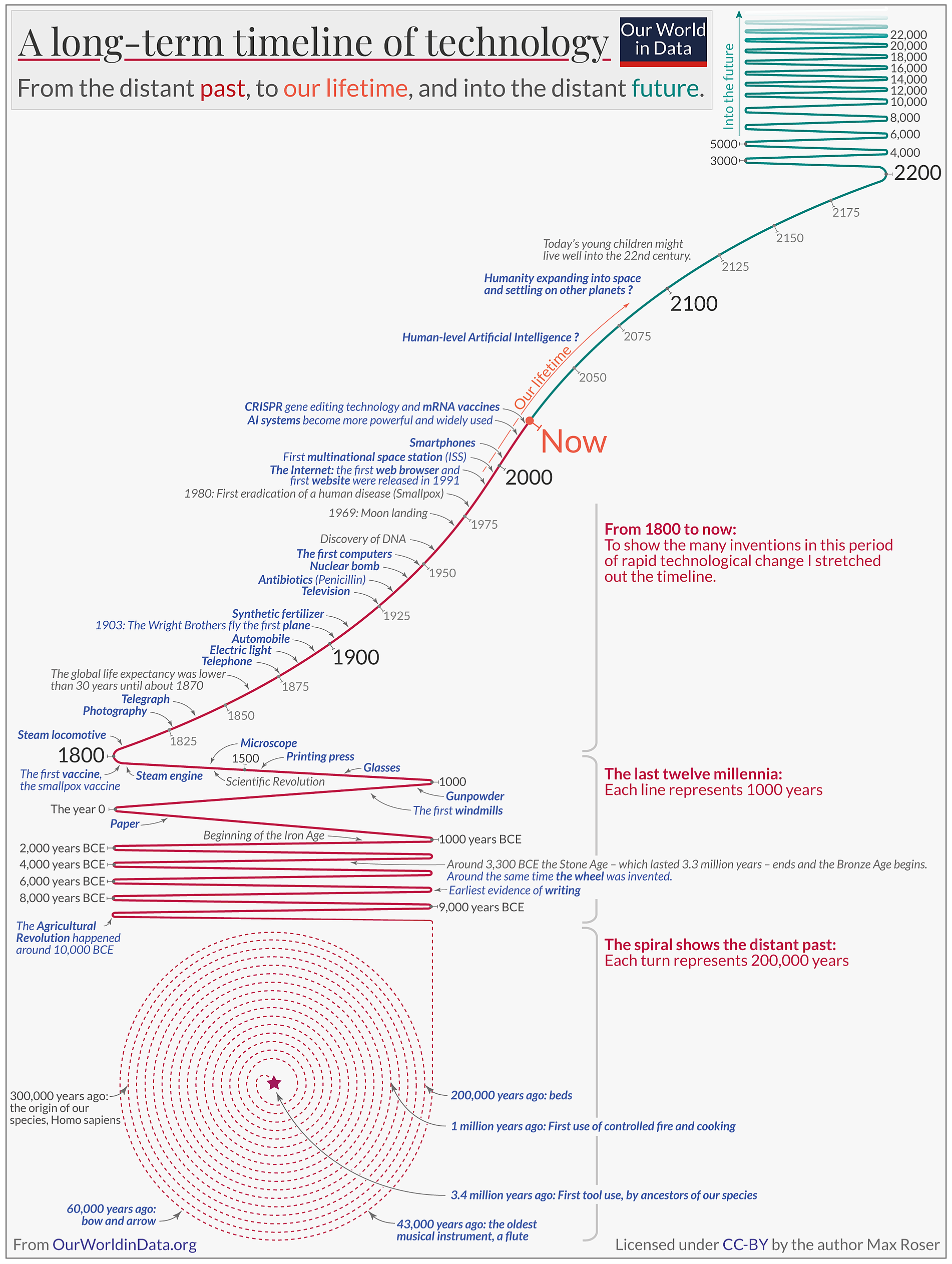Technology Invoked Change – Workshop 1 (Technology Development)

The Appleton Greene Corporate Training Program (CTP) for Technology Invoked Change is provided by Mr. Horrocks Certified Learning Provider (CLP). Program Specifications: Monthly cost USD$2,500.00; Monthly Workshops 6 hours; Monthly Support 4 hours; Program Duration 12 months; Program orders subject to ongoing availability.
If you would like to view the Client Information Hub (CIH) for this program, please Click Here
Learning Provider Profile

Mr Horrocks, M.SC, B.Eng., C.Eng. has had a long career dealing with technology in various industries beginning in his early years as an engineer with the application of computers to machine tools both in structural Analysis and automated tool changing. His development with technology has followed both the computer-based developments through CAD, CAM, CIM and robotics to materials such as carbon fibre and the use of lightweight metals. He has been in the vanguard of introducing critical technology applications, such as low-power lasers for aligning machine tools to applying visual simulation techniques for assessing manufacturing lines and warehouse design.
As the technology matured, Mr Horrocks moved from the technical design to implementation, exploring why seemingly good projects and technologies failed. This led to change management and the impact that technology has on both people and processes.
Mr Horrocks began his career in machine tools after taking a mechanical engineering degree and a master’s in machine tool technology, focusing on designing future machine tools, for example, replacing cast structures with fabricated ones. This is Mr Horrocks’s genuine interest and capability in analysis and using computer tools to provide data for decision-making. Mr Horrocks next career move was into production consulting, analysing, and improving production processes.
Gradually Mr Horrocks became engaged in computer systems for design, process planning, and commercial processes, covering designing new applications and supporting customers with their implementation. Implementation work developed from training on new transactions and data migration to helping the organisation through the required change. Again, this aligns well with Mr Horrocks’s natural disposition to create solid personal bonds, building strong customer trust.
• Depth of research
• Depth of experience
• Ability to relate customer situation to his experience.
• Anecdotal capability
• Simplifying tools and examples
• Good presentation skills
• Has undertaken the work personally within a wide range of industries and company profiles.
Mr Horrocks delivers engaging workshops and support materials; his rich tapestry of experience across different industries, company sizes, cultures, and ownerships enables him to relate to each client’s unique situation quickly. His style enables him to challenge management teams and proffer solutions when they appear stuck, changing the status quo. Mr Horrocks brings leading-edge tools that provide insights and vital decision-support information. Mr Horrocks has a lengthy mentoring background and is an experienced exponent of the art through online mediums.
MOST Analysis
Mission Statement
The programme’s mission is to
1. Embed a process within the organisation to effectively manage selecting, purchasing and implementing technology within the business.
2. Build the Competence of business leaders to identify technology, select appropriate vendors and manage their teams and vendors in its implementation.
3. Build communication and listening skills across the business so that the rationale for change and its benefits are fully understood, and buy-in is achieved with most staff.
4. Build support processes in areas such as horizon scanning.
5. Developing a project portfolio process that embraces not just the digital aspects in the process but those applied to sustainability and appropriate products/services, which might include
6. Provide a suite of tools and templates that speed up decision-making and remove any subjectivity.
7. Introduce key techniques that make the capturing, analysing and remodelling processes faster and easier to assimilate.
8. Promoting the concept that there is a need for a core team of staff across all levels of the business that are skilled in change tools and techniques
9. Developing the project and programme management capability to the point of establishing a Project Management Office for larger projects and continuing developments
10. Embedding a benefits assessment and monitoring process that operates with traditional return on investment analyses and can be tracked back to actions undertaken as part of the implementation and adoption of technology.
11. Implementing or improving the balanced scorecard approach to ensure the value of any technology is correctly measured, and plan adjustments can be implemented rapidly to effect the outcome.
Objectives
1. Improve the success ratio of technology programmes
Rationale
Most Technology implementation programmes need to deliver on their promised benefits or the company’s future vision; more than 60% cost more than the original budget and are completed late. Better use of capital and adoption of the proposed solution will reduce the stress at the senior management level, improve relationships with stakeholders, improve sustainability and enhance the customer experience.
2. The commitment of the senior management team
Rationale
Technology-driven transformation requires all senior management to speak the same language and articulate the same vision. Also, when the programme hits difficulties, they are as a team committed to finding solutions and combatting the inevitable resistance to change. They need to encourage collaboration at all levels and ensure that supporting the programme is career-enhancing.
3. Compelling Reason
Rationale
Without a compelling reason(s) for the programme and the inability to answer the question ‘why’, the programme will fail.
4. Metrics of success
Rationale
For each staff member, the ability to state what good looks like at all levels within the organisation, both corporately and at the personal level, will provide momentum to the programme. Using unambiguous metrics makes reporting and celebrating success much more accessible.
5. Creating a robust, repeatable process for technology programmes
Rationale
This is unlikely to be a one-off exercise. Therefore, enacting a proven process enables management to be flexible in resourcing and use projects as personal development opportunities without risking the quality of the outcomes.
6. Raising the appreciation of change and change management skill levels
Rationale
Change needs to be understood, and when it is forced on staff is never well accepted and is unlikely to be self-sustaining. Awareness of change, answering the What is in it for Me question and enabling all staff to contribute where possible. Extensive training and career opportunities, plus rewarding success, are fundamental. Engaging Change Agents internally to undertake change actions and communicate with co-workers can be transformative.
7. Change the perception and acceptance of benefits to drive change
Rationale
In many transformations, senior executives are sceptical that benefits are just a marketing exercise to sell the project but are unattainable; alternatively, they are used by finance to pressure operational management. Engaging in the cross-functional assessment of benefits, which provides a sight of the full value available but also recognises that this will not be a single target, keeps all management onside.
8. Developing a deeper understanding of processes
Rationale
Applying any technology requires a deep understanding of the process, not just at the transactional level but as an overall operating model. The detail is essential as this highlights stories of waste in redundant and duplicated activities, mismatch of business rules across departmental boundaries and the extent of personal systems and data sources by visual models that can be shared at all levels with the detail defined by front-line staff, managers, and executives, a better level of understanding the of the impact of poor process design. All technology will be implemented at a process level.
9. Resolving the departmental end-to-end process dichotomy
Rationale
Organisations have evolved through the application of command-and-control theory. Managers are asked to manage a skilled resource, the process scope being the conversion of inputs from other departments, customers or suppliers into an output. Their responsibility is to manage the attendance and development of the team to make it capable of functioning to metrics defined within the department. These metrics maybe make the end-to-end processes they are part of sub-optimal. Helping departmental managers understand their responsibility to the end-to-end process and aligning the performance measures accordingly will be fundamental to any transformation.
10. Understanding that robust support processes are required
Rationale
Technological change still involves the staff in the organisation and requires good underlying IT Infrastructure. Therefore, the support provided by HR and IT needs to be best in class, whether supplied through internal staff, external suppliers or a hybrid. The processes and metrics must engage with the strategic elements in the balanced scorecard organisational capability, which is two-fold, cultural and knowledge-base and IT capability. Processes such as IT security, hardware provision, Training, reward, remuneration, and appraisals must align with future business requirements.
Strategies
1. Improve the success ratio of technology programmes.
1.1 Rationale
Most Technology implementation programmes must deliver on their promised benefits or the company’s future vision; more than 60% cost more than the original budget and are completed late. Better use of capital and adoption of the proposed solution will reduce the stress at the senior management level, improve relationships with stakeholders, improve sustainability and enhance the customer experience.
1.2 Strategy
Educate and validate the understanding of all key stakeholders regarding what technology is being employed, what impacts are likely, what mitigating actions can be taken and how planning and monitoring will be fundamental. The business must own the project and be prepared to make difficult decisions during the implementation.
2. The commitment of the senior management team
2.1 Rationale
Technology-driven transformation requires all senior management to speak the same language and articulate the same vision. Also, when the programme hits difficulties, they are as a team committed to finding solutions and combatting the inevitable resistance to change. They need to encourage collaboration at all levels and ensure that supporting the programme is career-enhancing.
2.2 Strategy
Senior management develops the future vision using simple tools such as the Customer Value proposition and the Business Model Canvas, collaborating as a team. Each executive and manager is trained to articulate this vision from a business and staff perspective using their own words but promoting a core message. Active listening and providing counterarguments to staff members will be encouraged.
3. Compelling Reason
3.1 Rationale
Without a compelling reason(s) for the programme and the inability to answer the question ‘why’, the programme will fail.
3.2 Strategy
Building the new business and operating models will need research to support the need for change. Presenting this as a business case will align the issues needing to be addressed with the planned actions, including training, personal development and new career opportunities.
4. Metrics of success
4.1 Rationale
The ability to state what good looks like at all levels within the organisation, corporately and personally, for each staff member will provide momentum to the programme. Using unambiguous metrics makes reporting and celebrating success much more accessible.
4.2 Strategy
Starting with the balanced scorecard and a generic set of KPIs, we will build or refresh the existing business metrics. We will seek to balance the usual lagging financial indicators with more leading ones for customers and internal processes. We will also encourage using measures for organisational capability covering culture and innovation, IT capability covering infrastructure, security management, paperless reporting and mobile device management.
5. Creating a robust, repeatable process for technology programmes
5.1 Rationale
This is unlikely to be a one-off exercise. Therefore, enacting a proven process enables management to be flexible in resourcing and use projects as personal development opportunities without risking the quality of the outcomes.
5.2 Strategy
We will discuss the process steps offered in the course and modify this to suit the company’s situation. We will examine the present processes employed to manage any technological application and redesign it where necessary. The course will encourage establishing partners with research organisations and trade bodies. During the period, we will test the quality of any redesign and modify it accordingly, ensuring that we have applied suitable metrics to monitor performance easily.
6. Raising the appreciation of change and change management skill levels
6.1 Rationale
Change needs to be understood, and when it is forced on staff is never well accepted and is unlikely to be self-sustaining. Awareness of change, answering the What is in it for Me question and enabling all staff to contribute where possible. Extensive training and career opportunities, plus rewarding success, are fundamental. Engaging Change Agents internally to undertake change actions and communicate with co-workers can be transformative.
6.2 Strategy
We will provide routes for all staff to engage in change, from those very keen to those who do not relish the thought—starting with extensive communication sessions backed up with one-to-one or group questions and answer sessions. Online training on fundamental change management skills will be implemented, and a process to identify and train change agents is expected. Success and failure will be recognised, and in the latter case, lessons learned will be documented and shared.
For those members of staff that cannot manage the change within the organisation, the programme will anticipate that alternatives are offered, such as redundancy or support to find alternative employment.
7. Change the perception and acceptance of benefits to drive change.
7.1 Rationale
In many transformations, senior executives are sceptical that benefits are just a marketing exercise to sell the project but are unattainable; alternatively, they are used by finance to pressure operational management. Engaging in the cross-functional assessment of benefits, which provides a sight of the total value available but also recognises that this will not be a single target, keeps all management onside.
7.2 Strategy
The basis of the benefits assessment will be the executive assessment process. Within this process, we categorise benefits into three impacts Displaced Costs (one-off benefits mainly), Increased Productivity and Increased Revenue. We then apply a degree of difficulty of implementation (High, Medium and Low), which relates to the level of control the company has in implementing the change; for example, the likely level of internal resistance or, in the case of revenue, the level of influence the company has over customers. Each degree of difficulty applies a different percentage to the total value of the benefit. Splitting the benefit across all three degrees of difficulty in any category is possible. Having identified the total benefit value and a more ‘realistic’ value, these values can be further modified by applying Control System Theory. This theory states that when applying any measure to monitor a process, you must allow for natural variation, meaning the initial value will have an upper and lower limit. Using this theory, we avoid the single-figure measurement and fail when it is not achieved. So managers are more committed to achieving it. It also lets us practice celebrating successes when the realistic or more optimistic target is hit but not class a failure when the measure dips one month.
8. Developing a deeper understanding of processes
8.1 Rationale
Applying any technology requires a deep understanding of the process, not just at the transactional level but as an overall operating model. The detail is essential as this highlights stories of waste in redundant and duplicated activities, mismatch of business rules across departmental boundaries and the extent of personal systems and data sources. It uses visual models that can be shared at all levels with the detail defined by front-line staff, managers, and executives, understanding the impact of poor process design. All technology will be implemented at a process level.
8.2 Strategy
Process Modelling and Management is an expensive and long-winded activity requiring specialists to perform or document. The resulting documents are used once and are challenging to maintain. We demonstrate that these issues have been addressed with technology such as collaborative tools and digital twin business modelling tools. We examine the relationship between ‘What’ the company does and ‘How’ it delivers. We use the parent-child concept to break down the core processes that the company employs through three levels; to develop the ‘What’ picture. The core processes will be selected from an internationally recognised set of process descriptions and scope.
This work is one with senior executives, managers and process staff. Once these first three levels are agreed upon, we work with managers and process staff to define the following two levels of “How’ the company conducts these processes. At this level, we can examine business rules that orchestrate the process, who does it, its effectiveness and the systems applied. Collaborative tools allow these meetings to be more easily managed and the results shared. They are enabling staff from different locations to be involved with less impact on their daily routine.
During this work, we ensure that the right level of understanding is achieved at every level of the company enabling senior executives and managers to make robust decisions on process change.
Supporting the collaborative approach to process modelling with electronic whiteboards and post-it notes, we will build a digital twin of the processes to examine how employing this technology moves the management of processes further, enabling:
• Lean and Customer Experience Analysis
• ASIS and TOBE comparisons
• System Rationalisation
• Organisational design
• Low-Code or No-code system implementations
9. Resolving the departmental end-to-end process dichotomy
9.1 Rationale
Organisations have evolved through the application of command-and-control theory. Managers are asked to manage a skilled resource, the process scope being the conversion of inputs from other departments, customers or suppliers into an output. Their responsibility is to manage the attendance and development of the team to make it capable of functioning to metrics defined within the department. These metrics maybe make the end-to-end processes they are part of sub-optimal. Helping departmental managers understand their responsibility to the end-to-end process and aligning the performance measures accordingly will be fundamental to any transformation.
9.2 Strategy
We are implementing technology that will cross departmental boundaries and improve end-to-end processes. Cutting across the ‘silos’ that are departments requires the next level of understanding of the process. To do this, we analyse the handover issues across the boundaries, such as;
• Duplication of work
• Conflict of differing business rules
• Creation of additional data sources (re-entry of data)
• Sub-optimisation of overall process performance
We will examine these issues and ensure that the technology is aimed at removing them. End-to-End process metrics are then deployed to the departmental activities undertaken to perform the process. These are then compared to existing measures and changes made where appropriate.
Conflicts in business rules will be discussed, and new rules will be developed to suit the end-to-end perspective.
10. Understanding that robust support processes are required.
10.1 Rationale
Technological change still involves the staff in the organisation and requires good underlying IT Infrastructure. Therefore, the support provided by HR and IT needs to be best in class, whether supplied through internal staff, external suppliers or a hybrid. The processes and metrics must engage with the strategic elements in the balanced scorecard organisational capability, which is two-fold, cultural and knowledge-base and IT capability. Functions such as IT security, hardware provision, Training, reward and remuneration and appraisals must align with the requirements of the future business.
10.2 Strategy
An initial capability maturity assessment will identify the status of the processes. Metrics will be set to these processes and be captured in the balanced scorecard. The evaluation will determine the performance gaps, and we will define a couple of projects focused on HR and IT to run in parallel with the technology project(s). If HR is provided through internal resources, we will examine ways in which HR advisors and L&D staff can become an integral part of the change team; in areas such as communications and training in skills such as lean, problem-solving and presentations.
Tasks
1 Improve the success ratio of technology programmes.
1.1 Rationale
Most Technology implementation programmes must deliver on their promised benefits or the company’s future vision; more than 60% cost more than the original budget and are completed late. Better use of capital and adoption of the proposed solution will reduce the stress at the senior management level, improve relationships with stakeholders, improve sustainability and enhance the customer experience.
1.2 Strategy
Educate and validate the understanding of all key stakeholders regarding what technology is being employed, what impacts are likely, what mitigating actions can be taken and how planning and monitoring will be fundamental. The business must own the project and be prepared to make difficult decisions during the implementation.
Tasks
• Conduct Stakeholder Assessment
• Conduct Individual awareness sessions
• Technology Impact Assessment
• Develop Project Portfolio
• Sign up for the Senior Management Charter
2 The commitment of the senior management team
2.1 Rationale
Technology-driven transformation requires all senior management to speak the same language and articulate the same vision. Also, when the programme hits difficulties, they are as a team committed to finding solutions and combatting the inevitable resistance to change. They need to encourage collaboration at all levels and ensure that supporting the programme is career-enhancing.
2.2 Strategy
Senior management develops the future vision using simple tools such as the Customer Value proposition and the Business Model Canvas, collaborating as a team. Each executive and manager is trained to articulate this vision from a business and staff perspective using their own words but promoting a core message. Active listening and providing counterarguments to staff members will be encouraged.
Tasks
• Conduct Customer Value Proposition Workshops
• Develop Business model Vision using Business Model Canvas
• Conduct one-to-one and group presentation sessions
• Monitor management communications sessions
• Provide Training for managers to communicate better or undertake active listening.
3 Compelling Reason
3.1 Rationale
Without a compelling reason(s) for the programme and the inability to answer the question ‘why’, the programme will fail.
3.2 Strategy
Building the new business and operating models will need research to support the need for change. Presenting this as a business case will align the issues needing to be addressed with the planned actions, including training, personal development and new career opportunities.
Tasks
• Build a business case to support the future vision
• The business case to cover corporate and personal benefits and changes
• Outline project outline and supporting activities such as training and IT infrastructure developments.
4 Metrics of success
4.1 Rationale
The ability to state what good looks like at all levels within the organisation, corporately and personally, for each staff member will provide momentum to the programme. Using unambiguous metrics makes reporting and celebrating success much more accessible.
4.2 Strategy
Starting with the balanced scorecard and a generic set of KPIs, we will build or refresh the existing business metrics. We will seek to balance the usual lagging financial indicators with more leading ones for customers and internal processes. We will also encourage using measures for organisational capability covering culture and innovation, IT capability covering infrastructure, security management, paperless reporting and mobile device management.
Tasks
• Review existing or build a new balanced scorecard
• Populate with existing KPIs, where available
• Run a workshop to select new or additional KPIs based on a generic set or other sources.
• Define a potential benchmarking partner, enter an information-sharing agreement, or join a benchmarking service.
• Add new KPIs for all sections of the balanced scorecard and set targets.
5 Creating a robust, repeatable process for technology programmes
5.1 Rationale
This is unlikely to be a one-off exercise. Therefore, enacting a proven process enables management to be flexible in resourcing and use projects as personal development opportunities without risking the quality of the outcomes.
5.2 Strategy
We will discuss the process steps offered in the course and modify this to suit the company’s situation. We will examine the present processes employed to manage any technological application and redesign it where necessary. The course will encourage establishing partners with research organisations and trade bodies. During the period, we will test the quality of any redesign and modify it accordingly, ensuring that we have applied suitable metrics to monitor performance easily.
Tasks
• Discuss and develop the proposed process.
• Examine all existing processes that are being used to manage technology projects.
• Decompose the proposed process down to the activity and task levels
• Set out the business rules and business roles
• Identify any research partners and seek cooperation agreements
• Set out process metrics, monitor and adjust processes during the project
6 Raising the appreciation of change and change management skill levels
6.1 Rationale
Change needs to be understood, and when it is forced on staff is never well accepted and is unlikely to be self-sustaining. Awareness of change, answering the What is in it for Me question and enabling all staff to contribute where possible. Extensive training and career opportunities, plus rewarding success, are fundamental. Engaging Change Agents internally to undertake change actions and communicate with co-workers can be transformative.
6.2 Strategy
We will provide routes for all staff to engage in change, from those very keen to those who do not relish the thought—starting with extensive communication sessions backed up with one-to-one or group questions and answer sessions. Online training on fundamental change management skills will be implemented, and a process to identify and train change agents is expected. Success and failure will be recognised, and in the latter case, lessons learned will be documented and shared.
For those members of staff that cannot manage the change within the organisation, the programme will anticipate that alternatives are offered, such as redundancy or support to find alternative employment.
Tasks
• Conduct a series of communications sessions, beginning with a company-wide one, followed by departmental, then one-to-one sessions, at each decomposing the impact from corporate to department to individual.
• Support the face-to-face with additional communications such as videos and newsletters.
• Contact critical suppliers and customers again with both face-to-face and other media.
• Discuss individual action plans and timelines for implementation, including help with leaving the business if that is the result of these consultations.
• Communicate through all media successes of the programme and operate workshops to discuss failures and document lessons learned for the remaining and future programmes.
7 Change the perception and acceptance of benefits to drive change.
7.1 Rationale
In many transformations, senior executives are sceptical that benefits are just a marketing exercise to sell the project but are unattainable; alternatively, they are used by finance to pressure operational management. Engaging in the cross-functional assessment of benefits, which provides a sight of the total value available but also recognises that this will not be a single target, keeps all management onside.
7.2 Strategy
The basis of the benefits assessment will be the executive assessment process. Within this process, we categorise benefits into three impacts Displaced Costs (one-off benefits mainly), Increased Productivity and Increased Revenue. We then apply a degree of difficulty of implementation (High, Medium and Low), which relates to the level of control the company has in implementing the change; for example, the likely level of internal resistance or, in the case of revenue, the level of influence the company has over customers. Each degree of difficulty applies a different percentage to the total value of the benefit. Splitting the benefit across all three degrees of difficulty in any category is possible. Having identified the total benefit value and a more ‘realistic’ value, these values can be further modified by applying Control System Theory. This theory states that when applying any measure to monitor a process, you must allow for natural variation, meaning the initial value will have an upper and lower limit. Using this theory, we avoid the single-figure measurement and fail when it is not achieved. So managers are more committed to achieving it. It also lets us practice celebrating successes when the realistic or more optimistic target is hit but not class a failure when the measure dips one month.
Tasks
• Conduct a senior management workshop to discuss benefits and explore the use of the assessment tool.
• Set out the business process model, define each technology project’s impact, and map it to the relevant projects.
• Calculate the overall benefit and apply the category and degree of difficulty to each one to create the rationalised value.
• Conduct workshops to apply upper and lower limits to each rationalised value.
• Produce monitoring template
8 Developing a deeper understanding of processes
8.1 Rationale
Applying any technology requires a deep understanding of the process, not just at the transactional level but as an overall operating model. The detail is essential as this highlights stories of waste in redundant and duplicated activities, mismatch of business rules across departmental boundaries and the extent of personal systems and data sources. It uses visual models that can be shared at all levels with the detail defined by front-line staff, managers, and executives, understanding the impact of poor process design. All technology will be implemented at a process level.
8.2 Strategy
Process Modelling and Management is an expensive and long-winded activity requiring specialists to perform or document. The resulting documents are used once and are challenging to maintain. We demonstrate that these issues have been addressed with technology such as collaborative tools and digital twin business modelling tools. We examine the relationship between ‘What’ the company does and ‘How’ it delivers. We use the parent-child concept to break down the core processes that the company employs through three levels; to develop the ‘What’ picture. The core processes will be selected from an internationally recognised set of process descriptions and scope.
This work is one with senior executives, managers and process staff. Once these first three levels are agreed upon, we work with managers and process staff to define the following two levels of “How’ the company conducts these processes. At this level, we can examine business rules that orchestrate the process, who does it, its effectiveness and the systems applied. Collaborative tools allow these meetings to be more easily managed and the results shared. They are enabling staff from different locations to be involved with less impact on their daily routine.
During this work, we ensure that the right level of understanding is achieved at every level of the company enabling senior executives and managers to make robust decisions on process change.
Supporting the collaborative approach to process modelling with electronic whiteboards and post-it notes, we will build a digital twin of the processes to examine how employing this technology moves the management of processes further, enabling:
• Lean and Customer Experience Analysis
• ASIS and TOBE comparisons
• System Rationalisation
• Organisational design
• Low-Code or No-code system implementations
Tasks
• Agree on a high-level Process model based on the “what’ and ‘how’ process breakdown.
• Breakdown the processes at level 3 into detailed sub-processes and activities using cross-functional teams
• Conduct a capability maturity assessment, produce a gap analysis
• Using the gap analysis as a steer for the cross-functional workshops, explore the reasons behind the gap; using Lean and customer experience tools, explore waste such as redundant or duplicate activity, poor business rules and multiple data sources
• Create TOBE process models based on re-engineering the ASIS
• Review the use of digital twinning and agree on a strategy for the future.
9 Resolving the departmental end-to-end process dichotomy
9.1 Rationale
Organisations have evolved through the application of command-and-control theory. Managers are asked to manage a skilled resource, the process scope being the conversion of inputs from other departments, customers or suppliers into an output. Their responsibility is to manage the attendance and development of the team to make it capable of functioning to metrics defined within the department. These metrics maybe make the end-to-end processes they are part of sub-optimal. Helping departmental managers understand their responsibility to the end-to-end process and aligning the performance measures accordingly will be fundamental to any transformation.
9.2 Strategy
We are implementing technology that will cross departmental boundaries and improve end-to-end processes. Cutting across the ‘silos’ that are departments requires the next level of understanding of the process. To do this, we analyse the handover issues across the boundaries, such as;
• Duplication of work
• Conflict of differing business rules
• Creation of additional data sources (re-entry of data)
• Sub-optimisation of overall process performance
We will examine these issues and ensure that the technology is aimed at removing them. End-to-End process metrics are then deployed to the departmental activities undertaken to perform the process. These are then compared to existing measures and changes made where appropriate.
Conflicts in business rules will be discussed, and new rules will be developed to suit the end-to-end perspective.
Tasks
• The outcomes of the end-to-end process analysis are presented to the departmental managers to discuss solutions and agree on actions to improve processes before any technology introduction.
– Remove unnecessary activities
– Remove personal uncontrolled data sources
– Implement management mandates to seek a single source of data
– Redesign business rules
• Document new business rules and communicate to staff
10 Understanding that robust support processes are required.
10.1 Rationale
Technological change still involves the staff in the organisation and requires good underlying IT Infrastructure. Therefore, the support provided by HR and IT needs to be best in class, whether supplied through internal staff, external suppliers or a hybrid. The processes and metrics must engage with the strategic elements in the balanced scorecard organisational capability, which is two-fold, cultural and knowledge-base and IT capability. Functions such as IT security, hardware provision, Training, reward and remuneration and appraisals must align with the requirements of the future business.
10.2 Strategy
An initial capability maturity assessment will identify the status of the processes. Metrics will be set to these processes and be captured in the balanced scorecard. The evaluation will determine the performance gaps, and we will define a couple of projects focused on HR and IT to run in parallel with the technology project(s). If HR is provided through internal resources, we will examine ways in which HR advisors and L&D staff can become an integral part of the change team; in areas such as communications and training in skills such as lean, problem-solving and presentations.
Tasks
• Using the outcome of the capability maturity matrix for the support processes in HR and IT, undertake a workshop to determine potential solutions.
– Use of external resources to fit skills gap
– Introduce new capabilities such as online training
– Developing present staff to undertake different roles, such as trainers or mentors
• Redesign reward and remuneration system to enable recognition of upskilling and support of any change initiative.
• Present revised departmental structure and capabilities to senior management
Introduction
To be advised.
Executive Summary
Chapter 1: Technology Development
Understanding the history of technological development and the associated issues that its implementation always brings will enable workshop attendees to put the change required and the speed of technological development into perspective. The Digital Age seems to be creating both potential lifestyle improvements and threats. We examine the top 5 critical technologies seen today from Gene Therapy through autonomous vehicles and AI not from the science and technical perspective but from a societal viewpoint.
We were exploring how the world of work has changed for a few job roles that were promising careers less than 20 years ago, viewing this from the person who performed the function to the impact on the person receiving that service through a technological solution. We look at how the technologies continued developing and how the change was communicated to staff and consumers.

Chapter 2: Development Cycles
Technology has a well-documented development cycle beginning with an idea, building prototypes, Testing and validating and then implementing. Whether you are buying technology to implement in your own company or developing technology to apply to your processes or deliver to your customers, understanding the position in the cycle is vital.
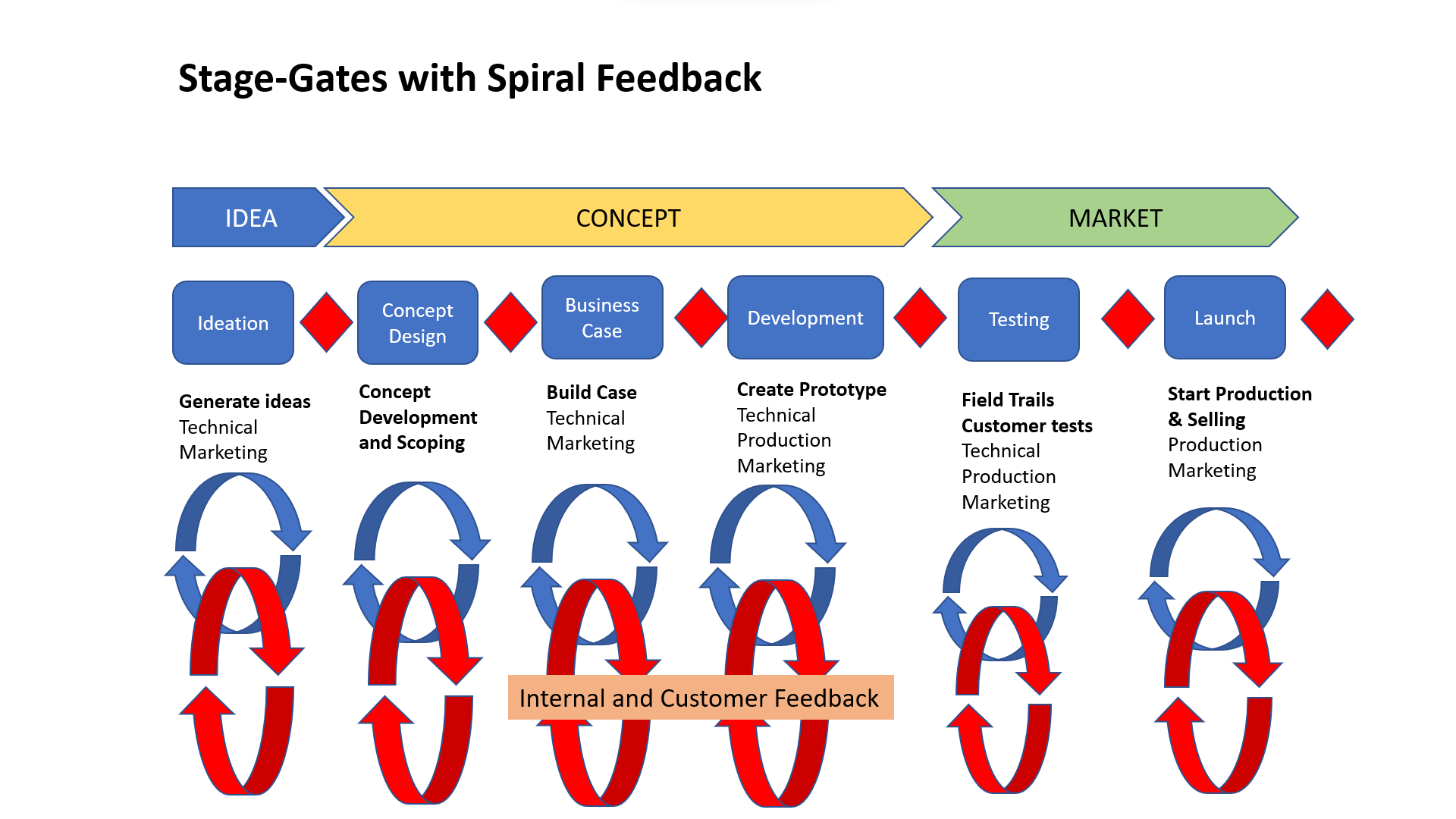
We will review technology’s success and failure at a technical and marketing level through several examples. We track developments such as business information systems, from managing customer and supplier information through mathematical automation to full-blown process automation. In this case, for example, we will demonstrate that the genesis of a variation of technology such as ERP can explain why it is designed in a particular way and why this might be important in a selection process.

Chapter 3: Technology adoption
Technology adoption has been studied extensively. The Technology Adoption curve espoused by Everett M Rogers asserts that five sociological groups respond differently to technology and innovation. This approach is applied broadly when companies are researching new products and services. We will explore how this framework can implement technology within a business and with consumers.
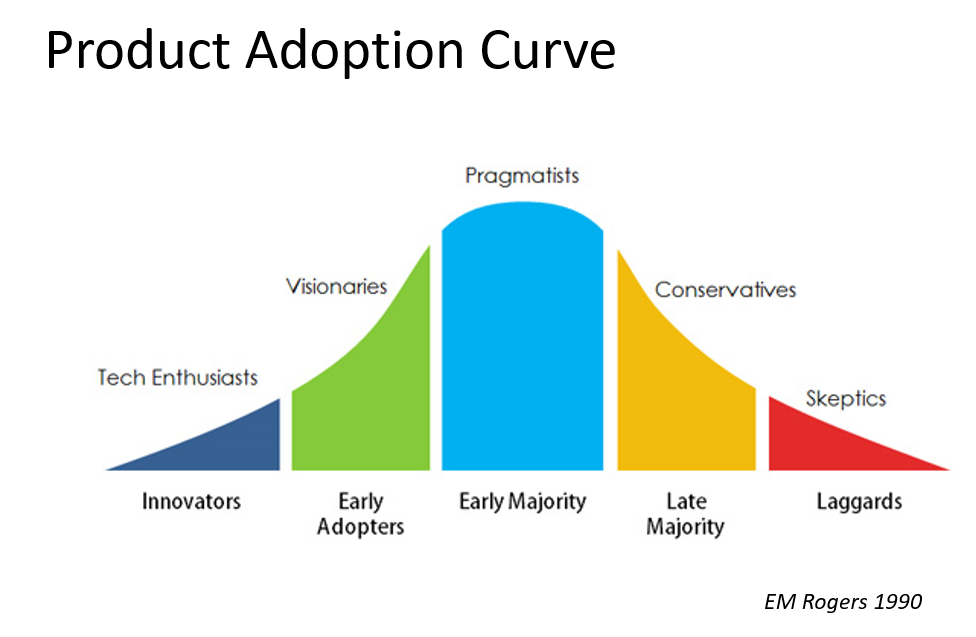
Source: New Product Adoption and Diffusion Curve Everett.M.Rogers 1976
The Adoption curve was developed from work completed on the diffusion of innovation within agriculture in the 50s and 60s. The five groups split into innovators and early adopters, about 16% of your staff, and the rest, whom we call the pragmatists. Getting buy-in to any technology and associated change is called ‘crossing the chasm’, and we discuss how we design the project team and support it to enable it to rise to this challenge.

Chapter 4: Societal Impacts
Ancient and modern civilisations have been closely involved with innovations, inventions and engineering applications to help them perform tasks and impact their lives. This has become a co-dependent relationship of co-influence and co-production (By DJ Wardynski 2019). This can be seen in the two primary cycles, Agricultural and Progressive, covering the industrial revolution. Technologies determine the economy of a society under the agricultural cycle and therefore are closely intertwined. The progressive process has enabled more diverse economies and societal novelties, such as a more interconnected world and globalisation.
All technology impacted society and helped coin the phrase ‘necessity is the mother of invention’; therefore is created to meet the community’s needs and is closely coupled to culture and populace behaviours. This becomes a cycle where technology changes behaviours and the operations of society, which might cause more problems, different economic structures, and new ways of life, leading to the requirement for new technology.
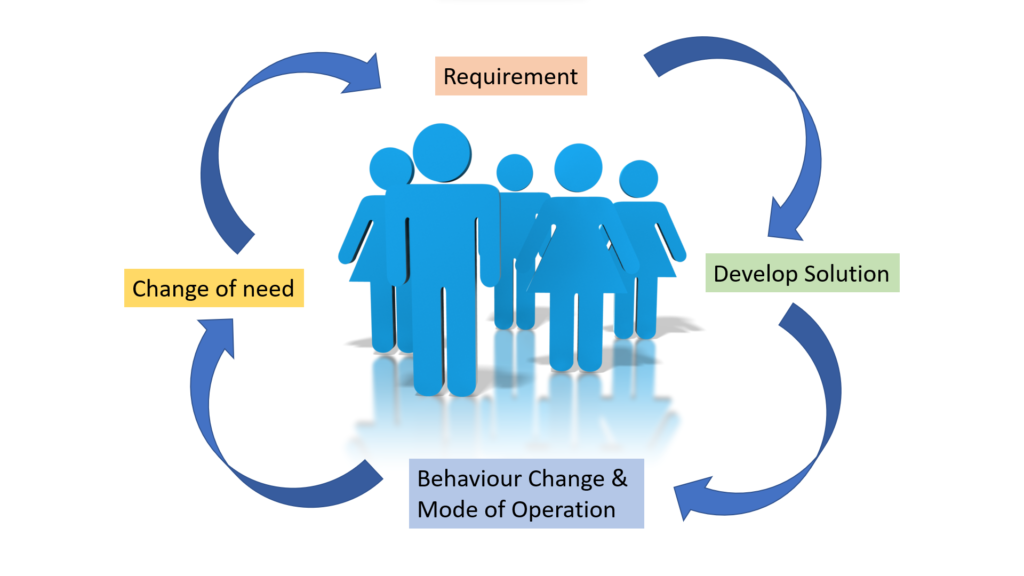
Technology has positively affected human development, making it easier to farm, more feasible to build cities, and more convenient to travel. We look at both the positive and negative impacts. On the positive side, we can look at the mechanisation of agriculture and improvements in transportation, communication, and education. On the negative side, it has led to the depletion of resources, population increase impacting food resources and additional health concerns, and finally, increased pollution.
We will examine topics such as the impact on lifestyle through greater convenience, smart devices helping to manage population health, the need for data privacy, the growth of cybercrime, and the different attitudes to all digital technology from the youth.

Chapter 5: The Planet
We investigate technology’s impact on the planet. Specifically, those technologies help tackle climate change. This will cover the following topics.
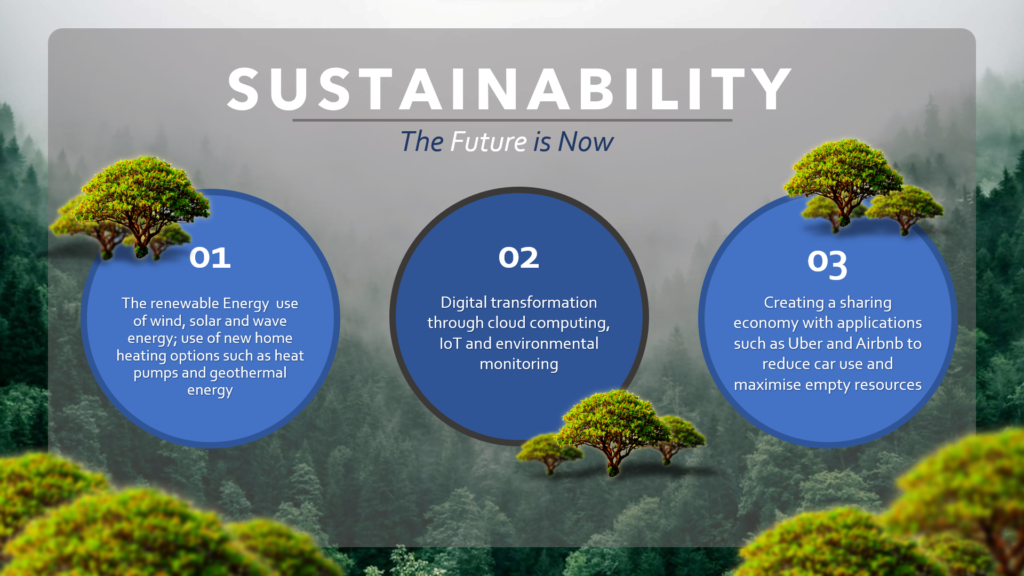
• Renewable Energy uses resources such as wind, solar and wave energy; we will look at how governments apply taxes to these types of generation and the subsequent impact on industrial and domestic consumers. Comparing the alternative ‘carrot’ and ‘stick approach to encouraging change in behaviour
• Digital transformation in its various forms, such as cloud computing and data management,
• Environmental monitoring By applying digital devices from drones to the geospatial measuring of air pollution, authorities can effectively monitor areas impacted by individuals and corporations.
• Sharing Economy uses digital technology to connect, transport, and deliver customer items. Typical examples are Uber and AirBnB. Uber makes it easier for people to get around without a car, whilst AirBnB facilitates using underused spaces.
• More innovative Homes are applying digital devices within the home to support better decision-making on energy use. This includes monitoring devices and connecting individual items such as controllers and white goods to the internet to enable consumers to control these devices outside the home.
• Alternative home heating options include moving from gas burning to heat pumps or geothermal energy.

Chapter 6: Business Sustainability
Looking at technology from a sustainability point of view covers some applications such as the Internet of Things, inter-connection of multiple devices through the Internet and renewable energy applied to individual businesses. We investigate progress in energy storage which, alongside energy generation from natural sources, can be unpredictable and presently requires assets to be switched off and generators compensated.
Big data analytics can help companies better understand their ecological impact, such as their energy use. Technology has been applied to make food production more local, reducing the carbon footprint of transporting produce. Vertical and indoor farms can offset the need to reduce the use of precious land.
Carbon Data Transparency uses technology to enable carbon accounting across the value chain. This includes Blockchain and IoT, making data available to all stakeholders across the end-to-end process and facilitating better decision-making.
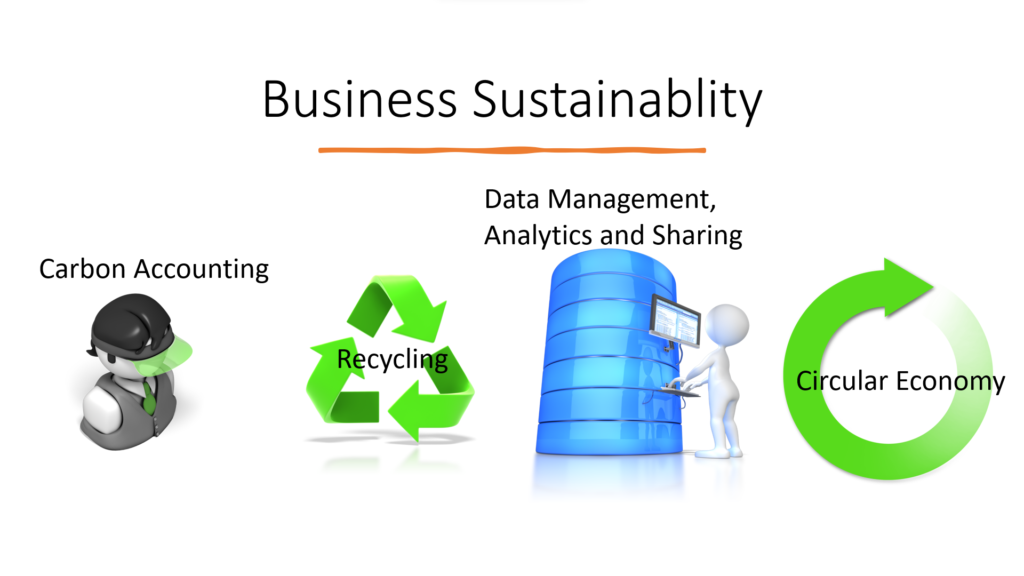
Designing Circular Products and Services is being facilitated by technology; we review the impact of technology in areas such as packaging technology and the addition of returnable packaging as part of delivery services.
Data Ecosystems sharing Adopting cross-industry data-sharing ecosystems that are enabling compliance with sustainability regulations.
Data ecosystems provide valuable, shared, real-time insights into a product or service’s environmental and societal impacts. All while allowing organisations to meet their sustainability targets and compliance goals.
Sustainability also reaches into sourcing, using standards such as Ethical Trading to avoid poor trading practices in suppliers being allowed to perpetuate.

Chapter 7: Business transformation
In this part of the workshop, we will examine technologies to transform how we perform business from robotics to integrated systems. The business data did the same as the industry evolved and became more complex, with organisations growing to cover the increasing number of specialisms. Each department managed its data. Initially, this management was done on paper and filing cabinets; as personal tools and digital filing systems grew, this was based on computer storage. The advent of personal computers led to even greater fragmentation of the company’s data sources. Add to this the variety of computer manufacturers and operating systems combining and managing this data became a massive headache.
This led to the term ‘legacy’ systems, which in some industries is still a significant problem, for example, in Banks, where consumers’ expectations of service levels regarding transparency, flexibility and agility have only recently been addressed. We will examine the introduction of databases to provide a single source of the truth; Big Data provides flexibility in analytics, automation of processes from Robotic Process Automation, removing simple manual tasks, Business Process Automation used in the automation of complete functions such as application forms and finally systems integration combining several end-to-end processes to provide a more streamlined operation.
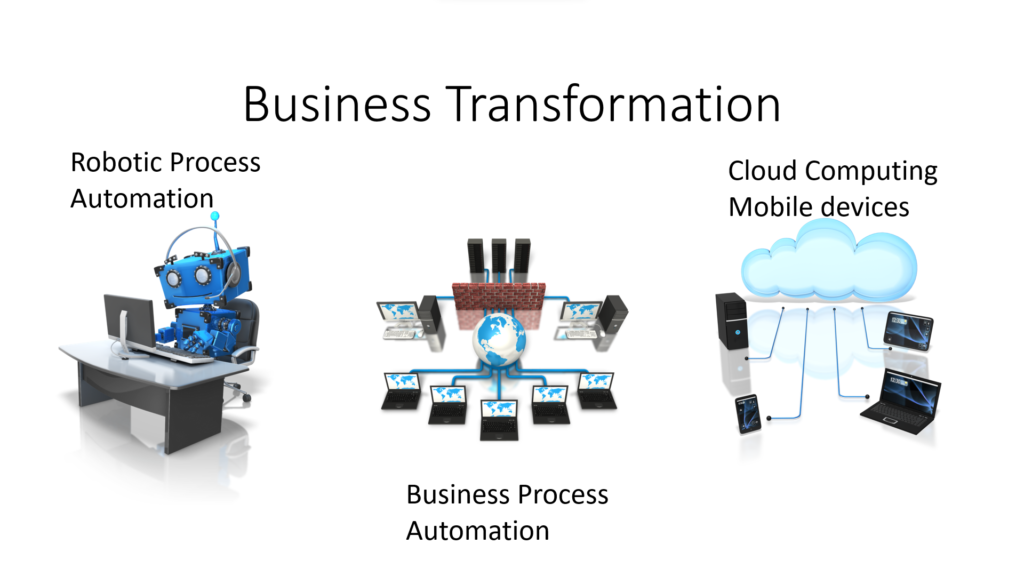
As the level of capability in handheld and personal devices has exploded, we will look at the impact on Human-Computer Interface design and the degree of change possible for consumers and businesses alike.
Technologies can enable significant change, which we accept as more accessible in our personal lives but find more difficult in the workplace. We examine this natural reaction and are ready for more detailed discussion in later workshops. Also, review the areas of focus that are emerging now, such as;
• Process Optimisation and digitisation
• Self-service
• Networking & Communications
• Monitoring & Tracking
• Analysing and forecasting

Chapter 8: Business Models
Technology enabled transformation, and the increasing commodification of hardware and software has allowed mature businesses to change their business models and for new companies to challenge the existing players.
Simple changes include the provision of portals for suppliers and customers to interact with the company directly for tracking deliveries, selecting and paying for goods and services and submitting invoices for payment. These innovations combine several technologies, such as websites, robotic process automation and big data analytics. For mature businesses, this will enable the streamlining of internal operations, moving staff to more value-added tasks; or making processes previously considered not cost-effective to be redesigned. In this category, the ability for systems to manage subscriptions easily, making monthly contributions easy to operate and sell.
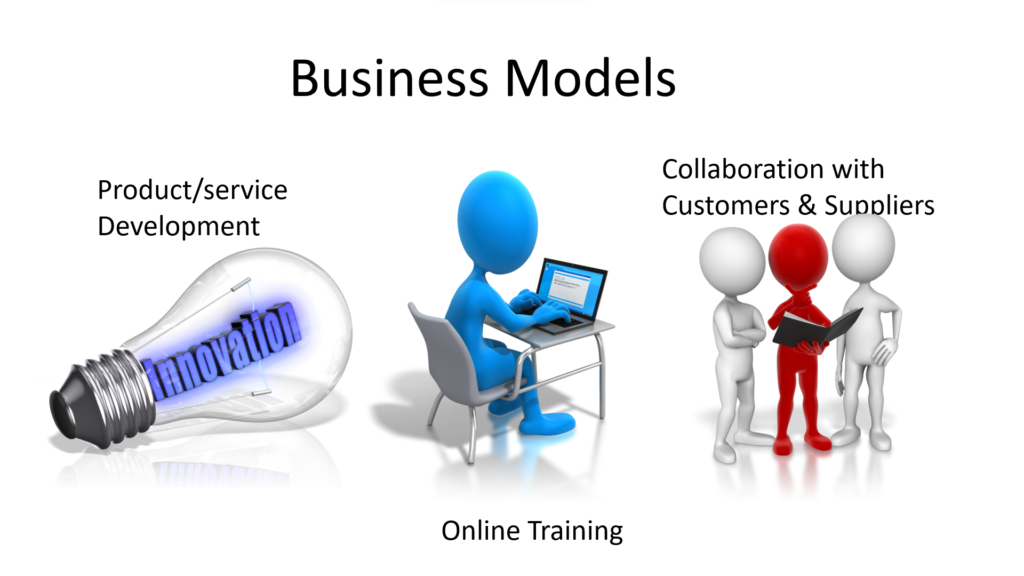
We look at the rise and impact of online training from traditional e-learning and certification to the latest conversational learning capabilities using messaging technology.
Finally, we examine the growth in the delivery of health services, from access to personal records to prescription ordering and ongoing monitoring services.

Chapter 9: Change Management
Since the dawn of the industrial revolution, technology-led change has been required. For example, steam-enabled transport and industrial operations processes were seen as improving life and were often supported with broad civilian good works such as housing or bathhouses. But the reaction to change is a natural response, mainly if it is seen as enforced. The early technology implementors made grand gestures such as those mentioned so that the change, though executed, was seen in a positive light.
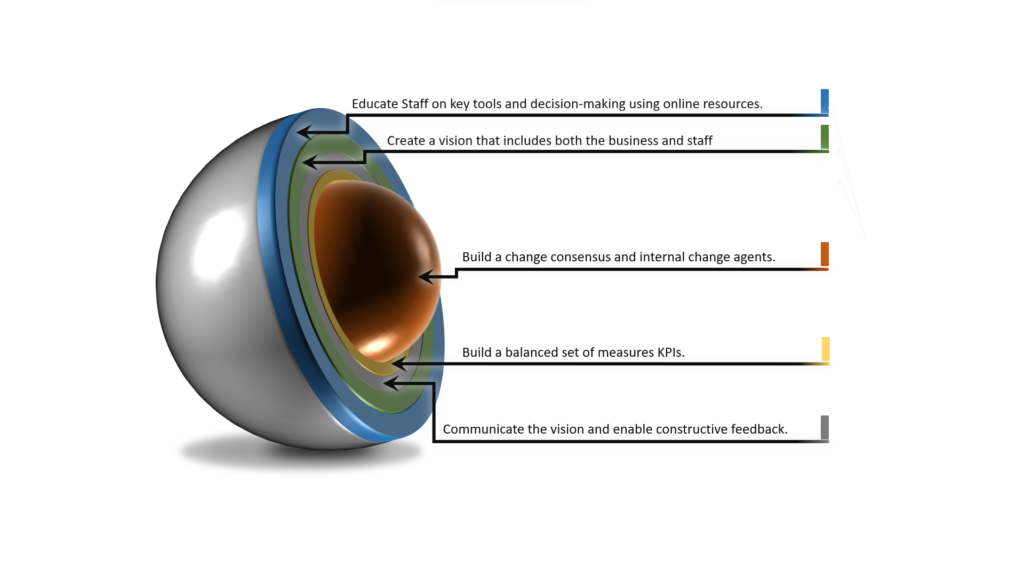
We will explore the requirement for change in the digital age reviewing how we can engage staff in the process through better communication of the future vision, ensuring we address the sceptic’s question, ‘What is in it for me?’ We look at how technology can effectively support this engagement with modern media and online training. Through these means and using the technology project to advance your staff’s skills and credibility, we create a ‘change consensus’ throughout the organisation and blunt the effect of the Immune organisational system. This support may extend to facilitating staff no longer fitting into new positions.
Finally, we will discuss the importance of the business managing the change programme rather than taking the vendor’s view; remember, their role is to get you to use new systems and applications as fast as possible.

Chapter 10: Technology Trends 2023
The final section of this workshop will take a snapshot of the technology trends that several technologies thought leaders have highlighted for 2023.
• Datafication – the development of business models that commercialise the vast amount of data we now have on all subjects from health care to
• AR/VR Metaverse – the group of the more thoroughly immersive experience over the internet, from collaborative meetings to brand marketing.
• Edge/quantum computing _ As the quantity of data organisations is dealing with continues to increase, the shortcomings of cloud computing in some situations. Edge computing is designed to help solve some of those problems to bypass the latency caused by cloud computing and get data to a data centre for processing. It can exist “on edge,” closer to where computing needs to happen. For this reason, edge computing can process time-sensitive data in remote locations with limited or no connectivity to a centralised location. In those situations, edge computing can act like mini data centres. Quantum computing, which uses subatomic particles to create new ways of processing and storing information, is a technological leap expected to bring us computers capable of operating a trillion times more quickly than the fastest traditional processors available today.
• Sustainable tech, green tech -From the large-scale conversion of industries into their cleaner counterparts (electricity) to the invention of renewable energy sources such as green hydrogen—green technologies will dominate the interrelated worlds of industries and innovation.
• Blockchain – uses the underlying principle that data can only be added to and not changed or removed; also, as a consensual system, no one person can control it. It is used for secure Bitcoin transactions and agricultural transactions for products to protect the farmer from changes in pricing through market intermediaries.
• Digital Immune Systems – aim to mitigate business risks by neutralising defects, threats, and system vulnerabilities to enhance the overall customer experience. Gartner predicts that by 2025, companies already deploying DIS will decrease customer downtime by about 80%.
• Low code, no code AI – AI operations and solutions will become more functional without coders having to write a single line of code. Its increasing acceptance among laypeople will allow more industries to fully leverage the power of AI-based intelligence and create more innovative products. No-code AI has already seeped into the market with its user-friendly interfaces in various retail and website development domains.
• Hyper automation – is a crucial mix of all the latest tools of innovation, such as:
– No-code AI
– Business management platforms and automated workflows
– Integration platforms
– Intelligent document processing
– Natural language processing
– Robotic process automation
– Process mapping tools
• 3D printing and digital twinning – Digital twins are virtual simulations of real-world processes, operations, or products that can be used to test new ideas in a safe digital environment. Designers and engineers use digital twins to recreate physical objects inside virtual worlds to test under every conceivable condition without the high costs of real-life experiments. In 2023, we’ll see even more digital twins, from factories to machinery to cars to precision healthcare. After testing in the virtual world, engineers can tweak and edit components and create them in the real world using 3D printing technology.
• Genomics – studying genes and DNA will help us better understand our health. Developing technologies such as pathogen intelligence, Next Generation Genomic Sequencing and scarless genome editing will make this subject the primary Information source for the biotech industry.
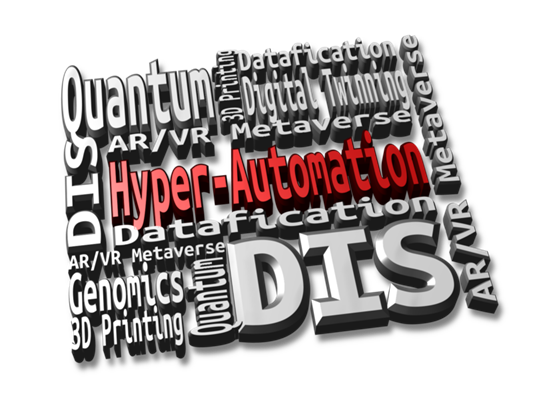
Curriculum
Technology Invoked Change – Workshop 1 – Technology Development
- Technology Development
- Development Cycles
- Technology Adoption
- Society
- The Planet
- Sustainability
- Business Transformation
- Business Models
- Change Management
- Technology Trends 2023
Distance Learning
Introduction
Welcome to Appleton Greene and thank you for enrolling on the Technology Invoked Change corporate training program. You will be learning through our unique facilitation via distance-learning method, enabling you to practically implement everything you learn academically. The methods and materials used in your program have been designed and developed to ensure that you derive the maximum benefits and enjoyment possible. We hope that you find the program challenging and fun to do. However, if you have never been a distance-learner before, you may be experiencing some trepidation at the task. So we will get you started by giving you some basic information and guidance on how to make the best use of the modules, how to manage the materials and what you should be doing as you work through them. This guide is designed to point you in the right direction and help you to become an effective distance-learner. Take a few hours or so to study this guide and your guide to tutorial support for students, while making notes, before you start to study in earnest.
Study environment
You will need to locate a quiet and private place to study, preferably a room where you can easily be isolated from external disturbances or distractions. Make sure the room is well-lit and incorporates a relaxed, pleasant feel. If you can spoil yourself within your study environment, you will have much more chance to ensure that you are always in the right frame of mind when you devote time to study. For example, a nice fire, the ability to play soft soothing background music, soft but effective lighting, perhaps a nice view if possible and a good size desk with a comfortable chair. Ensure that your family knows when you are studying and understands your rules. Your study environment is very important. The ideal situation, if at all possible, is to have a separate study, which can be devoted to you. If this is not possible then you will need to pay a lot more attention to developing and managing your study schedule, because it will affect other people as well as yourself. The better your study environment, the more productive you will be.
Study tools & rules
Try and make sure that your study tools are sufficient and in good working order. You will need to have access to a computer, scanner and printer, with access to the internet. You will need a very comfortable chair, which supports your lower back, and you will need a good filing system. It can be very frustrating if you are spending valuable study time trying to fix study tools that are unreliable, or unsuitable for the task. Make sure that your study tools are up to date. You will also need to consider some study rules. Some of these rules will apply to you and will be intended to help you to be more disciplined about when and how you study. This distance-learning guide will help you and after you have read it you can put some thought into what your study rules should be. You will also need to negotiate some study rules for your family, friends or anyone who lives with you. They too will need to be disciplined in order to ensure that they can support you while you study. It is important to ensure that your family and friends are integral to your study team. Their support and encouragement can prove to be a crucial contribution to your successful program completion. Involve them in as much as you can.
Successful distance-learning
Distance-learners are freed from the necessity of attending regular classes or workshops, since they can study in their own way, at their own pace and for their own purposes. But unlike traditional internal training courses, the student’s responsibility, with a distance-learning program, is to ensure that they manage their own study contribution. This requires strong self-discipline and self-motivation skills and there must be a clear will to succeed. Those students who are used to managing themselves, are good at managing others and enjoy working in isolation, are likelier to be good distance-learners. It is also important to be aware of the main reasons why you are studying and the main objectives you hope to achieve as a result. You will need to remind yourself of these objectives at times when you need to motivate yourself. Never lose sight of your long-term goals and your short-term objectives. There is nobody available here to pamper you, or to look after you, or to spoon-feed you with information, so you will need to find ways to encourage and appreciate yourself while you are studying. Make sure that you chart your study progress, so that you can be sure of your achievements and re-evaluate your goals and objectives regularly.
Self-assessment
Appleton Greene training programs are in all cases post-graduate programs. Consequently, you should already have obtained a business-related degree and be an experienced learner. You should, therefore, already be aware of your study strengths and weaknesses. For example, which time of the day are you at your most productive? Are you a lark or an owl? What study methods do you respond to the most? Are you a consistent learner? How do you discipline yourself? How do you ensure that you enjoy yourself while studying? It is important to understand yourself as a learner, so some self-assessment early on will be necessary if you apply yourself correctly. Perform a SWOT analysis on yourself as a student. List your internal strengths and weaknesses as a student and your external opportunities and threats. This will help you later on when you are creating a study plan. You can then incorporate features within your study plan that can ensure that you are playing to your strengths, while compensating for your weaknesses. You can also ensure that you make the most of your opportunities, while avoiding the potential threats to your success.
Accepting responsibility as a student
Training programs invariably require a significant investment, both in terms of what they cost and in the time that you need to contribute to study and the responsibility for successful completion of training programs rests entirely with the student. This is never more apparent than when a student is learning via distance-learning. Accepting responsibility as a student is an important step towards ensuring that you can successfully complete your training program. It is easy to blame others or factors instantly when things go wrong. But the fact of the matter is that if a failure is your failure, then you have the power to do something about it, it is entirely in your own hands. If it is always someone else’s failure, then you are powerless to do anything about it. All students study in entirely different ways, this is because we are all individuals and what is right for one student, is not necessarily right for another. In order to succeed, you will have to accept personal responsibility for finding a way to plan, implement and manage a personal study plan that works for you. If you do not succeed, you only have yourself to blame.
Planning
By far the most critical contribution to stress, is the feeling of not being in control. In the absence of planning, we tend to be reactive and can stumble from pillar to post in the hope that things will turn out fine in the end. Invariably they don’t! In order to be in control, we need to have firm ideas about how and when we want to do things. We also need to consider as many possible eventualities as possible, so we are prepared for them when they happen. Prescriptive Change, is far easier to manage and control, than Emergent Change. The same is true with distance-learning. It is much easier and much more enjoyable if you feel that you are in control and that things are going to plan. Even when things do go wrong, you are prepared for them and can act accordingly without any unnecessary stress. It is important, therefore that you do take time to plan your studies properly.
Management
Once you have developed a clear study plan, it is equally important to ensure that you manage the implementation of it. Most of us usually enjoy planning, but it is usually during implementation when things go wrong. Targets are not met and we do not understand why. Sometimes we need to find out if targets are being met. More is needed to conclude that the study plan failed. If it is failing, you must understand what you can do about it. Similarly, if your study plan is succeeding, it is still important to understand why, so that you can improve upon your success. You therefore need to have guidelines for self-assessment so that you can be consistent with performance improvement throughout the program. If you manage things correctly, then your performance should constantly improve throughout the program.
Study objectives & tasks
The first place to start is developing your program objectives. These should feature your reasons for undertaking the training program in order of priority. Keep them succinct and to the point to avoid confusion. Do not just write the first things that come into your head because they are likely to be too similar. Make a list of possible departmental headings, such as: Customer Service; E-business; Finance; Globalization; Human Resources; Technology; Legal; Management; Marketing and Production. Then brainstorm for ideas by listing as many things that you want to achieve under each heading and later re-arrange these things in order of priority. Finally, select the top item from each department heading and choose these as your program objectives. Try and restrict yourself to five because it will enable you to focus clearly. The other things that you listed will likely be achieved if each of the top objectives are achieved. If this is not the case, then simply work through the process again.
Study forecast
As a guide, the Appleton Greene Technology Invoked Change corporate training program should take 12-18 months to complete, depending upon your availability and current commitments. There is such a variance in time estimates because every student is an individual, with differing productivity levels and different commitments. These differentiations are then exaggerated by the fact that this distance-learning program incorporates the practical integration of academic theory as a part of the training program. Consequently, all of the project studies are real, meaning important decisions and compromises must be made. You will want to get things right and must be patient with your expectations to ensure that they are. We recommend that you are prudent with your own task and time forecasts, but you still need to develop them and clearly indicate what realistic expectations are in your case. With reference to your time planning: consider the time that you can realistically dedicate towards study with the program every week; calculate how long it should take you to complete the program, using the guidelines featured here; then break the program down into logical modules and allocate a suitable proportion of time to each of them, these will be your milestones; you can create a time plan by using a spreadsheet on your computer, or a personal organizer such as MS Outlook, you could also use a financial forecasting software; break your time forecasts down into manageable chunks of time, the more specific you can be, the more productive and accurate your time management will be; finally, use formulas where possible to do your time calculations for you, because this will help later on when your forecasts need to change in line with actual performance. With reference to your task planning: refer to your list of tasks that need to be undertaken in order to achieve your program objectives; with reference to your time plan, calculate when each task should be implemented; remember that you are not estimating when your objectives will be achieved, but when you will need to focus upon implementing the corresponding tasks; you also need to ensure that each task is implemented in conjunction with the associated training modules which are relevant; then break each single task down into a list of specific to do’s, say approximately ten to do’s for each task and enter these into your study plan; once again you could use MS Outlook to incorporate both your time and task planning and this could constitute your study plan; you could also use a project management software like MS Project. You should now have a clear and realistic forecast detailing when you can expect to be able to do something about undertaking the tasks to achieve your program objectives.
Performance management
It is one thing to develop your study forecast, it is quite another to monitor your progress. Ultimately it is less important whether you achieve your original study forecast and more important that you update it so that it constantly remains realistic in line with your performance. As you begin to work through the program, you will begin to have more of an idea about your own personal performance and productivity levels as a distance-learner. Once you have completed your first study module, you should re-evaluate your study forecast for both time and tasks to reflect your actual performance level achieved. In order to achieve this you must first time yourself while training by using an alarm clock. Set the alarm for hourly intervals and make a note of how far you have come within that time. You can then note your actual performance on your study plan and compare your performance against your forecast. Then consider the reasons that have contributed towards your performance level, whether they are positive or negative and make a considered adjustment to your future forecasts as a result. Given time, you should start achieving your forecasts regularly.
With reference to time management: time yourself while you are studying and make a note of the actual time taken in your study plan; consider your successes with time-efficiency and the reasons for the success in each case and consider this when reviewing future time planning; consider your failures with time-efficiency and the reasons for the failures in each case and consider this when reviewing future time planning; re-evaluate your study forecast in relation to time planning for the remainder of your training program to ensure that you continue to be realistic about your time expectations. You need to be consistent with your time management, otherwise you will never complete your studies. This will either be because you are not contributing enough time to your studies, or you will become less efficient with the time that you do allocate to your studies. Remember, if you are not in control of your studies, they can just become yet another cause of stress for you.
With reference to your task management: time yourself while you are studying and make a note of the actual tasks that you have undertaken in your study plan; consider your successes with task-efficiency and the reasons for the success in each case; consider this when reviewing future task planning; consider your failures with task-efficiency and the reasons for the failures in each case and consider this when reviewing future task planning; re-evaluate your study forecast in relation to task planning for the remainder of your training program to ensure that you continue to be realistic about your task expectations. You need to be consistent with your task management. Otherwise, you will never know whether you are achieving your program objectives.
Keeping in touch
You will have access to qualified and experienced professors and tutors who are responsible for providing tutorial support for your particular training program. So please don’t be shy about letting them know how you are getting on. We keep electronic records of all tutorial support emails so that professors and tutors can review previous correspondence before considering an individual response. It also means that there is a record of all communications between you and your professors and tutors, which helps avoid unnecessary duplication, misunderstanding, or misinterpretation. If you have a problem relating to the program, share it with them via email. It is likely that they have come across the same problem before and are usually able to make helpful suggestions and steer you in the right direction. To learn more about when and how to use tutorial support, please refer to the Tutorial Support section of this student information guide. This will help you to ensure that you are making the most of tutorial support that is available to you and will ultimately contribute towards your success and enjoyment with your training program.
Work colleagues and family
You should discuss your program study progress with your colleagues, friends and family. Appleton Greene training programs are very practical. They require you to seek information from other people, plan, develop and implement processes with other people and achieve feedback from other people concerning viability and productivity. You will therefore have plenty of opportunities to test your ideas and enlist the views of others. People tend to be sympathetic towards distance-learners, so don’t bottle it all up in yourself. Get out there and share it! It is also likely that your family and colleagues will benefit from your labours with the program, so they are likely to be much more interested in being involved than you might think. Be bold about delegating work to those who might benefit themselves. This is a great way to achieve understanding and commitment from people who you may later rely upon for process implementation. Share your experiences with your friends and family.
Making it relevant
The key to successful learning is to make it relevant to your own individual circumstances. At all times you should be trying to make bridges between the content of the program and your own situation. Whether you achieve this through quiet reflection or through interactive discussion with your colleagues, client partners or your family, remember that it is the most important and rewarding aspect of translating your studies into real self-improvement. You should be clear about how you want the program to benefit you. This involves setting clear study objectives in relation to the content of the course in terms of understanding, concepts, completing research or reviewing activities and relating the content of the modules to your own situation. Your objectives may understandably change as you work through the program, in which case you should enter the revised objectives on your study plan so that you have a permanent reminder of what you are trying to achieve, when and why.
Distance-learning check-list
Prepare your study environment, your study tools and rules.
Undertake detailed self-assessment in terms of your ability as a learner.
Create a format for your study plan.
Consider your study objectives and tasks.
Create a study forecast.
Assess your study performance.
Re-evaluate your study forecast.
Be consistent when managing your study plan.
Use your Appleton Greene Certified Learning Provider (CLP) for tutorial support.
Make sure you keep in touch with those around you.

Tutorial Support
Programs
Appleton Greene uses standard and bespoke corporate training programs as vessels to transfer business process improvement knowledge into the heart of our clients’ organizations. Each individual program focuses upon the implementation of a specific business process, which enables clients to easily quantify their return on investment. There are hundreds of established Appleton Greene corporate training products now available to clients within customer services, e-business, finance, globalization, human resources, information technology, legal, management, marketing and production. It does not matter whether a client’s employees are located within one office, or an unlimited number of international offices, we can still bring them together to learn and implement specific business processes collectively. Our approach to global localization enables us to provide clients with a truly international service with that all important personal touch. Appleton Greene corporate training programs can be provided virtually or locally and they are all unique in that they individually focus upon a specific business function. They are implemented over a sustainable period of time and professional support is consistently provided by qualified learning providers and specialist consultants.
Support available
You will have a designated Certified Learning Provider (CLP) and an Accredited Consultant and we encourage you to communicate with them as much as possible. In all cases tutorial support is provided online because we can then keep a record of all communications to ensure that tutorial support remains consistent. You would also be forwarding your work to the tutorial support unit for evaluation and assessment. You will receive individual feedback on all of the work that you undertake on a one-to-one basis, together with specific recommendations for anything that may need to be changed in order to achieve a pass with merit or a pass with distinction and you then have as many opportunities as you may need to re-submit project studies until they meet with the required standard. Consequently the only reason that you should really fail (CLP) is if you do not do the work. It makes no difference to us whether a student takes 12 months or 18 months to complete the program, what matters is that in all cases the same quality standard will have been achieved.
Support Process
Please forward all of your future emails to the designated (CLP) Tutorial Support Unit email address that has been provided and please do not duplicate or copy your emails to other AGC email accounts as this will just cause unnecessary administration. Please note that emails are always answered as quickly as possible but you will need to allow a period of up to 20 business days for responses to general tutorial support emails during busy periods, because emails are answered strictly within the order in which they are received. You will also need to allow a period of up to 30 business days for the evaluation and assessment of project studies. This does not include weekends or public holidays. Please therefore kindly allow for this within your time planning. All communications are managed online via email because it enables tutorial service support managers to review other communications which have been received before responding and it ensures that there is a copy of all communications retained on file for future reference. All communications will be stored within your personal (CLP) study file here at Appleton Greene throughout your designated study period. If you need any assistance or clarification at any time, please do not hesitate to contact us by forwarding an email and remember that we are here to help. If you have any questions, please list and number your questions succinctly and you can then be sure of receiving specific answers to each and every query.
Time Management
It takes approximately 1 Year to complete the Technology Invoked Change corporate training program, incorporating 12 x 6-hour monthly workshops. Each student will also need to contribute approximately 4 hours per week over 1 Year of their personal time. Students can study from home or work at their own pace and are responsible for managing their own study plan. There are no formal examinations, and students are evaluated and assessed based on their project study submissions and the quality of their internal analysis and supporting documents. They can contribute more time towards study when they have the time to do so and can contribute less time when they are busy. All students tend to be in full time employment while studying and the Technology Invoked Change program is purposely designed to accommodate this, so there is plenty of flexibility in terms of time management. It makes no difference to us at Appleton Greene, whether individuals take 12-18 months to complete this program. What matters is that in all cases the same standard of quality will have been achieved with the standard and bespoke programs that have been developed.
Distance Learning Guide
The distance learning guide should be your first port of call when starting your training program. It will help you when you are planning how and when to study, how to create the right environment and how to establish the right frame of mind. If you can lay the foundations properly during the planning stage, then it will contribute to your enjoyment and productivity while training later. The guide helps to change your lifestyle in order to accommodate time for study and to cultivate good study habits. It helps you to chart your progress so that you can measure your performance and achieve your goals. It explains the tools that you will need for study and how to make them work. It also explains how to translate academic theory into practical reality. Spend some time now working through your distance learning guide and make sure that you have firm foundations in place so that you can make the most of your distance learning program. There is no requirement for you to attend training workshops or classes at Appleton Greene offices. The entire program is undertaken online, program course manuals and project studies are administered via the Appleton Greene web site and via email, so you are able to study at your own pace and in the comfort of your own home or office as long as you have a computer and access to the internet.
How To Study
The how to study guide provides students with a clear understanding of the Appleton Greene facilitation via distance learning training methods and enables students to obtain a clear overview of the training program content. It enables students to understand the step-by-step training methods used by Appleton Greene and how course manuals are integrated with project studies. It explains the research and development that is required and the need to provide evidence and references to support your statements. It also enables students to understand precisely what will be required of them in order to achieve a pass with merit and a pass with distinction for individual project studies and provides useful guidance on how to be innovative and creative when developing your Unique Program Proposition (UPP).
Tutorial Support
Tutorial support for the Appleton Greene Technology Invoked Change corporate training program is provided online either through the Appleton Greene Client Support Portal (CSP), or via email. All tutorial support requests are facilitated by a designated Program Administration Manager (PAM). They are responsible for deciding which professor or tutor is the most appropriate option relating to the support required and then the tutorial support request is forwarded onto them. Once the professor or tutor has completed the tutorial support request and answered any questions that have been asked, this communication is then returned to the student via email by the designated Program Administration Manager (PAM). This enables all tutorial support, between students, professors and tutors, to be facilitated by the designated Program Administration Manager (PAM) efficiently and securely through the email account. You will therefore need to allow a period of up to 20 business days for responses to general support queries and up to 30 business days for the evaluation and assessment of project studies, because all tutorial support requests are answered strictly within the order in which they are received. This does not include weekends or public holidays. Consequently you need to put some thought into the management of your tutorial support procedure in order to ensure that your study plan is feasible and to obtain the maximum possible benefit from tutorial support during your period of study. Please retain copies of your tutorial support emails for future reference. Please ensure that ALL of your tutorial support emails are set out using the format as suggested within your guide to tutorial support. Your tutorial support emails need to be referenced clearly to the specific part of the course manual or project study which you are working on at any given time. You also need to list and number any questions that you would like to ask, up to a maximum of five questions within each tutorial support email. Remember the more specific you can be with your questions the more specific your answers will be too and this will help you to avoid any unnecessary misunderstanding, misinterpretation, or duplication. The guide to tutorial support is intended to help you to understand how and when to use support in order to ensure that you get the most out of your training program. Appleton Greene training programs are designed to enable you to do things for yourself. They provide you with a structure or a framework and we use tutorial support to facilitate students while they practically implement what they learn. In other words, we are enabling students to do things for themselves. The benefits of distance learning via facilitation are considerable and are much more sustainable in the long-term than traditional short-term knowledge sharing programs. Consequently you should learn how and when to use tutorial support so that you can maximize the benefits from your learning experience with Appleton Greene. This guide describes the purpose of each training function and how to use them and how to use tutorial support in relation to each aspect of the training program. It also provides useful tips and guidance with regard to best practice.
Tutorial Support Tips
Students are often unsure about how and when to use tutorial support with Appleton Greene. This Tip List will help you understand more about achieving the most from using tutorial support. Refer to it regularly to ensure you continue using the service properly. Tutorial support is critical to the success of your training experience, but it is important to understand when and how to use it in order to maximize the benefit that you receive. It is no coincidence that those students who succeed are those that learn how to be positive, proactive and productive when using tutorial support.
Be positive and friendly with your tutorial support emails
Remember that you are dealing with real people if you forward an email to the tutorial support unit. “Do unto others as you would expect others to do unto you”. You will generate a similar response in return if you are positive, complimentary and generally friendly in your emails. This will be more enjoyable, productive and rewarding for you in the long-term.
Think about the impression that you want to create
Every time that you communicate, you create an impression, which can be either positive or negative, so put some thought into the impression that you want to create. Remember that copies of all tutorial support emails are stored electronically and tutors will always refer to prior correspondence before responding to any current emails. Over a period of time, a general opinion will be arrived at in relation to your character, attitude and ability. Try to manage your own frustrations, mood swings and temperament professionally, without involving the tutorial support team. Demonstrating frustration or a lack of patience is a weakness and will be interpreted as such. The good thing about communicating in writing, is that you will have the time to consider your content carefully, you can review it and proof-read it before sending your email to Appleton Greene and this should help you to communicate more professionally, consistently and to avoid any unnecessary knee-jerk reactions to individual situations as and when they may arise. Please also remember that the CLP Tutorial Support Unit will not just be responsible for evaluating and assessing the quality of your work, they will also be responsible for providing recommendations to other learning providers and to client contacts within the Appleton Greene global client network, so do be in control of your own emotions and try to create a good impression.
Remember that quality is preferred to quantity
Please remember that when you send an email to the tutorial support team, you are not using Twitter or Text Messaging. Try not to forward an email every time that you have a thought. This will not be productive either for you or the tutorial support team. Take time to prepare your communications properly, as if you were writing a professional letter to a business colleague and make a list of queries that you are likely to have and then incorporate them within one email, say once every month, so that the tutorial support team can understand more about context, application and your methodology for study. Get yourself into a consistent routine with your tutorial support requests and use the tutorial support template provided with ALL of your emails. The (CLP) Tutorial Support Unit will not spoon-feed you with information. They need to be able to evaluate and assess your tutorial support requests carefully and professionally.
Be specific about your questions in order to receive specific answers
Try not to write essays by thinking as you are writing tutorial support emails. The tutorial support unit can be unclear about what in fact you are asking, or what you are looking to achieve. Be specific about asking questions that you want answers to. Number your questions. You will then receive specific answers to each and every question. This is the main purpose of tutorial support via email.
Keep a record of your tutorial support emails
It is important that you keep a record of all tutorial support emails that are forwarded to you. You can then refer to them when necessary and it avoids any unnecessary duplication, misunderstanding, or misinterpretation.
Individual training workshops or telephone support
Please be advised that Appleton Greene does not provide separate or individual tutorial support meetings, workshops, or provide telephone support for individual students. Appleton Greene is an equal opportunities learning and service provider and we are therefore understandably bound to treat all students equally. We cannot therefore broker special financial or study arrangements with individual students regardless of the circumstances. All tutorial support is provided online and this enables Appleton Greene to keep a record of all communications between students, professors and tutors on file for future reference, in accordance with our quality management procedure and your terms and conditions of enrolment. All tutorial support is provided online via email because it enables us to have time to consider support content carefully, it ensures that you receive a considered and detailed response to your queries. You can number questions that you would like to ask, which relate to things that you do not understand or where clarification may be required. You can then be sure of receiving specific answers to each individual query. You will also then have a record of these communications and of all tutorial support, which has been provided to you. This makes tutorial support administration more productive by avoiding any unnecessary duplication, misunderstanding, or misinterpretation.
Tutorial Support Email Format
You should use this tutorial support format if you need to request clarification or assistance while studying with your training program. Please note that ALL of your tutorial support request emails should use the same format. You should therefore set up a standard email template, which you can then use as and when you need to. Emails that are forwarded to Appleton Greene, which do not use the following format, may be rejected and returned to you by the (CLP) Program Administration Manager. A detailed response will then be forwarded to you via email usually within 20 business days of receipt for general support queries and 30 business days for the evaluation and assessment of project studies. This does not include weekends or public holidays. Your tutorial support request, together with the corresponding TSU reply, will then be saved and stored within your electronic TSU file at Appleton Greene for future reference.
Subject line of your email
Please insert: Appleton Greene (CLP) Tutorial Support Request: (Your Full Name) (Date), within the subject line of your email.
Main body of your email
Please insert:
1. Appleton Greene Certified Learning Provider (CLP) Tutorial Support Request
2. Your Full Name
3. Date of TS request
4. Preferred email address
5. Backup email address
6. Course manual page name or number (reference)
7. Project study page name or number (reference)
Subject of enquiry
Please insert a maximum of 50 words (please be succinct)
Briefly outline the subject matter of your inquiry, or what your questions relate to.
Question 1
Maximum of 50 words (please be succinct)
Maximum of 50 words (please be succinct)
Question 3
Maximum of 50 words (please be succinct)
Question 4
Maximum of 50 words (please be succinct)
Question 5
Maximum of 50 words (please be succinct)
Please note that a maximum of 5 questions is permitted with each individual tutorial support request email.
Procedure
* List the questions that you want to ask first, then re-arrange them in order of priority. Make sure that you reference them, where necessary, to the course manuals or project studies.
* Make sure that you are specific about your questions and number them. Try to plan the content within your emails to make sure that it is relevant.
* Make sure that your tutorial support emails are set out correctly, using the Tutorial Support Email Format provided here.
* Save a copy of your email and incorporate the date sent after the subject title. Keep your tutorial support emails within the same file and in date order for easy reference.
* Allow up to 20 business days for a response to general tutorial support emails and up to 30 business days for the evaluation and assessment of project studies, because detailed individual responses will be made in all cases and tutorial support emails are answered strictly within the order in which they are received.
* Emails can and do get lost. So if you have not received a reply within the appropriate time, forward another copy or a reminder to the tutorial support unit to be sure that it has been received but do not forward reminders unless the appropriate time has elapsed.
* When you receive a reply, save it immediately featuring the date of receipt after the subject heading for easy reference. In most cases the tutorial support unit replies to your questions individually, so you will have a record of the questions that you asked as well as the answers offered. With project studies however, separate emails are usually forwarded by the tutorial support unit, so do keep a record of your own original emails as well.
* Remember to be positive and friendly in your emails. You are dealing with real people who will respond to the same things that you respond to.
* Try not to repeat questions that have already been asked in previous emails. If this happens the tutorial support unit will probably just refer you to the appropriate answers that have already been provided within previous emails.
* If you lose your tutorial support email records you can write to Appleton Greene to receive a copy of your tutorial support file, but a separate administration charge may be levied for this service.

How To Study
Your Certified Learning Provider (CLP) and Accredited Consultant can help you plan a task list for getting started so that you can be clear about your direction and priorities concerning your training program. It is also a good way to introduce yourself to the tutorial support team.
Planning your study environment
Your study conditions are of great importance and will directly affect how much you enjoy your training program. Consider how much space you will have, whether it is comfortable and private and whether you are likely to be disturbed. The study tools and facilities at your disposal are also important to the success of your distance-learning experience. Regardless of your starting position, your tutorial support unit can help with useful tips and guidance. Getting this right before you start working on your training program is important.
Planning your program objectives
It is important that you have a clear list of study objectives, in order of priority, before you start working on your training program. Your tutorial support unit can assist here to ensure that your study objectives have been considered and prioritised.
Planning how and when to study
Distance-learners are freed from the necessity of attending regular classes, since they can study in their own way, at their own pace and for their own purposes. This approach is designed to let you study efficiently away from the traditional classroom environment. It is important however, that you plan how and when to study, so that you are making the most of your natural attributes, strengths and opportunities. Your tutorial support unit can offer assistance and useful tips to ensure that you are playing to your strengths.
Planning your study tasks
You should clearly understand the study tasks you should be undertaking and the priority associated with each task. These tasks should also be integrated with your program objectives. The distance learning guide and the guide to tutorial support for students should help you here, but if you need any clarification or assistance, please get in touch with your tutorial support unit.
Planning your time
You will need to allocate specific times during your calendar when you intend to study if you are to have a realistic chance of completing your program on time. You are responsible for planning and managing your own study time, so it is important that you are successful with this. Your tutorial support unit can help you if your time plan is not working.
Keeping in touch
Consistency is the key here. Suppose you communicate too frequently in short bursts or infrequently with no pattern. In that case, your management ability with your studies will be questioned, both by you and by your tutorial support unit. It is obvious when a student is in control and when one is not, and this will depend on how able you are at sticking with your study plan. Inconsistency invariably leads to in-completion.
Charting your progress
Your tutorial support team can help you to chart your own study progress. Refer to your distance learning guide for further details.
Making it work
To succeed, you will need to apply yourself to undertaking your training program and interpreting it correctly. Success or failure lies in your hands alone, so be sure you have a strategy for making it work. Your Certified Learning Provider (CLP) and Accredited Consultant can guide you through the process of program planning, development and implementation.
Reading methods
Interpretation is often unique to the individual but it can be improved and even quantified by implementing consistent interpretation methods. Interpretation can be affected by outside interference such as family members, TV, or the Internet, or simply by other thoughts which are demanding priority in our minds. One thing that can improve our productivity is using recognized reading methods. This helps us to focus and to be more structured when reading information for reasons of importance, rather than relaxation.
Speed reading
When reading through course manuals for the first time, subconsciously set your reading speed to be just fast enough that you cannot dwell on individual words or tables. With practice, you should be able to read an A4 sheet of paper in one minute. You will not achieve much in the way of a detailed understanding, but your brain will retain a useful overview. This overview will be important later on and will enable you to keep individual issues in perspective with a more generic picture because speed reading appeals to the memory part of the brain. Do not worry about what you do or do not remember at this stage.
Content reading
Once you have speed read everything, you can then start work in earnest. You now need to read a particular section of your course manual thoroughly, by making detailed notes while you read. This process is called Content Reading and it will help to consolidate your understanding and interpretation of the information that has been provided.
Making structured notes on the course manuals
When you are content reading, you should be making detailed notes, which are both structured and informative. Make these notes in a MS Word document on your computer, because you can then amend and update these as and when you deem it to be necessary. List your notes under three headings: 1. Interpretation – 2. Questions – 3. Tasks. The purpose of the 1st section is to clarify your interpretation by writing it down. The purpose of the 2nd section is to list any questions that the issue raises for you. The purpose of the 3rd section is to list any tasks that you should undertake as a result. Anyone who has graduated with a business-related degree should already be familiar with this process.
Organizing structured notes separately
You should then transfer your notes to a separate study notebook, preferably one that enables easy referencing, such as a MS Word Document, a MS Excel Spreadsheet, a MS Access Database, or a personal organizer on your cell phone. Transferring your notes allows you to have the opportunity of cross-checking and verifying them, which assists considerably with understanding and interpretation. You will also find that the better you are at doing this, the more chance you will have of ensuring that you achieve your study objectives.
Question your understanding
Do challenge your understanding. Explain things to yourself in your own words by writing things down.
Clarifying your understanding
If you are at all unsure, forward an email to your tutorial support unit and they will help to clarify your understanding.
Question your interpretation
Do challenge your interpretation. Qualify your interpretation by writing it down.
Clarifying your interpretation
If you are at all unsure, forward an email to your tutorial support unit and they will help to clarify your interpretation.
Qualification Requirements
The student will need to successfully complete the project study and all of the exercises relating to the Technology Invoked Change corporate training program, achieving a pass with merit or distinction in each case, in order to qualify as an Accredited Technology Invoked Change Specialist (ACES). All monthly workshops need to be tried and tested within your company. These project studies can be completed in your own time and at your own pace and in the comfort of your own home or office. There are no formal examinations, assessment is based upon the successful completion of the project studies. They are called project studies because, unlike case studies, these projects are not theoretical, they incorporate real program processes that need to be properly researched and developed. The project studies assist us in measuring your understanding and interpretation of the training program and enable us to assess qualification merits. All of the project studies are based entirely upon the content within the training program and they enable you to integrate what you have learnt into your corporate training practice.
Technology Invoked Change – Grading Contribution
Project Study – Grading Contribution
Customer Service – 10%
E-business – 05%
Finance – 10%
Globalization – 10%
Human Resources – 10%
Information Technology – 10%
Legal – 05%
Management – 10%
Marketing – 10%
Production – 10%
Education – 05%
Logistics – 05%
TOTAL GRADING – 100%
Qualification grades
A mark of 90% = Pass with Distinction.
A mark of 75% = Pass with Merit.
A mark of less than 75% = Fail.
If you fail to achieve a mark of 75% with a project study, you will receive detailed feedback from the Certified Learning Provider (CLP) and/or Accredited Consultant, together with a list of tasks which you will need to complete, in order to ensure that your project study meets with the minimum quality standard that is required by Appleton Greene. You can then re-submit your project study for further evaluation and assessment. Indeed you can re-submit as many drafts of your project studies as you need to, until such a time as they eventually meet with the required standard by Appleton Greene, so you need not worry about this, it is all part of the learning process.
When marking project studies, Appleton Greene is looking for sufficient evidence of the following:
Pass with merit
A satisfactory level of program understanding
A satisfactory level of program interpretation
A satisfactory level of project study content presentation
A satisfactory level of Unique Program Proposition (UPP) quality
A satisfactory level of the practical integration of academic theory
Pass with distinction
An exceptional level of program understanding
An exceptional level of program interpretation
An exceptional level of project study content presentation
An exceptional level of Unique Program Proposition (UPP) quality
An exceptional level of the practical integration of academic theory
Preliminary Analysis
Content here…

Content here…

Content here…

Content here…

Content here…

Content here…
Course Manuals 1-12
Course Manual 1: Technology Development
Developing technology is a natural human activity in our attempt to improve our lives; as the phrase goes, ‘necessity is the mother of invention’, and we try to accomplish tasks in our daily lives and encounter problems; we seek ways and means of overcoming the difficulties.
Understanding technological developments will help us improve technology implementation in your businesses. Why is this the case? Technological development has its own pace, and in this digital age, this pace is getting quicker; however, as case studies will highlight, implementation requires a change management mindset and a dedication to continually improving business processes.
Furthermore, your better understanding of any technology’s genesis will provide insight into how it might be implemented and how the functionality has been designed. SAP is a case in point; a fully functional ERP system was created from a finance perspective to address global corporations’ requirement to consolidate accounts. This means that implementation will be driven by strict financial rules and conditions so that all data elements with a finance component are managed to a rigid structure. Though this might be expected in finance, it can be daunting in other areas of the business; plus, we are all guilty of not recording and updating all data in our lives, therefore when our business system, which is so tightly integrated, forces this discipline the level of change management is enormous.
Earlier, we discussed the pace of technological development; the current rapid pace of development leaves companies with several dilemmas. Do I want to be on the ‘bleeding edge of development where implementation skills are in short supply, and the product/service might be incomplete? When do I jump into the technological stream to avoid being too far behind? How do I avoid picking a technology that might not be adopted as a standard? How do I find the right implementation skills whilst also developing the right level of internal capability? What is the right level of ability?
As you might imagine, the answers to these questions will depend on the company profile and culture; but there are some fundamentals that you must address. Your business vision must be clear and translatable into specific strategic requirements. The image must be represented in processes that enable you to set out measures of performance and the jobs required and, therefore, the skills to be developed or employed.
The speed of technological development has created a growing skills gap, leading to a growth in service companies in specific technical and creative skills. In some cases, these are combined as technology becomes more of a commodity, enabling us to provide our core skills such as graphics, animation or process modelling.
The commodification of hardware and software started with the development of mini-computers, removing applications from the mainframe and then the explosion of personal computers defined a new architecture which split the delivery of capability between a data management system (sometimes called ‘server’) and the desktop processing (called the ‘client’), as the size of the technology of processing developed. Hence, the capability of languages advanced from commercial ones such as COBOL to more mathematical such as FORTRAN. Again the genesis of each language shows its focus, such as order processing in the case of COBOL, dealing with alpha-numeric data; In contrast, FORTRAN was focused on processing mathematical formulae.
Specialisms drove many facets of technology, such as screen design and clarity; more significant, more precise screens to support computer-aided creation have now morphed into supporting graphic design, animation and gaming.
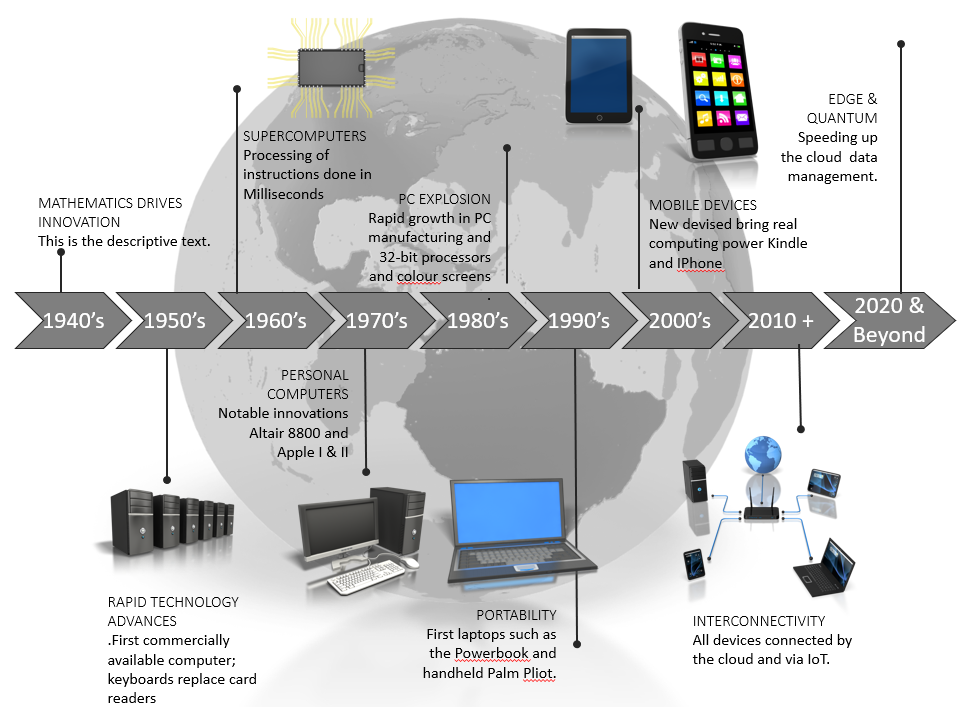
As the microprocessor design continues to follow Moores’s law (see diagram), hardware capability has increased whilst the footprint has shrunk. This has continued the development commodification of hardware with mobile devices, starting with laptops and moving to tablets, scanners and smartphones.
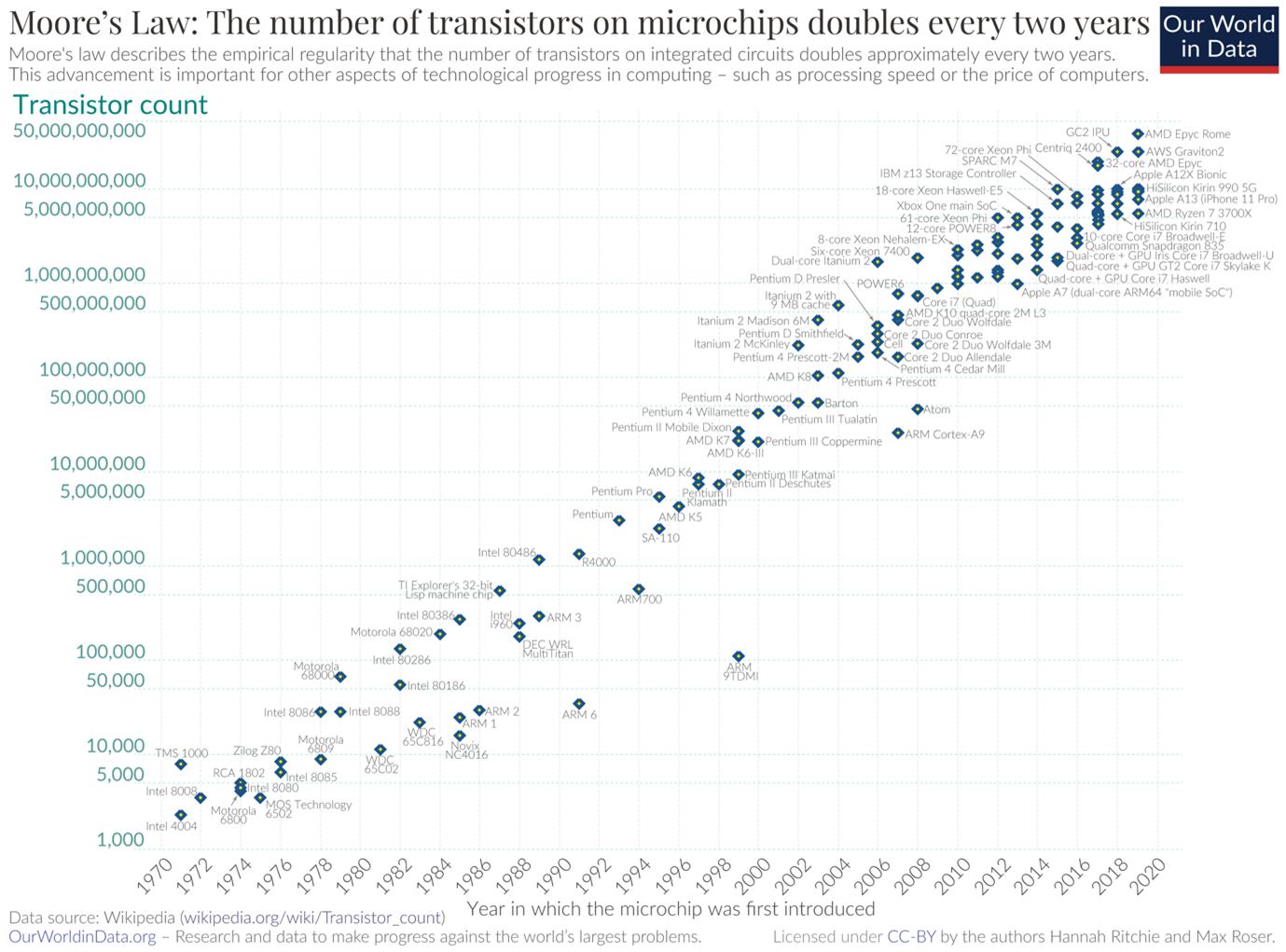
To enable these devices to be effective, the software had to adapt from just processing data to providing a user interface that was simple to use, could fit on smaller screens and did not require a keyboard.
As business systems became more extensive and integrated, personal devices gave birth to many single applications to address a particular transaction, such as sending mail or text messages and managing diary entries.
The application growth has also spawned more languages, as the internet has added to the pressure to get these skills into schools/colleges or retrain existing coders. As an answer to this shortage, code can be developed by users of the application and templates are provided to simplify implementation; typical of this would be WordPress website development software with several plug-in applications to link into specific functionality such as shop front and payment systems. In addition to code generators, low or no-code approaches can be used by diagramming the requirement in a workflow, for example, to define a process or how to process a series of decisions in an AI system.
The final element of commodification that has emerged in software is the ‘platform’, a way of providing several services to support the delivery of products. An excellent example of such an approach is the delivery of online training courses. In this case, all practices must provide a shop front for potential students to purchase classes, payment systems, assessment, and certification systems, which any course designers and deliverers can use for their content.
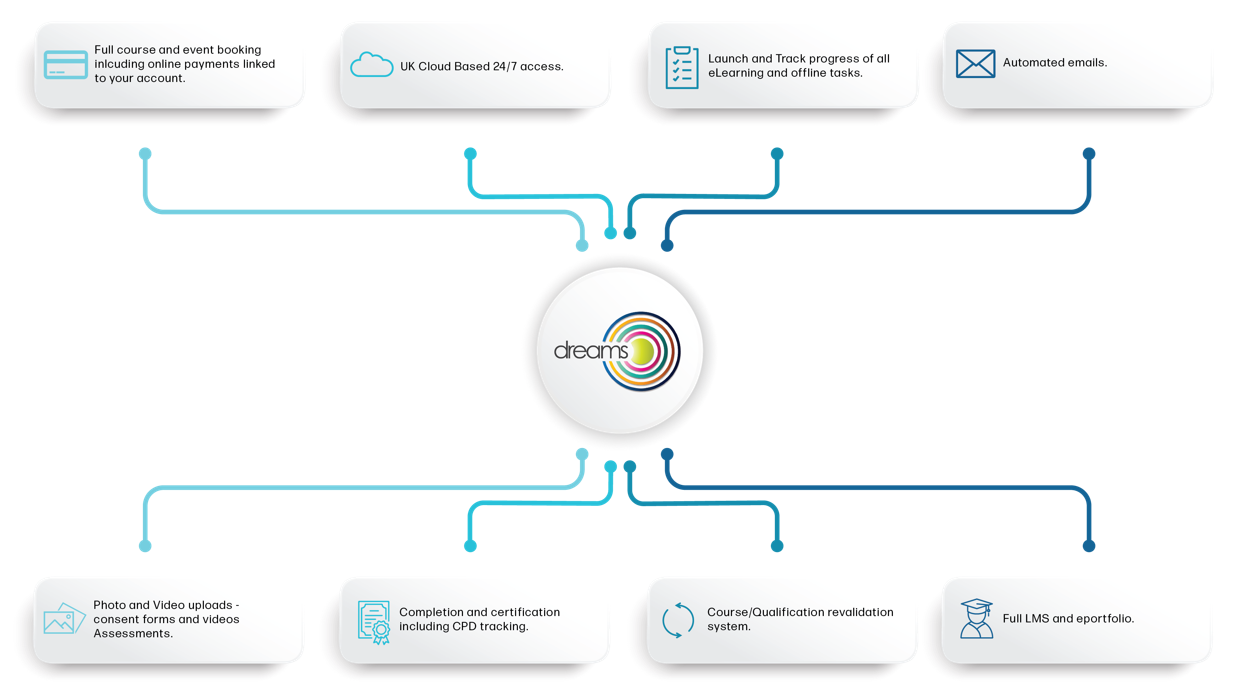
The growing data requirements enforced a move from the filing system structures, which replicated the manual system, to databases that provide multiple relationships between data elements. Latterly these relational databases have begun to be superseded or supported by Big Data which permits more detailed analytical capability.
All these rapid developments have created a skills gap for existing staff to use the new technologies and for training and educating recruits to business and technology companies. The latest generations are more ‘native’ to digital technologies, so they have a head start, but to many, that is how they conduct their lives, not how they will earn a living.
The outcome of this is the rise of the ‘creators’ business model where freelancers, mainly with creative skills, have formed a complete eco-system to support businesses, particularly in social media management, marketing, graphical design, animation and video production.
This adds to the challenges of traditional business models, specifically those that rely on complete vertical integration within the business rather than the core business supported by various ecosystems of approved suppliers. The skills gap also manifests in capturing knowledge from existing staff as they leave or retire from the company. Knowledge bases have been used to try and plug this gap and are a regular feature of most businesses’ websites in the form of FAQs. Recently the messaging technology we are familiar with in-text applications has been repurposed and combined with simple AI techniques to deliver Conversational Learning which is the provision of micro-learning packages supporting tasks users are trying to perform, maybe one that only happens once a month or once a year.
Technology, as it always does, has opened new opportunities for businesses such as technology specialists. It also can transform traditional processes such as subscription billing. Robotic Process Automation using anniversary dates, which can be annual or monthly, can easily bill and take payment through online billing systems. In many situations, the billing is set up by the customer. Therefore, low overhead is associated with the process, making this very practical for smaller sums of money. This also plays into the ordinary acceptance of payments monthly and, therefore, never questioning the full, even if the application is no longer relevant; the onus is on the customer. These payments are also nominated as revenue rather than capital.
Reviewing the impacts of digital technologies on society, COVID released what pundits have predicted as a move to online working and supporting working from home. This led to a boom for companies like Zoom (see case study), dramatically impacting transport and office space requirements. Post-COVID, these trends are being reversed in the name of teamwork. A hybrid model that requires attendance in the office, up to 3 days per week, using technology such as remote meetings and collaborative tools to enable working at home is becoming a norm.
The impacts on the work-life balance can be seen as positive though it has tested management trust models and scheduling and managing resources. Technology has severely impacted jobs, such as bank clerks with the ATM. Robots perform assembly tasks such as body panels and chassis spot welding or gluing as laying of carbon fibre for aerospace and automotive parts.
Other repetitive tasks that might have formed part of a person’s job role have been replaced, such as the monthly issuing of statements, enabling the company to expand that person’s role into credit management.
This form of process transformation usually precedes the introduction of more integrated systems moving from stand-alone departmental ones. This can be based on best-of-breed but interfaced with a wholly integrated solution. Either solution releases a raft of benefits derived from a single source of truth to remove duplicated tasks and translation errors.
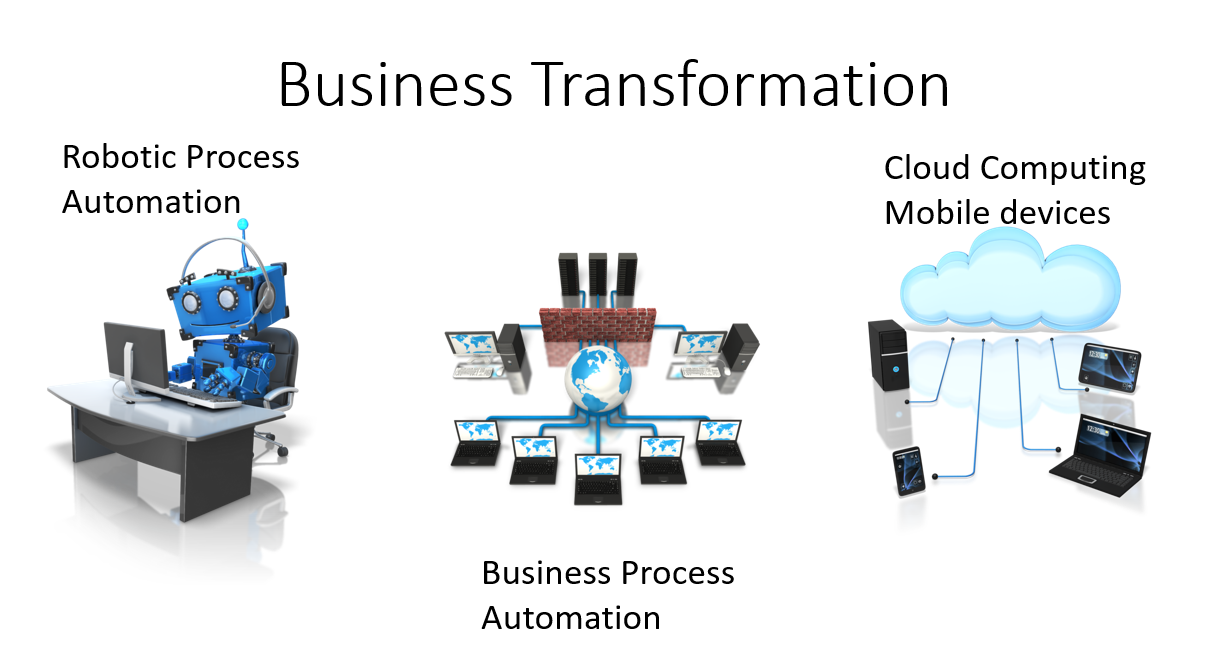
When technology at this level is fully embraced, data is entered only once by the owner of that data; suppliers and customers are fully integrated into the processes they are involved with, such as portals for access to product data, profile information and order and payment history. Employees are granted the same capability to maintain personal information, undertake CPD activities, and manage their benefits.

Case Study
Amazon Business is an example of how a consumer giant transitions to the B2B space to keep up with digital customer expectations. It provides a marketplace for businesses to purchase from Amazon and third parties. Individuals can also make purchases on behalf of their organisations and integrate order approval workflows and reporting.
The approach:
• Amazon created a holistic marketplace for B2B vendors by offering over 250 million products ranging from cleaning supplies to industrial equipment.
• It introduced free two-day shipping on orders worth $49 or more and exclusive discounts. It further offered purchase system integration, tax exemption on purchases from select qualified customers, shared payment methods, order approval workflows, and enhanced order reporting.
• Amazon allowed manufacturers to connect with buyers & answer questions about products in a live expert program.
The value:
• Amazon could tap the B2B wholesale market valued between $7.2 and $8.2 trillion in the U.S. alone.
• It began earning revenue by charging sales commissions ranging from 6-15% from third-party sellers, depending on the product category and the order size.
• It could offer more personalised products for an improved customer experience.

Case Study
Sophos went live with Salesforce to accelerate its sales process, enhance sales productivity, and increase the number of accounts won. However, the complex interface and regular updates of Salesforce resulted in a decreased ROI.
The approach:
• Sophos implemented Whatfix to provide interactive, on-demand training that helped users learn in the flow of work. The 24*7 availability of on-demand self-support, contextual guidance, and clever tips allowed Sophos to manage its new CRM implementation effectively.
• It unified internal communications using Whatfix content. First, they created walkthroughs for the basic functionality of Salesforce, such as lead management, opportunities, etc. Next, they moved to slightly more complex features their users were uncomfortable with and created guided walkthroughs and innovative pop-ups. Sophos also used Whatfix to align the sales and product management teams by embedding videos and other media to unify product communication instead of relying on various communication tools.
The value:
• Sophos experienced a reduction in sales operations support tickets globally by 15% (~12,000 tickets). It saved 1070 person-hours and achieved an ROI of 342%

Case Study
Under Armour introduced the concept of “Connected Fitness” by providing a platform to track, analyse and share personal health data directly to its customers’ phones.
The approach:
• Under Armour, acquired technology-based fitness organisations such as MapMyFitness, MyFitnessPal, and European fitness app Endomondo for a combined $715 million to obtain the required technology and an extensive customer database to get its fitness app up and running. The application provides a stream of information to Under Armour, identifying fitness and health trends. For example, Under Armour (Baltimore) immediately recognised a walking trend that started in Australia, allowing them to deploy localised marketing and distribution efforts before their competitors knew about it.
• Under Armour, merged its physical and digital offerings to provide an immersive customer experience via products like Armourbox. The company urged its customers to go online and share their training schedule, favourite shoe style, and fitness goals. It used advanced analytics to send customers new shoes or apparel on a subscription basis, offering customers a more significant value over their lifetime.
• It additionally moved to an agile development model and data centre footprint with the ERP SAP HANA.
• Under Armour also leveraged Dell EMC’s Data Protection and Dell Technologies to help fuel digital innovation and find peak value from its data.
The value:
• Under Armour created a digital brand with a strong consumer focus, agility, and change culture.
• The Connected Fitness app provides a customer experience tailored to each consumer.

Case Study
Like the video rental company Blockbuster, Netflix also had a pay-per-rental model, which included DVD sales and rent-by-mail services. However, with rising digitalisation, Netflix anticipated a change in customer demand and provided online entertainment, thereby entirely wiping out Blockbuster and the movie rental industry.
The approach:
• In 2007, Netflix launched a video-on-demand streaming service to supplement their DVD rental service without additional cost to their subscriber base.
• It implemented a simple and scalable business model and consistently infused 10% of its budget in R&D.
• The company has an unparalleled recommendation engine to provide a personalised and relevant customer experience.
The value:
• Netflix is the most popular digital video content provider, leading other streaming giants such as Amazon, Hulu, and Youtube with over 85% market share.
• Netflix added a record 36 million subscribers directly after the start of the COVID-19 pandemic.

Exercise
• Organise into pairs
• Draw Impact-Effort Quadrants on the whiteboard
• Place technology selections on the quadrant
• Debate groups and rearrange if required
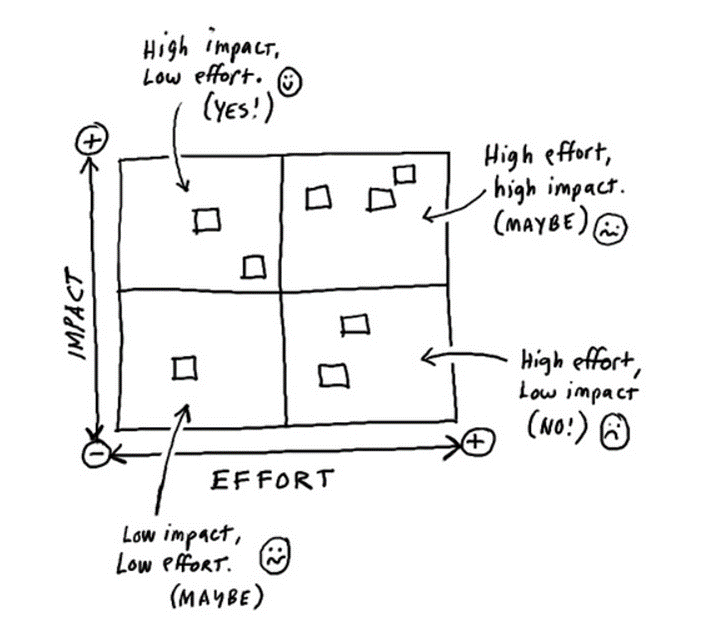
Course Manual 2: Development Cycles
Since the industrial revolution, the management of technological development has become increasingly important; to ensure that the technology satisfies the requirement creating a solution that achieves the objective with the right quality, cost and robustness. Developers must effectively manage their resources, including people, money and time. The latter of these cannot be scaled.
Technologies have become more complex, and therefore we need to manage the whole ecosystem around the development steps in the process. As scientific management techniques developed, a systems approach would provide a framework to work and make decisions at the critical steps in development. The Digital age has tested these principles, and IT professionals have developed new techniques to address the perceived weaknesses in the traditional approach.
We will review the traditional methods and those espoused by IT with the next generation of development cycle management, the hybrid approach. Before investigating the management methods, let’s look at the ecosystem we need to make the management approach effective. The system must provide four functions covering strategy, portfolio management, innovative company culture and an adaptive, agile and accelerated process from idea development to product/service launch.
Along all these vectors, we require bold decisions, effective management and leadership. It has been noted recently that if you look at four measures of product development in the 1990s compared to the 2000s, the level of innovations has dropped significantly;
• New to the world down 43%
• New to Company down 30%
• Additions to line up 20%
• Improvements to products up 80%
If we are to be more bold and inventive, then we need to follow several success criteria.
• Unique and differentiated products
• Clear customer focus
• Upfront work such as market research
• Sharp product definition
• Close collaboration with customers during the development (Spiral development)
• Broad market view of the product is more global than local
• Well executed launch
• Fast but effective process enactment
Looking at each of these success criteria in more detail, the first point illustrates the need for less ‘Me-Too’ and more products that differentiate themselves. An excellent example of this is the iPod developed by Apple. They were late into the market behind the likes of Sony. However, good existing product functional need analysis and design that enabled users to use their existing music collections and then download new music transformed the market. Sony’s response led to the Discman, an update to the Walkman but not a challenge to the product and service provided by the iPod.
This example shows a clear customer focus, recognising the need to play your music and curate and add to it easily. To do this, the requirement for upfront homework clearly defines the customer’s pains and gains in listening to their music away from home. The technical condition became very clear with the need for small and effective data storage medium and a music management system based on the PC. By resolving both of these issues, one with the purchase of a software company, Apple managed a sharp product definition and achieved the required functional design in the successful device package.
Reflecting on this example, there will have been customer forums run with mock-ups (Minimal Viable Product MVP) to test the device size, weight and user interface reaction. Being Apple then, the product was also considered global, not restricted to the US market. Finally, the product launch was very well executed and set the tone for all future product launches with the ‘i’ range.
The final point of the eco-system is that speed counts; though the first entrant will experience all the issues of new products and services, they usually retain the lead as they are less affected by market changes. Plus, more rapid development helps team morale. Considering this and accepting that development cycle management is the core of successful products/services, we will examine what changes need to be accommodated within the system to allow for more speed.
Stage-Gates are an accepted best practice in effectively managing new product projects; companies using this approach are rated as more successful such as 3M, Corning Glass, the developers of Pyrex and glass for flat-panel displays, Lego and ITT. At ITT, the success of new product developments meant that sales for new products went from 15% of annual sales to 35%. Recent studies show that best performers in product development, over 90% apply Stage-gate principles compared to only 44% of the worst performers.
Looking at the underlying goals that a management system should address include the following;
• Quality of execution is paramount to avoid things not happening when they should or be completed as well, as they should work in areas such as customer focus and upfront research. Focus on completeness, quality and essential.
• A clear focus on the prioritisation of resources; can be the result of poor stress in making challenging Go/Kill decisions. As Robert Cooper describes, ‘ Creating a product tunnel rather than a product funnel’, where poor projects are removed at Go/Kill points and resources moved to more deserving projects. Good Go/Kill gate criteria help to answer two fundamental questions ‘Are we doing the project right? And are we doing the right project?’ Typically gates would therefore check on readiness, business rationale and forward plan
• We are improving the speed of development without sacrificing quality. The system has evolved from purely serial activities to parallel processing to avoid issues such as departmental hand-offs typical in a serial sequential approach. Alongside this cross-functional, Multi-disciplinary process, we can embed customers in rapid build-test-feedback-revise activities and, where necessary, the suppliers. This approach has been called Spiral Loops.
• An accurate Cross-Functional teams approach requires a complete departmental representation with allocated responsibility and time to participate in meetings; a project leader that has formal authority and is able and capable of promoting the project internally. Fluid leaving and joining structure as work responsibilities change or people go the business. Senior management holds the whole team responsible for results.
• Strong Market focus integrating customer input across the process, beginning with a market assessment and continuing through concept development, prototyping and pre-launch testing.
• Products with a competitive advantage are defined through a compelling Value Proposition. Ensuring the gate criteria at all stages address product superiority, managing both pains and gains identified, and testing the product definition includes reference to the Value Proposition and performance and functional specification.
Management also wants to manage any risk within a project, and by using the Stage-gate approach, they can achieve this by breaking the risk into increments across the process. The gate meetings ensure robust criteria are applied and investment decisions are based on the best available information. Typically risks grow when the project brings uncertainties, such as new markets being entered or new technologies being applied. Stage gates aim to reduce tension through research and development before making investments.
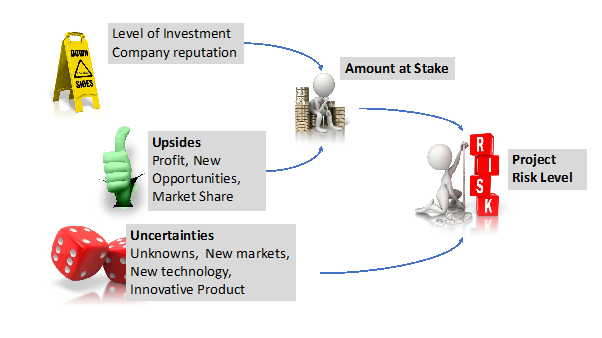
Typically there are five stages in the Stage-gate process, as illustrated in the diagram below; each step has an outlined series of activities and the progress point of each gate.
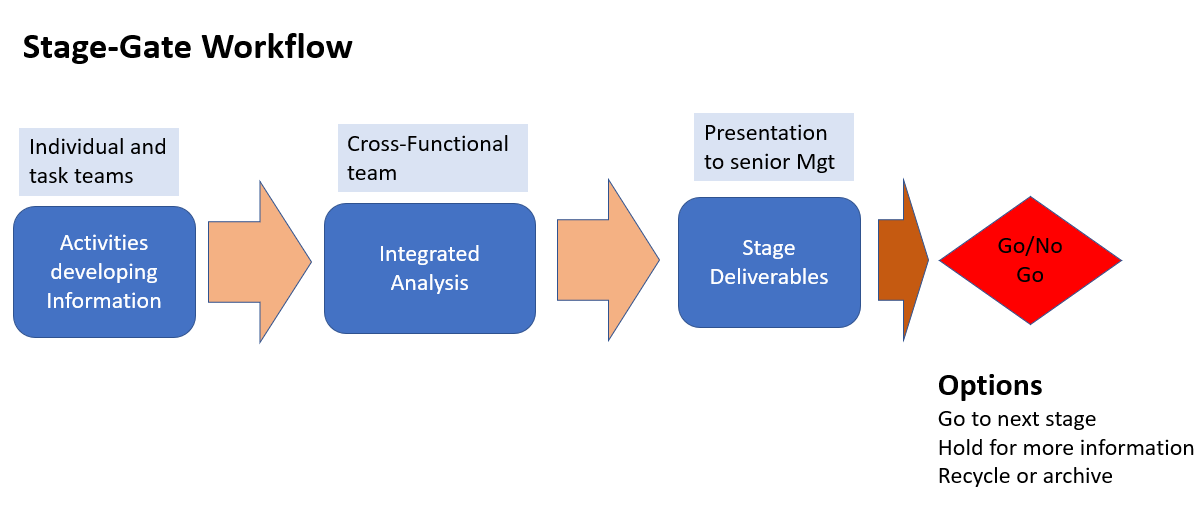
The process starts with an ideation stage. Some companies have developed a comprehensive system covering fundamental technical research, horizon scanning, extensive customer needs and problems research, competitive research and internal idea-suggestion schemes. This activity might include ‘open innovation’ with suppliers and customers and strategic planning exercises seeking disruptions, maybe in collaboration with a research institute. The deliverable from this stage would be an idea; typical gate criteria might be strategic alignment, overall feasibility, opportunity size, market attractiveness, product advantage, and the ability to maximise the company resources and skills.
Stage 2 covers scoping, a relatively light load stage involving desk research, an essential facet would be a preliminary market assessment covering activities from internet research, discussions with sales and account managers and key customers to elicit information such as market size and potential and critical functional needs. Alongside this market assessment, a technical one can be undertaken to assess the match to skills and capabilities, supply chain implications, and regulatory requirements. The outcomes from this work can be drawn up into a preliminary business case.
The assessments, business case and an outline product definition are the key deliverables, and the gate criteria would be similar to those in gate1 with additional criteria in the ‘should-meet’ category, such as customer reaction and legal, technical and regulatory obstacles. Any financial assessment at this stage will be simple, like Payback Period.
When a project moves onto stage 2, activities in this stage are directed to building the business case, which requires that the full product definition is completed. Making on the previous step with in-depth target market definition, product concept, positioning strategy, benefits to be delivered and the customer value proposition. This will enable features and attributes, and high-level specifications to be documented. Additional work will be completed on competition and using the key customers to present the product concept and assess their reaction and possible acceptance of the product.
Further in-depth technical work will focus on feasibility and risks, validating the customer needs and maybe their ‘wish list’. Manufacturing appraisal would accompany any design assessment covering manufacturability, sources of supply and costs. If the work in Stage 1 identified critical legal, patent and regulatory work that was required, this would be undertaken in this stage.
The business case will combine all these outputs with a detailed financial analysis, typically involving discounted cashflow such as NPV and IRR. The key deliverables are a product definition, project justification and a detailed project plan; to enable at-the-gate review so that the jump to development can be made.
As the final gate before full development is committed to and therefore significant financial spend also. The product funnel shows that the slope is steepest in Gates 1 and 2 and that only some projects are stopped beyond Gate 3.
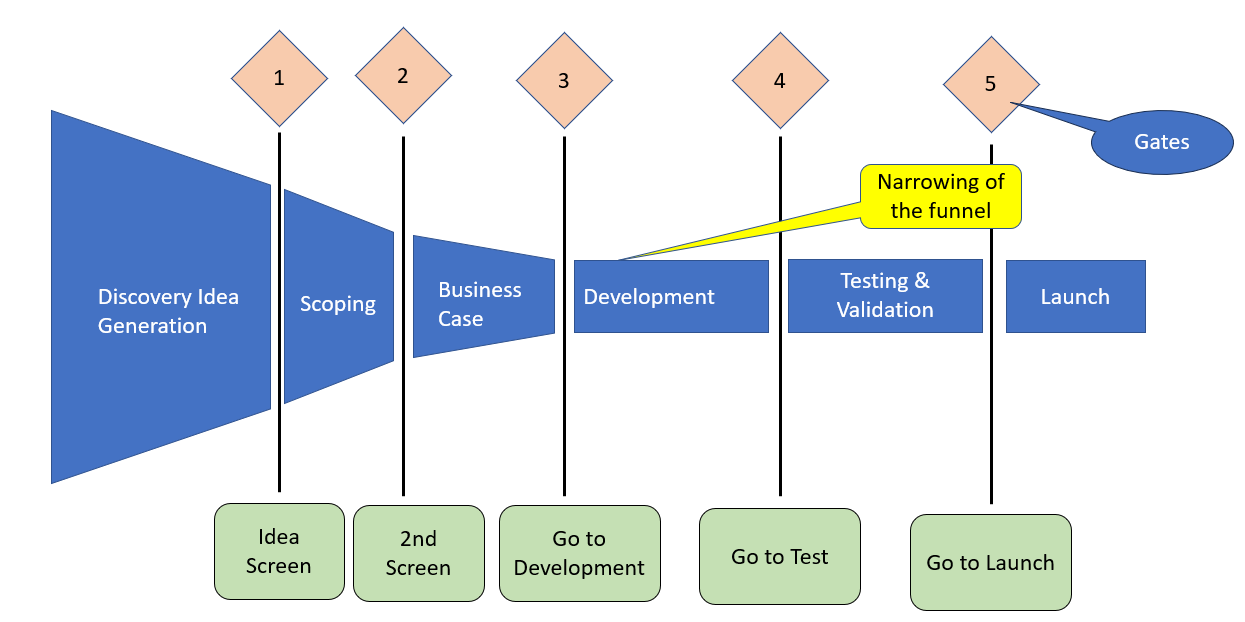
Stage 3 sees the engagement of the entire project team, a review of all the plans covering development, and preliminary ones for operations and marketing. Development work will focus on developing a testable prototype and validating and securing the sources of supply, particularly for any critical materials and components. If the development stage is long, then interim milestones should be applied to ensure progress aligns with the project plan. If the project is off course, an emergency gate review can establish the source of the issue and seek mitigating actions to correct it.
During this stage, there is also more intense customer interaction through the build-test-review-feedback spiral. Alongside the development activity, the team will create more in-depth plans for operations and marketing. The former defines production capacities and capabilities and, therefore, costs; the latter marketing messages, target customers channels and sales/distribution processes. It is during this and the following stage that the influence of Agile techniques in software development has been employed. These methods apply short time-boxed activities, which enable flexibility in design change and improve the perception of stakeholders in the project. This has also been used in physical product developments, and a full hybrid model has emerged, which we will discuss later.

The deliverables for gate 4 typically include a reviewed prototype ready for complete customer trials, marketing and operations plans, and a testing and validation plan, which would also embrace any legislative requirements. Finally, an updated financial and business plan.
The gate criteria will check on the continued attractiveness of the product and project; examining the quality of the technical work, that the product works; meets customer requirements and delights them. Further financial analysis will clarify the economic impact of the product, both positive in new sales to existing and new customers and negative in terms of cannibalisation of present product sales. The final decision at this gate is to move to Testing and validation.
During this stage, we validate the project viability, the product and all operational processes, customer acceptance and the fundamental economics. This is achieved through product tests, including field trials that should test any installation requirements and future maintenance. A trial or pilot production run is conducted to prove component sourcing, manufacturing and assembly operations; this will provide information on costs and time.
Stage 4 testing and validation. Any key partnership arrangements or specific production equipment would be identified at this stage, including initial negotiations and placement of long lead time orders.
The marketing plan will request a ‘soft launch’ where initial product samples are sold at a discount to chosen customers to elicit their reaction and gain feedback. Also, the business and financial plans will be updated during this stage. Sometimes during this stage, an iteration takes the process back to stage 3.
At gate 5, the criteria will test whether we are ready to commercialise, including market launch and complete production start-up fully. To pass this gate, operational plans must be robust and achievable, including maybe stock building, the financial return is still as expected, and we are commercially ready, sales and marketing materials, sales persons trained, and any customer-facing system completed.
Stage 5 Launch is the implementation of marketing and operational plans; this latter plan will cover equipment installation, contractual agreements reached and any stock in the logistics system. The final part of the idea-to-launch process will be a post-launch review examining all aspects of the project, from the product’s success to lessons to be learned and possible process improvements.
In summary, the critical elements of a robust and effective stage-gate system are;
• Well-defined Stage Gates with a defined purpose
• Clear deliverables at each stage
• Gates with defined deliverables and clear and well-structured criteria supporting the Go/No Go decision. Ideally not subjected but with a score associated with them and maybe a weighting
• Outputs associated with each gate that relate to the decisions GO/NO GO/Hold/recycle
• Roles well defined for the project leader, project team members, project manager, gatekeepers and executive sponsor covering responsibilities and mandates.
Stage-Gates can be applied to various projects, with the structure of the gates implemented to suit the output. For example;
• Process developments
• Product developments
• Technology developments
• Process Improvements (which might include merger and acquisition)
• IT projects
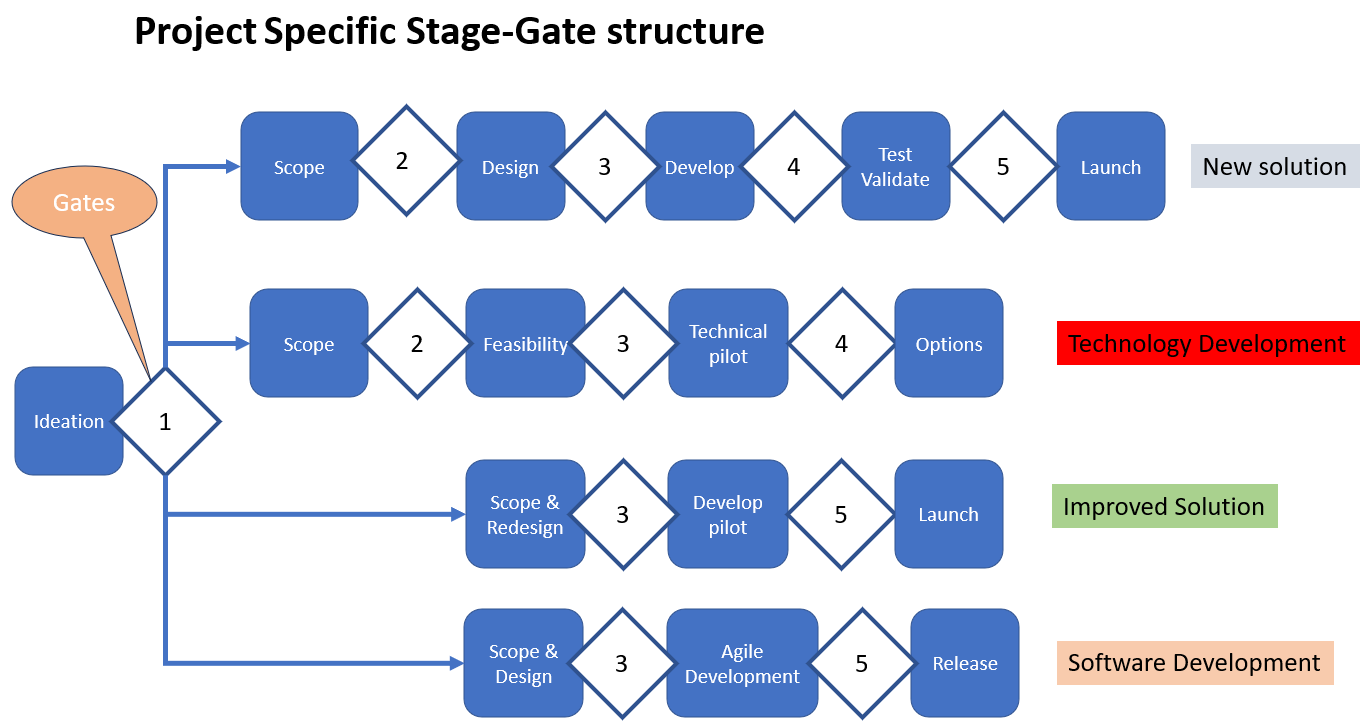
The Stage-Gate approach was defined following industry research in the 1980s, and it has been very successful, with many leading innovative companies using and adapting it. But technological change is much faster now, and customers are still determining what they need. Additionally, the manner of development in software has led to the process being challenged and the creation of the ‘agile’ methodology. A vital criticism of the process is;
• It is too rigid, linear and planned
• It does not encourage experimentation
• Too financially based
• Is controlling and bureaucratic
This criticism has been challenged by stating that many of the issues highlighted were due to poor implementation.
The software industry was looking for an adaptive and flexible approach to developing new products, which they saw as keys to the speed of development, efficiency in communication and greater productivity. Stage-Gate was perceived as focused on risk management instead of uncertainty management, as the pace of growth was growing. This was seen in the anticipated design of the product, the freezing of design specifications, fixing the project scope and low customer interaction. Software development sought continuous design flexibility in content, later freezing the design, an openness to uncertainty and close cooperation with customers.
The stated outcomes from this ‘agile’ approach are
• Individuals and Interactions?
• Working Software versus Comprehensive documentation
• Customer collaboration versus contract negotiation
• Responding to changes rather than following a plan
A hybrid model has now emerged, exhibiting some strengths such as improved time to market, increased team productivity, quicker response to market changes, higher team motivation, better internal communication and capturing of customer feedback and synchronisation between projects, resulting in higher levels of innovation. However, the model did have difficulties around the allocation of resources, a method for measuring the allocation of resources, physically keeping teams together, and continuous evolution of the design when a physical product is involved, using some of the agile methods such as sprints when developing and testing a physical product and also keeping to the frequency of meetings. Within the SCRUM methodology
In some environments, an agile mindset was absent, making implementation difficult. Investing in concept products as prototypes or Minimum Viable Products is now the best practice in early-stage development.
Several solutions have been applied, such as extending sprints when physical products are involved, ensuring that deliverables such as design drawings are part of a stage gate deliverables package and using facilitators conversant in agile to improve the team members’ mindset. Some of the benefits of this hybrid approach ae
• Better Communications & heightened community
• Less Field returns down 50%
• 20/30% reduction in cycle time
Spiral developments are a widely deployed change integrating the customer into the development and testing stages. Additionally, context-based stage definitions create flexibility, introducing risk-based contingency models and flexible criteria for Go/No Go gates. Risk-based contingency models determine the activities to be completed in a stage chosen to reduce uncertainties. This will guide the information gathering and help to validate any assumptions.
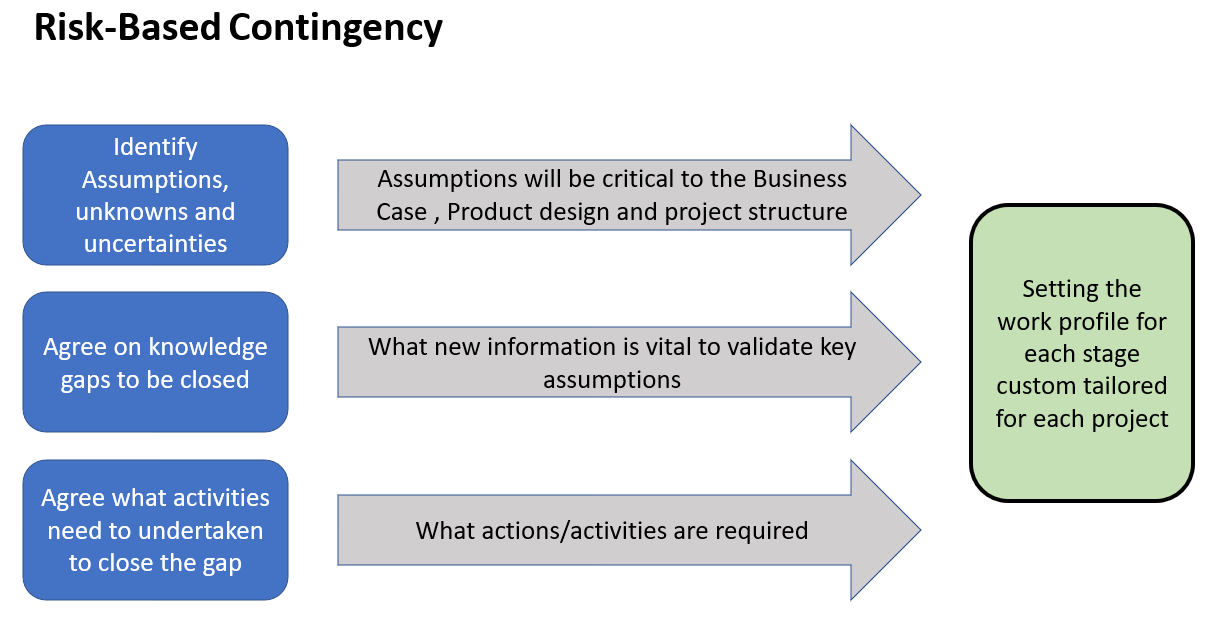
Developing the risk-based contingency approach will require the knowledge of the project team and ties in well with activities such as Customer Value Proposition, which many product/service developments are subject to. This has also led to an extension of the use of Canvas’s developing the assumptions to enable the project team to examine the missing information and potential sources.
As discussed earlier, companies have also developed beyond the traditional 5-Stages to 3 and 2-stage models for different development forms. These can be linked together. For example, a 3-stage Technology project can merge into a 5-stage product development project at stage 2. The issues this might cause are the need for ownership of the technology from the product team and any passion for implementation, or it can be misaligned with the product business priorities.
Again, several solutions have been developed, including;
• Map out the process of the combined system.
• Engage the business gatekeeper into the technology gates; engage business staff in building the business case or market analysis.
• Merge the final stage Pathway of the technology project into one of the three stages 1, 2 or 3 of the product project.
• Provide resources from the R&D department to the business on a transfer basis.
Regarding Go/No GO gates, the stage-gate system is very financially focused, so adjustments have introduced strategic alignment, competitive advantage, and market potential to the measures applied at a gate. For disruptive, Innovative products, market fluidity will make forecasting profitability difficult, so calculations such as Expected Commercial value have been used.
Finally, having tackled the adaptable and flexible issues, we need to accelerate the process, and the hybrid model approaches this by applying ‘lean’ techniques such as Value stream analysis. Looking across the idea-to-launch process seeking to identify the value-added activities and reducing or removing the non-Value added ones, There will be some in this category identified as non-added value but essential to the process and outcomes.
This work aims to identify over-delivery at gates regarding reports and presentations and ensure that deliverables provide clear and essential information for decision-making. This will also help to inform the research and information-generating activities.
In summary, Agile is a micro-planning activity versus the macro-planning aspect of Stage-Gate, meaning that in Agile, the budget and time are fixed for each sprint, and the scope is flexible within the sprint; in Stage-Gate, the budget and time are flexible with the project, and the area is fixed for the project. By combining the best features of both systems, we can expect the following;
• Better communications
• Efficient planning
• Improved customer Feedback
• The more apparent resolution of documentation issues
• Improved team attitudes.

Case Study: PaperCo
Implementing a Stage-Gate Process for R&D and Innovation Projects – Challenges and Enablers – Lund University Author: Emilie Johannesson
The implementation of the Stage-Gate process at PaperCo was undertaken at the end of 2015 to gain a better overview of current projects, improve communication and use a comparable method for all projects. Those purposes coincide with the found enablers for PaperCo. Additional enablers for PaperCo are risk-management for new projects, enhanced possibility to motivate employees to be innovative through feedback and possibly less over-elaborate but rewarding reports and reviews. As suggestions to overcome some of the found challenges with implementing a Stage-Gate, the following paragraphs present some recommendations for PaperCo to consider when deciding how their future strategy with the Stage-Gate process should be determined. The proposals do not all have to be suitable for PaperCo’s future strategy; additional challenges and enablers can most likely be found. Nevertheless, the suggestions are based on the empirical study to view PaperCo’s situation from an external perspective.
INVOLVE EMPLOYEES AND EXTENSIVELY COMMUNICATE THE CHANGE
Based on the interviews, not all employees were fully aware of the need for a change project process; some expressed concerns regarding the Stage-Gate process. I suggest boosting the distribution of Stage-Gate information within PaperCo and all involved in the process. Mature organisations do more often have issues adjusting to changed processes. Thus, the understanding of Stage-Gate benefits for PaperCo, such as improved risk management, project portfolio and simplified communication and reporting, needs to be well distributed. Much of the resistance towards the Stage-Gate at PaperCo is fear of increased bureaucracy; however, as interviewees mentioned, reporting was also an issue in the past. Employees’ mindset needs, thus, to be changed by extensive communication into viewing the Stage-Gate as a possibility for less over-elaborate reporting and instead involve reporting with meaningful content. A key to successful communication is two-way dialogues, where both parties discuss the issue together, for example, through workshops or phone conferences.
The top management has significant power and responsibility during the implementation. By continuous encouragement and involvement in the process, their support and feedback to remaining employees can increase their acceptance and motivation. In most cases, news communication is more limited than overdone. Especially during the implementation phase, managers must be open to questions and present a unified front with a clear and transparent plan for the future. To avoid resistance to using the Stage-Gate, material, guidelines, and templates need to be easily accessible for all employees and involved partners in the process.
AIM FOR CROSS-FUNCTIONAL TEAMS AND ORGANIZATIONAL LEARNING
One of the strengths of Stage-Gate processes is how it highlights benefits with cross-functional teams. Depending on the size of a project, cross-functional involvement can make the process leaner and faster. Therefore, one suggestion for PaperCo is to evaluate essential roles for successful projects and aim towards connecting different expertise in project teams. Another option is to investigate further which knowledge might be lacking in project teams and educate project members within these areas. Cross-functional Gatekeepers can be another beneficial idea to decrease the risks of one-sided focus and optimise the project portfolio. Combining employees with different backgrounds and expertise can increase the understanding of colleagues’ roles and organisational learning.
CONSIDER THE STAGE-GATE PROCESS EFFECT ON CREATIVITY AND INNOVATION PROJECTS
The linear Stage-Gate process approach will increase control and overview over projects. However, it might not add value to innovation projects and stimulate employees’ creativity. As found in theory, a creative environment needs to allow a flexible approach, where project groups are allowed to fail and try again. Additionally, an external input can be of value throughout the process both to certify the customer demand and the competitor’s actions. Therefore, Suggestions to PaperCo are to expand the phase before the Ideation Phase. Aim for an ongoing systemised external analysis to find external possibilities and get inspiration. The study could involve continuous communication with external actors, customers, partners and suppliers. Secondly, allow innovation projects to have an initial failure rate. Encourage employees to try their new ideas within appropriate frames but not in a strictly linear process like the Stage Gate.
DEVELOP CLEAR GUIDELINES FOR GATES AND GATE-KEEPERS
Clear templates for all Gates are essential to prevent increased bureaucracy and overdoing work in Stages or Gates. As the Stage-Gate is instead newly implemented at PaperCo with templates and guidelines, I suggest keeping the templates and project work under observation and letting time and employee suggestions define the most suitable templates. Another proposition is to develop scorecards for Gate-decisions. These templates could, for example, include must-meet and should-meet criteria and help the Gatekeepers judge and compare current projects and position projects in the organisation’s project portfolio. Measures include the strategic fit, an expected financial return or whether the project leverages the organisation’s core competencies. Gate-keepers must be aware of their responsibility and role during Gate- decisions. A suggestion to PaperCo is to develop “rules of engagement”, such as the need for meetings to focus only on decision-making, not information sharing.
ALLOW THE STAGE GATE TO BE FLEXIBLE AND SCALABLE
The process can include different amounts of Stages to prevent the Stage-Gate process from being overly extensive for small, less risky projects or not fully managing the risk in large projects. A proposition to PaperCo is, to begin with the introduced 5-Stage process developed, thus being open for modification and extending/decreasing if needed. By having multiple paths within the Stage-Gate process, the benefits of a unified approach will be kept as well as the flexible structure of the process will accept different types of projects.
To assimilate the possibility of developing radical and incremental new products, design different Gate-requirements for these projects. Thus, the risk of stopping possible beneficial projects can decrease.
ALLOW A PILOT PERIOD AND MEASURE THE CHANGE
As mentioned in previous paragraphs, the implementation will take some time before it is entirely accepted in the organisation. However, to make this period as productive as possible, one suggestion for PaperCo is to encourage project teams to test the Stage-Gate with some projects, give the templates, and structure some constructive feedback. Hopefully, the result will be that PaperCo can find “the way we do it here” sooner and gain employee acceptance. Top management can also continuously measure the process and projects and communicate positive progress, successfully finished projects and learnings to the rest of the organisation to motivate all to keep up good hope. Using the material in reviews after completed or stopped projects can be a way to increase organisational learning and learn both from failure and success. By encouraging employees to fill in review templates and continuously discuss the results, the success rate and the learnings from failure can hopefully increase.

Case Study: Financing Company
There was no formal improvement implementation programme, but there was a four-stage process for selecting incremental improvements.
1. Generation and Selection of ideas arose from the annual strategy goals refined with objectives and key results into OKRs. This was implemented with suggestions from the ongoing Net Promoter Surveys (NPS) with projects ranked by Effort-Benefit assessment.
2. The scope was refined through the Agile squad assigned to the project, most of whom were part of the internal project office. In addition, non-SCRUM activities included interviews, workshops and studies.
3. Development Testing operated under agile rules using SCRUM sessions for information gathering, specification setting and development/Testing.
4. Implement also operated under SCRUM rules with sprints for training and operational oversight in the early implementation stage.
In both the last stages, the sprint weeks varied between 2-4 weeks but with the flexibility to adjust this up or down depending on the content of the activity. Planning and daily reviews were used, including tools such as backlog development, burndown charts and some Gantt charts.
The practical advantages were:
• Better engagement of the internal customer
• Better Visual management
• Perception of progress due to regular deliverables
• Improved internal customer morale
The observed disadvantages are;
• Difficulty in managing internal resources not resourced to the project
• Lack of documentation for process and IT system changes
• Anxiety within the IT Dev team due to being outside the core team
Concerning the core Stage-Gate process, the project selection could be more rigorous regarding value creation. This is not a complete fit from an agile perspective because the hierarchical decision-making process needs to be faster. The performance of the Stage-gate has been significantly affected by the level of internal customer engagement.
Specific changes that can be made would be the temporary assignment to the core team on particular topics such as legal and operations—additionally, the articulation and validation of deliverables to middle and senior management.

Case Study: Telecommunications Company
Focusing on the process of generating, selecting, developing and implementing HR business process improvements, the four-step process is
1. Generation and Selection of ideas emanate from the board-level strategic planning exercise, and the executive board chooses projects. These projects are subjected to an OKR exercise, and then their progress is reviewed every three months to adjust the scope and the team composition.
2. Scope refinement is undertaken with investigations with the internal customer department, which builds the backlog definition; this work, including interviews and workshops, is not SCRUM compatible. During this process, negotiations are held with customer areas for resources.
3. Development & Test is pure SCRUM implementation.
4. Implementation is undertaken under SCRUM rules except for managing the expected changes in business processes. Training is performed with external support from Agile coaches; this training is completed with the process owners in the HR department. Resources are returned to the internal department.
The rules for the SCRUM implementation are 3–4-week sprints, use of Backlog and Burndown and no traditional project management tools. Nine members usually form a team. Teams can be focused on process improvements with no IT technical input. Executive sponsors and supporting managers acta s consultants to minimise resistance and act as the communications channel between the team and the senior management. Coaches are available to help with the implementation of the Agile methodology.
Corning Glass used a hybrid technique when it developed Gorilla Glass; in the development phase, it split the stage into a series of six to ninety-day plans, with each increment having numerous iterations yielding testable product versions. These increments could be weekly or biweekly. This is more like an agile sprint with regular one-day meetings, with each increment having a milestone at which progress can be demonstrated to stakeholders, including senior management and customers.

Exercise
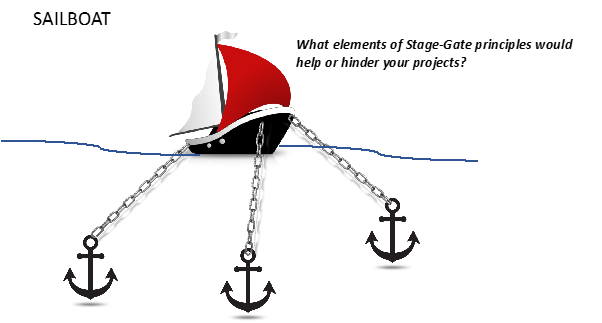
• Our blog posts seem to bring in new clients
• Most of our leads turn into customers
• Clients stay with us for years
• Our support and product team communication isn’t great
• Extensive team upgrades are unpredictable.
• It takes way too long to convert enterprise leads.
1. Introduce Sailboat as a game to show what might hold a product/service or goal back. Ask the players to review the question and then take a few minutes to think about the current features of the product/service or the current environment surrounding the goal.
2. Next, ask them to take 5–10 minutes and write the features of the product/service they don’t like or any variables in the way on sticky notes. If you’d like, you can also ask the players to estimate how much faster the boat would go (in miles or kilometres per hour) without those “anchors” and add that to their sticky notes.
3. Once finished, ask them to post the sticky notes on and around the anchors in the picture. Discuss the content on each sticky note and look for observations, insights, and “ah ah. Notice recurring themes because they can show you where there’s consensus around what’s holding you back.
1. Place or draw an image of a boat on the whiteboard and explain the game’s rules.
2. Everyone writes down things moving us forward as a company on sticky notes. Give ten minutes for this round. (Create as many post-its as you can)
3. People add their notes above the sailboat image one by one and briefly explain what they’ve stuck up there. This helps get a good mood in the room.
4. On sticky notes (of a different colour), write things holding us back or are wrong as a company. Give ten minutes for this round. (Create as many post-its as you can)
5. Instead of presenting this time, each person adds them to the board without explaining them.
6. The facilitator then starts a voting session in Mural, and participants spend the next ten minutes putting their dots on the challenges they feel are most important. Usually, ten votes each.
7. The facilitator reorders all challenges and then puts them in order of votes in each category.
8. The facilitator (or group) then turns all of the challenges with the highest votes into How Might We’re sticky notes (Ignore low-voted challenges)
9. EG: problem: we get all our clients through word of mouth. HMW: find alternative ways to find clients. Place the HMWs next to the relevant challenge.
10. The final round of voting: each person votes on the How Might We they think the group should work on. In a tie or indecision, the group leader can make an executive decision.

Course Manual 3: Technology Adoption
Technology development is complex and risky, but this is further complicated by customers’ and employees’ need to adopt the technology successfully. A typical example is remote working and online tools following the pandemic. We rapidly accepted the way of working that was a norm for freelancers embedding this into corporate business processes.
The key to any change associated with technology is to understand the recipient of the technology, be that a customer or an employee is unique and will react to technology differently.
Technology Adoption has been treated as a lifecycle within sociology circles. Everett Rogers defined the Diffusion of Innovation in 1960. The Theory is that four elements influence the spread of new ideas; innovation, communication channels, time and social system.
The diffusion process comprises five stages: knowledge, persuasion, decision, implementation and confirmation.
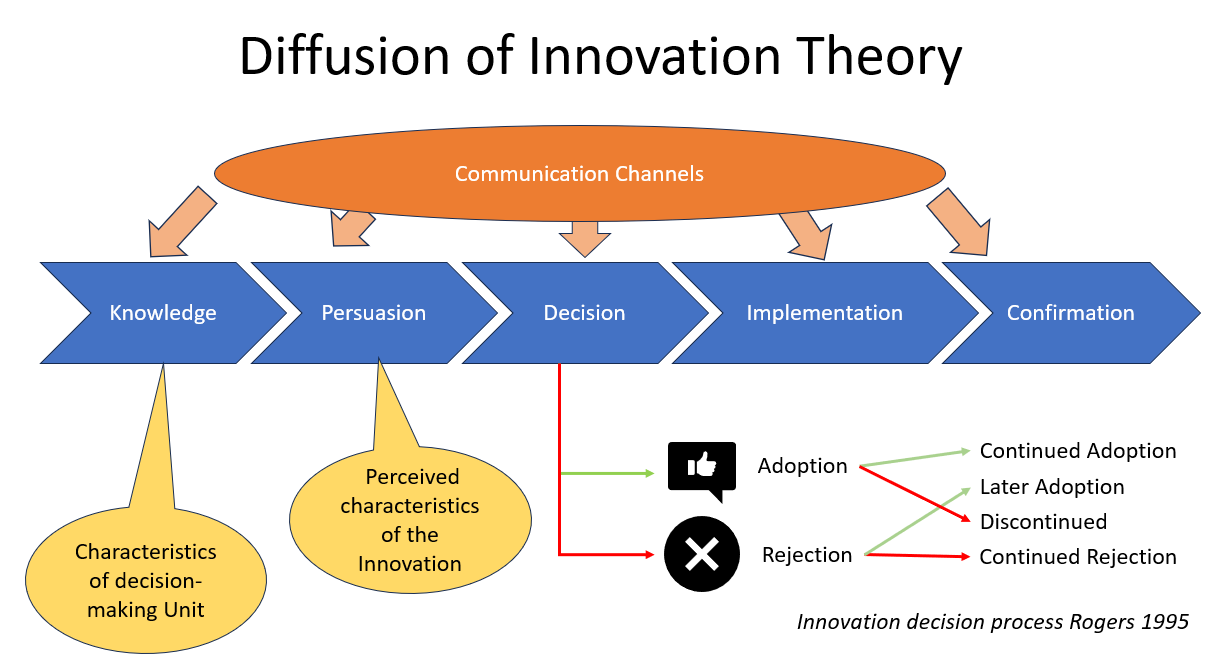
This led to categorising these into five groups of customers or employees, identifying how they will react to new technology. Implementing technology means you need to win over every type of adopter.
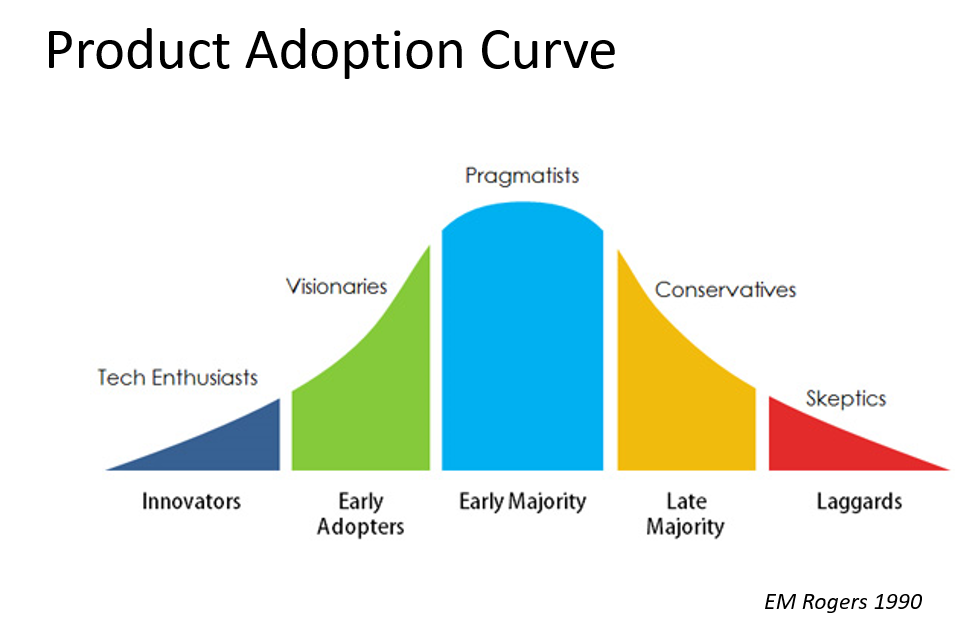
Innovators -2.5%
They are very keen on technology and will accept flaws, like going against the grain and trying new things. They’re the first to upgrade their phones or experiment with a tool during beta testing. Because innovators are rarely concerned about failure, they’re very willing to try new technology. Critical characteristics of innovators are technology enthusiasts, ready to take risks and not think of loss.
Early Adopters – 13.5%
Early Adopters are trendsetters and are willing to take risks. They will only promote a technology once they have a solid opinion. They will test the technology in its early stages and help developers improve it but only recommend it when they feel it will not damage their reputation. Key traits exhibited by Early Adopters are that they are persuasive and willing to work through bugs and setbacks but are concerned about their reputation.
Early majority – 34%
Early majority adopters are keen on technology but need proof of its effectiveness. They will engage in market research and field testing but prefer user case studies to vendor marketing. Key characteristics are logical, practical and data-driven.
Late majority – 34%
Late majority adopters are also data-driven but focusing the need and the value of engaging in it, wanting to avoid risk and questioning the need for change. They do not follow trends preferring to watch and wait to see how the technology pans out with others before acting. Their key traits include being cautious, logical and unwilling to take risks.
Laggards – 16%
Laggards are wary of new technology and will react by asking, ‘What is in it for me?’. They prefer the status quo as it is what they know and will ask questions such as;
• How does this technology benefit me personally?
• Will this improve how my team or I work?
• What’s wrong with the current tool, and what makes this new tool better?
They are sceptical, resistant to change and wary of new technology.
This personality-based profile has been successfully applied, and the gap between the two adopter profiles and the late and early majority is called the chasm. Crossing the chasm is the goal of all technology developers and implementors, meaning the technology has entered the mainstream and is embedded in the organisation’s culture and business processes.
With digital technology, the world is changing faster and faster, and we are constantly adapting. But there is a gap as technology capabilities increase faster than we can use them. Product developers must address the early majority’s concerns and design the product or service accordingly. Building this referenceable cohort will provide the information required by the late majority.
Considering technology implementation, the issue is the same. It requires the early adopters to build momentum by communicating the technology’s personal and business benefits and demonstrations to create a larger referenceable group. These adopters are sometimes called ‘change agents’ and are trained to build consensus amongst their colleagues.
Typical change management tools that are applied include;
• Awareness campaigns using social media and social networking
• Training using demonstration videos, online training and super-users
• Launch events
• Digital process models that provide a walk-through of the process and capture the operating procedures and business rules
Other technology adoption models have been proffered, such as Concern-based decision-making, which considers the adoption through the lens of how this will affect my job and working relationships. It begins with a person becoming aware of technology, following through with research to obtain in-depth information, how this will impact them personally, how they will be managed and finally, collaboration.
There are over ten adoption models, and we will review two Technology Adoption Model (TAM), which examines the motivation of users and analyse their response across three factors perceived usefulness, perceived ease of use, and attitude towards service—the first two factors having a significant influence on the last one. The model can consider external variables such as user training, system characteristics, user participation in the design and the type of implementation process. It ignores social influence and therefore is limited in its application outside the workplace as it does not consider a customer’s emotional context.
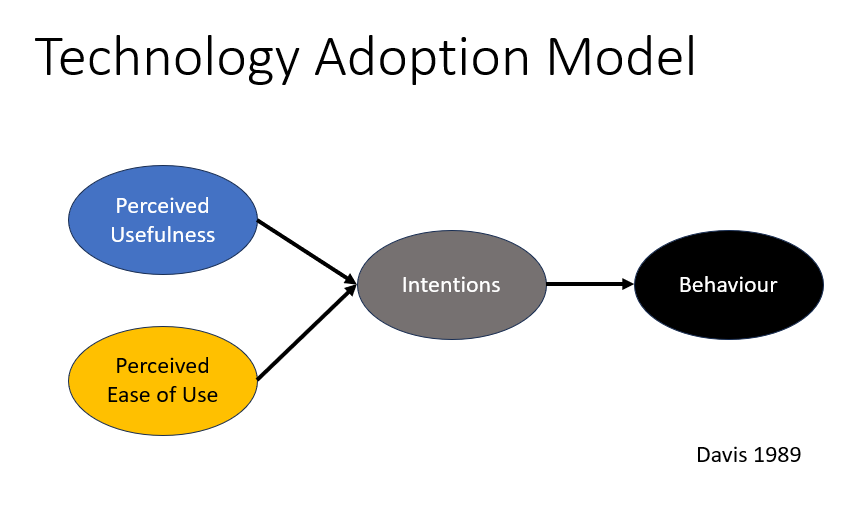
Jared Diamond proposes four patterns to look out for in technological adoption.
• The relative economic advantage over existing technology – for example, Google was not the first entrant into the search engine space, but its algorithm was by far the best.
• Social Value and Prestige – Apple is the classic example. Having built the brand, customers will pay higher prices for devices.
• Compatibility with vested interests – QWERTY is the standard for keyboards. However, its design was invented to slow down typists to prevent typewriters from jamming, but as the keyboard became synonymous with all digital, it remains due to small lobby groups.
• The ease with which the advantages can be observed – use of big data or example, when successful US presidents apply the technology to their advantage, more companies will take note and implement it.
Unified Theory of Acceptance and Use of Technology UTAUT uses the eight of the previous models for assessing acceptance of technology, including These models are Technology Acceptance Model, Theory of Reasoned Action, combined TAM and TPB, Theory of Planned Behaviour, Model of PC Utilization, Diffusion of Innovation, Motivational Model and Social Cognitive Theory. All of these originated in sociology, psychology and communications and defined four antecedents for acceptance being; effort expectancy, performance expectancy, social influence and facilitating conditions. Furthermore, four significant moderating variables were identified; gender, experience, age and voluntariness of use.
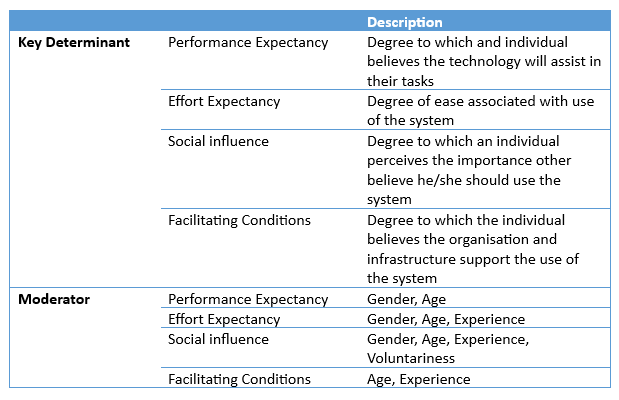
All of the models still relate to the four elements that influence the adoption and diffusion of technology, the innovation itself, communication channels, time and the social system. For internal technology implementations, the social aspect will be the organisational culture.
Reviewing the case studies related to internal technology development and implementation, the first topic is that when technology is developed for market consumption, there is usually a robust eco-system applied covering market research, advertising and sales with a structured target audience in focus. This is not usually the case even when the implementation is of ‘off-the-shelf’ technology; the target audience is varied, and we may need a better understanding of their measures and success and possible misalignment between departments or across different businesses.
If there is a misalignment, this can lead to fragmented internal innovations that satisfy local goals but not corporate ones. This has been called ‘silo thinking’ and can be attributed to inconsistent information and communication, meaning apparently, rational decisions are made with incomplete or inaccurate data. A hidden effect of this thinking is that technology adoption is slow, resulting in slower technology development and adoption, which for businesses is not sustainable.
If we examine adoption communication, we can establish that it defines a pathway for decision-making that reflects these issues.
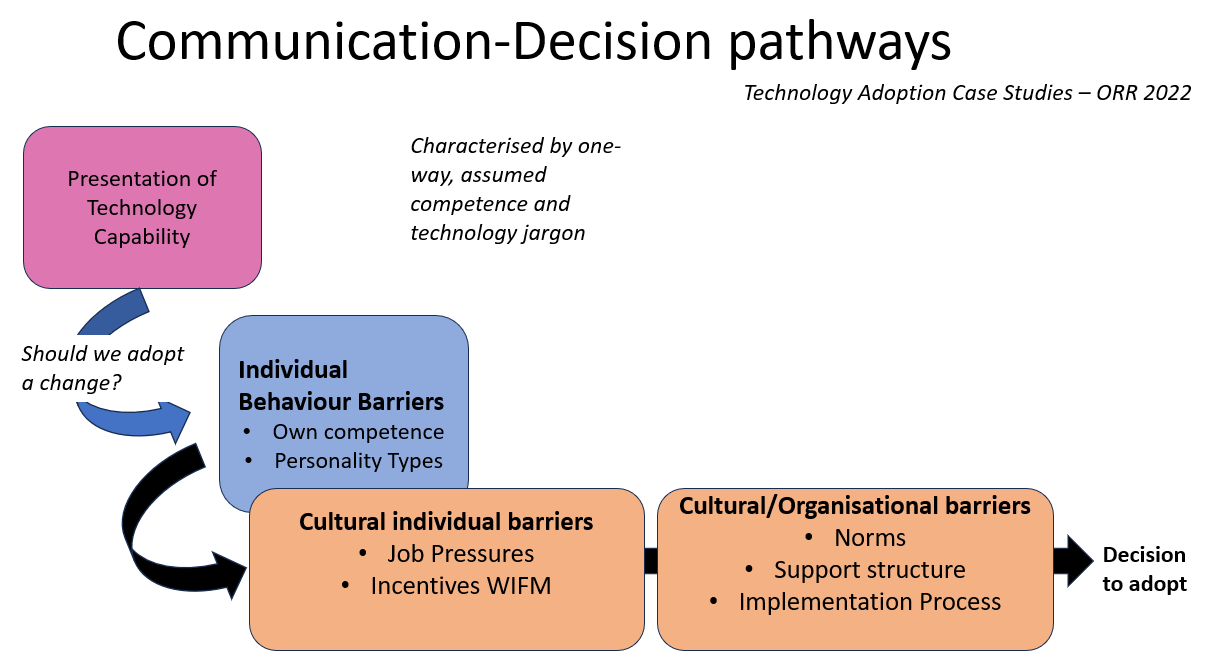
The one-way non-collaborative communication that can be seen in many technology development and implementation cases when the information is being processed by a team on whether to adopt a particular technology, the simple route highlighted by the Diffusion Theory is complicated by;
• Competency & Personality – differences in competence across a team and the potential personality conflicts provide two barriers to making a decision.
• Pressures, Priorities and Incentives – lack of time from the day job, what managers are expecting and the impact of short-term objectives that constantly conflict with long-term development and implementation
• Norms – these can be baked into decision-making processes, mainly when it is considered that a decision to adopt a specific technology went wrong.
• Support and Guidance – poor guidance documents that interfere with the decision-making process by leaving the project team open to subjective judgements
• Implementation Process – this relates to planning, training and stopping the use of old technology; picking the correct project sponsor is critical in this case. Choosing to align this role with either the technology developer or a central resource will result in a rush to complete initial implementation and failure to see through to full adoption.
In many cases, the language used can provide a barrier, particularly if it relates to the underlying technology, not its application; this is a significant issue with Its development and implementation when the vendor can quickly drop into internal jargon, and the message they wanted to communicate is lost.
Assessing and monitoring benefits is also a key issue in technology adoption, again ensuring the WIFM question of personal honour is identified along with corporate ones. Using a simple tool that recognises the different types of benefits and the likelihood of them being achieved will encourage greater management participation. For example, by categorising the benefits into three parts; displaced costs, Improved productivity and increased revenue and applying ratios in high, medium and low achievement rates, the benefit targets are multiple figures.
The final part of any technology adoption is reporting and understanding the lessons learned, enabling other project teams to avoid mistakes and increasing their chance of success. This does not mean exhaustive reports but an honest analysis of where any project has failed and what could have been done differently.
To maximise your potential for adoption success, two areas can be focussed on communication and culture.
In contact, the fundamental principles are;
• Carefully manage the messages.
• Use all media channels at your disposal.
• Ensure that there is a transparent element of two-way communication.
• Collaborate with technology providers and developers to ensure clarity of the message.
• Improve lessons learned, making them easy to transfer, including collaboration with developers and suppliers.
• Use process models, business rules and standard operating procedures to support consistent implementation using models to demonstrate changes and benefits.
Regarding culture, the fundamental principles are;
• There must be a clear statement of innovation.
• Promote a learning culture which should develop organically based on experience, influence, and career path.
• Local culture must be aligned to any core strategy enabling local adoption to create its version.
• Remove the barriers to decision-making by providing good technical support and identifying change agents from the early adopters to promote engagement.
• If their multiple teams appoint local sponsors who have credibility
• Guarantee alignment between various groups and businesses within the planning process to manage regional developments
• Make the planning process AGILE and keep it as close as possible to the SCRUM principles even with complex product implementations.
Further considerations abstracted from other case studies relate to the information gathering and analysis before deciding to adopt. The Theory is that following the usual ‘awareness’ phase and the subsequent steps are ‘principles’ and then ‘how to’. The first phase relates to reviewing available technology to solve the problem; the second to primary evidence of solution efficacy mainly obtained from the supplier; the third is the local application using pilots where the following levels criteria such as compatibility with other technology, aesthetics, strategic functional fit, structural and cultural fit and short and long term costs. The key to effective implementation is to satisfy all three categories.
In a complex implementation context such as hospitals, for example, you may have conflicts between doctors and consultants who focus on ‘principles’ and nurses who focus more on the ‘how to’. This might introduce a longer lead time between the two decision points leading to weak and less successful adoption and implementation.
A typical example would be UV sterilisation technology that brought issues with higher than expected running costs due to costly replacement filters and bulbs and assembly costs on site. The statistics show that.
• If ‘how to’ is addressed at project initiation, there is a 100% implementation success.
• If ‘how to’ is addressed at adoption, there are delays, but eventually, the implementation succeeds.
• If the ‘how to’ question is not addressed at the implementation stage, there is a 100% failure.
No matter which Theory you follow or decide to apply, the one overriding fact is that you must understand your customer, be they internal colleagues, consumers, or suppliers. Without a properly defined and robust segmentation of your target population, any implementation is bound to fail. This profiling needs to identify how each person profiled will make their decision. If we are forming a team for implementation, we need to ensure a balance and not seed it with all the same type of people.
In marketing terms, this would be called the Customer Value Proposition, and it would guide all the messages and channels to use, with different messages for different populations. This same methodology should be applied to internal technology implementations. In external customer terms, we talk about Pains and Gains associated with completing a job that the technology. The Pains can be explored similarly in an internal implementation, but the key question on the gains side is, ‘What is in it for me?’ Getting the answer to this question right for all population types within a project is a difficult challenge as you always come across the ‘Laggards’ who may never accept the change. We will need to seek alternatives for this group, but the project can be considered a success.

Case Study
The first example is the tyre manufacturer Michelin, which successfully implemented a digital adoption strategy in 2016.
Problem:
In 2016, the global tire and mobility company Michelin established three main objectives to tackle specific obstacles:
• Establishing a more customised relationship with customers.
• Creating new business models in alignment with customers’ requirements.
• Modifying the company’s work practices.
Solution:
Michelin’s solution was their “Engage” digital transformation program. It helped them to adopt new technologies such as augmented reality, human-machine collaboration (also known as probiotics), artificial intelligence (AI), and connected objects to enable operators to control their machines using a wrist device.
Outcome:
These digital adoption initiatives helped the company to promote a digital-first culture, optimising employee experience through new skills. The organisation also included a digital adoption solution training platform and awarded a digital certificate to 150 employees in 2018.

Case Study
The second example involves the beauty products company Ulta Beauty.
Problem:
Ulta Beauty, the largest beauty retailer in the US, relies on efficient inventory management to succeed. To achieve this, they invested in a warehouse replenishment system, but despite spending on expensive training and development programs, users still struggled to trust the system’s recommendations.
This situation led to frequent overrides and errors, resulting in excess inventory.
Solution:
Ulta Beauty used a Digital Adoption Platform to make onboarding and training more straightforward and personalised. They added in-app help features to the store and warehouse replenishment system by creating a transparent overlay.
Doing so helped guide users through new and unfamiliar tasks at the point of need in real-time. As a result, there were fewer support requests. Almost all users (96.4%), including management, who had access to WalkMe used the technology and saw benefits such as increased productivity, trust, and employee satisfaction.
Outcome:
Ulta Beauty anticipates the following benefits:
• 114% ROI from their investment.
• Thousands of SmartTip views and Smart Walk-Thru plays.
• Reduced clicks and navigation time.
• Increased productivity.
• Elimination of third-party-led training.
• Reduced support requirements.
As a result of these benefits, there is greater employee trust in technology, creating a more efficient workplace and a higher chance of staff engagement with future digital transformation projects.

Case Study
The third example is a non-commercial one from the Canadian government.
Problem:
Transport Canada, a government transport branch, is shifting its operations to the cloud. This move has multiple objectives, including balancing the demand and supply of IT services, managing cloud adoption risks, and preparing the IT workforce for cloud technology.
Solution:
The Canadian government introduced the Canada Digital Adoption Program in its 2021 Budget to assist Canadian companies in remaining competitive and enhancing growth by implementing digital tools.
The Canadian government plans to offer funding, support, and training to 16,000 small and medium businesses worth USD 2.9 billion.
Outcome:
The organisation trains its staff on cloud capabilities to build internal expertise and change the organisational culture to engage employees in the initiative.

Case Study
Our following example comes from BMO Financial Group.
Problem:
Bank of Montreal Financial Group (BMO) required a support solution to guide customers through new or updated digital features without needing them to call the support centre.
Solution:
BMO supported their customers with in-app guidance, making using new or updated features easier and avoiding confusion. The BMO team also used analytics to track how customers used it and made the necessary changes without involving the development team.
Outcome:
After implementing the digital adoption platform, BMO reported:
• A 50% drop in customer support requests.
• A significant reduction in development costs.
These successes allowed BAM to reduce waste, improve employee experience and grow as an organisation.

Case Study
Our fifth example is courier company RAM had many challenges that they answered with their successful digital adoption.
Problem:
When RAM, a hand-to-hand courier company from South Africa, implemented significant changes in their IT systems, they required an effective and efficient DAP. There were thousands of employees to include in the onboarding process.
Solution:
Fortunately, they had their software, making creating the product experience easier. However, they still faced a significant challenge. Due to time constraints, personalised training was unavailable, and the estimated employee training process was lengthy.
They quickly developed an entertaining interactive guide featuring their mascot, Sam, who provides on-screen instructions.
Outcome:
RAM rose to the top of the market by successfully adopting digital technologies through their digital adoption within this digital transformation initiative

Case Study
Our next series of examples highlight success and failure and the associated misconceptions about the programme. They all relate to models from Network Rail and have been documented by an independent audit.
Case 1 – Plain Line Pattern Recognition (PLPR).
Problem:
Spotting defects effectively was safer, cheaper and faster than using inspectors on the track.
Solution:
This is seen as an example of “successful” technology adoption. PLPR uses train-mounted cameras and image analysis software to spot defects in rails, such as cracks in the steel or missing clips. It is agreed that PLPR was innovative, technically brilliant, had undeniable benefits and had strong support at all levels within NR.
Outcome:
However, the development took more than five years. The supplier explained that they had to work carefully with a tiny group of trusted NR contacts to avoid barriers they had encountered on previous projects. The product was accepted for use in 2012, but 9 years later, 25% of the area where PLPR trains run still needs to adopt the technology. The PLPR trains only run in some places, so less than 60% of the network uses PLPR. Given that PLPR is widely recognised as a successful innovation, this highlights how long it can take for new technology to get adopted across the network.
Case 2 – Expanded Polystyrene (EPS) platforms.
Problem:
Building new or extended platforms with traditional methods requires heavy equipment to manage the concrete and steel materials.
Solution:
Using EPS platforms requires much less heavy equipment and is also helpful in poor ground conditions, where other systems may require piled foundations. NR has used EPS at 86 stations, achieving significant time, cost and risk reductions.
Outcomes:
However, getting technical approval to use the product took three years, mainly because users needed to familiarise themselves with the material and wanted assurance of its long-term performance. This was finally addressed (through lab testing, manufacturer’s warranties, etc.) in 2012. Adoption was very slow, taking until 2019 for four out of five NR regions to use it.
The fifth region (Scotland) is still rejecting it because they remain unconvinced about the long-term performance of the EPS and, after nine years of trying, promoters of the product have not found any mechanism to re-assure them – despite political pressure to adopt it (a Scottish company manufactures the material).
Case 3 – Mobile Flash Butt Welder (MFBW) plant.
Problem:
Improving the quality and speed of track welding
Solution:
The MFBW drives along the track and can achieve a factory-quality weld in 40 minutes versus 4 hours for a manual (alumino thermic) weld of lower quality. This technology has been used in other countries since 1950, and the supply chain has provided it in GB since the 1990s. NR spent eight years developing its machine and procuring 10 of them.
However, the NR developers must clearly explain the benefits or business cases to the users. Some users thought MFBW was intended to improve the welding quality, but the failure rates from manual welding had reduced significantly over the eight years, so they no longer saw the benefit of MFBW. Some users agreed to try the MFBW, but it broke down regularly, so they lost interest. Some users tried to book the MFBW for maintenance work, but because the machines were shared nationally, it was not worth booking them for small jobs. Some MFBWs were used initially, but usage quickly dropped off.
There may still be a good business case for using MFBW on track renewal projects because of the significant time saving relative to manual welds. But users need to be made clear whether the MFBW is still available or if they are allowed to procure MFBW through the supply chain. NR is in the process of selling all 10 MFBW units to another country. NR is currently developing a new welding machine (the Induction Welder) with many similarities to the MFBW – and again, the developers have not clearly explained the benefits or business case to the users.
Case 4 – ‘My Work App’ on-site recording application.
Problem:
Remove the need for paper records or data entry when staff return to the office after asset inspections.
Solution:
This app runs on a mobile phone or tablet. It allows NR users to log information on-site, such as recording the condition of drainage assets during inspections or how much fencing was replaced during a work shift. The app connects straight to NR’s asset database.
There was much negative feedback from users, mainly because the interface needed to be easier to navigate. There needed to be a map to confirm if they were looking at the correct assets on site, and no development team left to address these issues.
One out of the five NR regions (rejected this app altogether and procured a different tool with a better interface. But their device does not connect to NR’s database, creating a significant data handling challenge which continues to cause problems today.
In the other four regions, the Technical Team were left to train more than 1300 staff around the country to deal with their negative feedback and find ways to edit the app software to improve it – a task they are not trained or resourced to do. Now, six years later, NR is developing a new tool to perform the same task (and some additional tasks) with an interface meeting users’ needs.
Case 5 – Wear coating for switch rails.
Problem:
The main issue is side-wear when trains change direction at switches (junctions).
Solution:
This is a tungsten carbide coating applied to standard rails in the factory, preventing the rails’ sides from wearing down as train wheels rub against them. This product is widely used in other industries, e.g. oil & gas and manufacturing.
NR began trialling the product at one site. The team running the trial were technical experts but needed specialist training or guidance on planning and running a research trial. After one year of problems, there was no clear outcome, so the trial was extended. Five years later, the test had been developed for a fifth time and covered six sites, but there was still no precise measure of whether the product passed or failed the trial – or what value the product could provide users. Under pressure to resolve this, NR recently withdrew the problem and did not approve the development. But users are still urgently looking for technology to prevent side-wear; they are not clear on the trial status, and some are contacting the supplier directly to try and find an alternative way to get the product approved for use.
Case 6 – Earthworks work-bank management tool.
Problem:
Users requested a software tool to help them manage their work bank. This is a list of hundreds of projects to be delivered over five years. The word bank constantly evolves as more information comes in from the site and priorities change due to bad weather and funding issues.
Solution:
The users built a mock-up (or ‘proof of concept’) in Excel. NR decided to develop this as part of a much larger tool (“CSAMS”), which aimed to bring together all the data about all their civil engineering assets.
Outcome:
After six years, the CSAMS project realised this goal was not deliverable – and the project descended into a commercial dispute without delivering any of the tools.
In 2019 another extensive innovation programme committed to delivering several tools – including this work-bank tool. For the next two years, users and developers met regularly to discuss progress, but still, no means were delivered, and users had lost trust in the developers.
Case 7 – Structures consolidated database tool.
Problem:
We must combine over a dozen databases covering asset conditions, local geography, and traffic loading.
Solution and outcome:
Same as case 6, the critical difference between them is that the overall programme delivered 1 out of 13 components of the final structures toolkit, and users did not seem to have lost trust in the developers. The concern now is that users and developers are saying, “We won’t see the full benefit of these tools until we complete all 13,” there is a risk of repeating the same mistakes as CSAMS – aiming for a single tool, which is too big to deliver.

Exercise
• Laptop with access to Excel
• Download the version of the Attitude to Technology questionnaire.
1. How well-balanced is the team in technology adoption?
2. Has this affected previous projects?
3. Is there a significant difference between the team attitude and the perceived business attitude?
4. If there is, has this impacted technology projects, and if so, what are the mitigating actions required to fix it?

Course Manual 4: Society
Technology and Society are entirely intertwined and are co-dependent. Technology has helped society grow and thrive through time by solving problems. As the phrase goes, ‘necessity is the mother of invention’. Technology changes the way organisations behave and operate, which in turn affects and evolves their economies. This co-dependent relationship of influence and production has existed for thousands of years, enabling the agricultural revolution, followed by the industrial and digital. These last two development cycles have moved away from the model created in the farming cycle, enabling societies to move forward in social progress and diversifying economies.
Technologies solve societal problems, altering human behaviour and operations in society, which can result in different economic conditions and situations, leading to the cycle starting again.
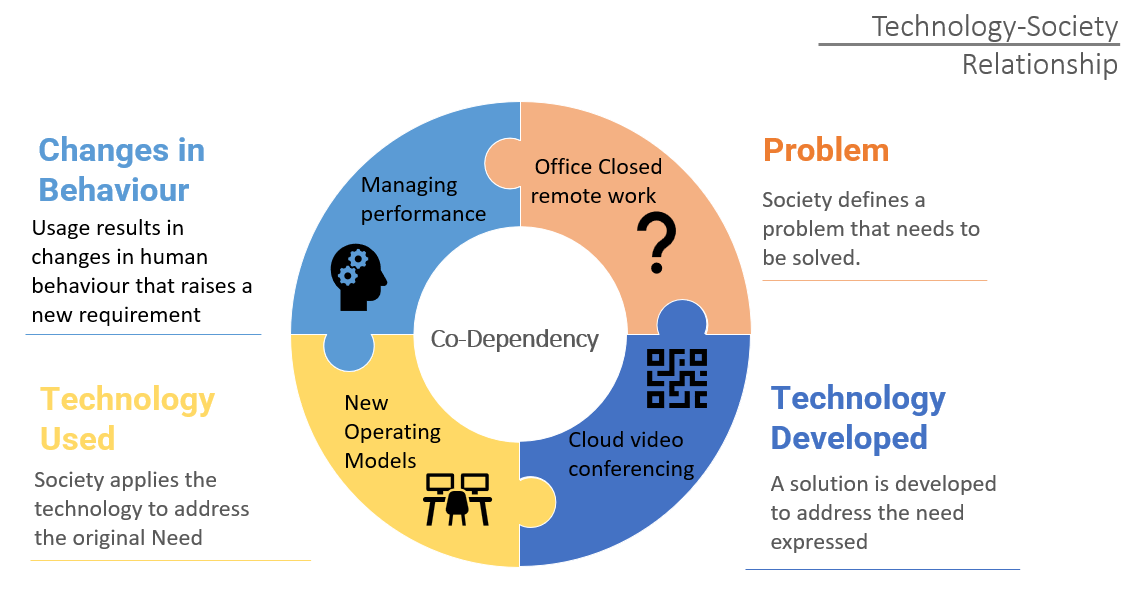
Technology is any application engineered or created using applied science/math to solve a societal problem. From wheels, ships and telescopes to computers, robots and the internet. The fast pace of the digital revolution includes AI, blockchain, quantum computing and personal devices.
Society is a group of people living together in a community that includes some form of governance/government (laws, roles and economy). Throughout history, societies have risen and fallen with technology at the helm. The oldest civilisation based in Mesopotamia saw the Sumerians invent the wheel, ships, irrigation systems and metallurgy. Technology impacts all areas of society, from the military, cities, and health to language and communication.
Technology has impacted every day solving problems and making it easier to complete a wide variety of tasks. From farming to building cities, they are making travel more convenient, linking countries together, thereby creating globalisation, making it easier to grow economies and helping companies do business. Virtually every facet of human life has been impacted, reducing problems in one way but creating others.
When reviewing technology’s impacts on society, we begin with those seen as positive.
Mechanisation of Agriculture
One of the first areas of impact and still in progress today with machines and, in some cases, robots supporting the whole cycle from land preparation, sowing and harvesting. Using drones and plant status sensors enables farmers to manage larger land areas without wasting time and fuel travelling. An automatic record of the situation date is also stamped for future reference.
These technologies have also been combined with tracking tests such as locusts and destroying swarms before they fully form by combining sophisticated mathematics, drones and pesticides in areas under threat.
Improving global communications and the wide adoption of smartphones and tablets in places like Africa and Bangladesh have begun to provide modern agronomy advice to smaller farmers on specific areas and crops.
Improvement of transportation
Technology in transportation varies from train driver aids such as signalling to online ticket sales and automated barriers and electronic travel passes. As battery capability has developed then, electric vehicles are growing in sales and have been applied to public transport through buses and trams. CCTV has made travel safer on public transport and in taxis, as potential bad behaviour is discouraged.
Improvement on communication
The most ubiquitous application of technology for most of us is communication with core technologies such as 4G and 5G, Bluetooth, WIFI and the Internet of Things (IoT). We have become accustomed to being wholly connected no matter where we are. Devices ranging from smartphones, tablets, Home assistants, security cameras, washing machines, and home boilers can be connected to your private network, activated and monitored 24/7.
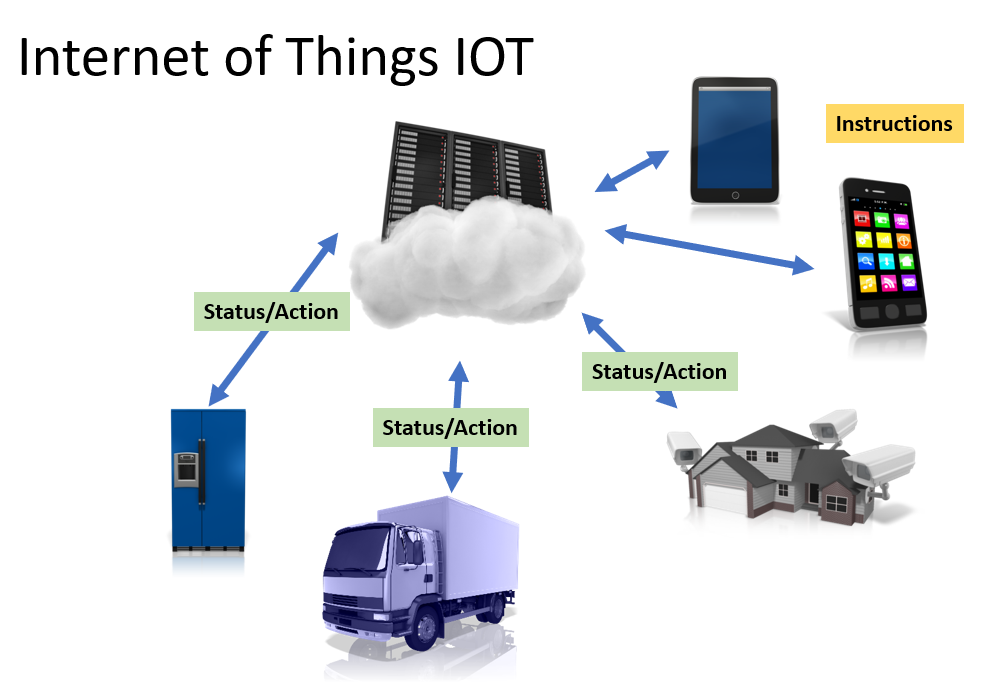
Video conferencing has spread rapidly following the pandemic, becoming the staple operating model for freelancers and corporate businesses. This has also impacted travel, reflected in the later section when discussing sustainability. Zoom is the classical case study we highlight below.
Standard telephones have been transformed into video devices through VOIP, improving the efficacy of team and customer support calls. Sometimes, the User interface is a tablet that can be removed and used separately to undertake other tasks.
Improvement in education and learning
Once the internet took flight and became the source of information, it hs the key was searching it, and that led to several start-ups defining search engines, the most successful being Google. The greater access to information enables us to build up skills and capabilities and undertake those one-off tasks by watching specialists operating on YouTube, for example. Car Owner manuals have also become digital and are now available through the infotainment system.
There has been a significant impact on education and learning systems with materials accessible online. Again the pandemic drove the need for this as classrooms could not be populated. Specialist trainers took their material online and have begun integrating this with video conferences in webinars to create the element of question and answer. The latest developments in training are now emerging as conversational learning, micro-elements of knowledge that are delivered by messaging with instant feedback, marking and surveying of the delegate’s capability and confidence.
In summary, lifestyle changes that technology has introduced are more convenient, enabling us to perform tasks quicker and more simply.
So if there are positive impacts of technology, what are the downsides?
Depletion of Resources
Fossil fuels drove the start of the industrial revolution, and this is still a significant resource being consumed to develop energy, propel vehicles and aircraft and produce basic materials such as steel and concrete. Now seen as a substantial contributor to Climate Change, the technology aims to reduce its impact. However, this is driving the consumption of other resources as we seek to build new power sources, mainly electric. Solar panels and batteries consume rare minerals such as gold, coltan and tantalum.
In pursuing alternative fuel to propel vehicles, technology has developed bio-fuels that use plants as their base, removing food from the supply chain and destroying swathes of natural habitat.
Population increase and health concerns
Even though science has enabled us to control population growth through contraception and, in some states, through laws to limit family numbers, technology has also facilitated a longer life span and greater food production productivity. Which, without both natural and artificial disasters, would man an abundance of food globally.
The significant negative impact is that the convenience afforded by technology has made our lives more sedentary, increasing the likelihood of health problems further compounded by poor food choices presented within fast and processed foods. Online working and the extensive use of computers expose us to ‘Blue Light’, and introducing EMF through mobile communication devices can lead to immune system dysfunction.
Pollution increase
As discussed earlier, from the initial industrialisation and the use of fossil fuels, we have continued to pollute the atmosphere, oceans and ground with the waste from mining, energy production and single-use plastics. We discuss this more in the plant and sustainability sections.
But it is the technology itself that produces these effects or the way we apply and use it.
Looking at online shopping as a case in point, we can now buy anything online, from cars to food and get them delivered to our door. This has not replaced the need for physical retail spaces, and the market may be to try items on or take a test drive, but it has provided levels of convenience we could not imagine. At the POS in retail outlets, the experience has changed massively with a tap of the chip and pin device or, more likely, now the smartphone. The retailer gets their stock immediately updated, issues the receipt via e-mail, and updates the contact list and customer relationship system to maintain the loyalty scheme. This enables regular product updates via newsletter and discounts for introducing a friend.
Decoupling the ability to develop a retail business from the need to own/rent a building asset has democratised retail. Growing web shops can do this easily with many tools to create shop fronts, product catalogues and shopping carts with links to payment systems such as Stripe. There are now freelance creators online ready to develop logos and marketing messages.
Hybrid business models are now emerging, driven by the likes of Amazon, where they provide fulfilment activities, sweating their storage assets to hold the online retailers’ stock. Etsy performs the marketing function by featuring independent retailers and makers in their shop front and charging a monthly fee.
The technology has massively simplified the purchasing process, removing manual tasks and improving data. Buying from Amazon requires you to specify the item, delivery and billing address so you take responsibility for the whole process.
Social media is the most seismic impact made by technology within society, through the channels of Instagram, Tik Tok, Snapchat and Facebook, with businesses also using it to manage their online presence and measure their customer’s opinions on services and products. It has enabled several critical societal commentaries and movements but has significantly increased our vulnerability.
Monitoring your health has increased massively with medical devices for Blood Pressure, diabetes, sleep and general fitness. Again an example of people being asked to take responsibility for their health and only request help when the readings are not as expected. So convenience and access to support are simplified alongside ordering prescription medicines and doorstep delivery.
Reviewing the technology employed in the health service beyond that applied in hospitals, the change over the last few years has been dramatic. The population increase and longer lives have strained primary care, and the pandemic brought this into sharp focus. Doctors’ appointments were mainly held online or by telephone, which has continued.
Self-monitoring key indicators such as blood pressure has now been extended to diabetes with remote monitoring and data recording held in a database for use by the GP. Other diabetes innovations include sensors for real-time recording of glucose levels to trigger insulin injections or to provide data to fitness monitors on the wrist. ECG measurements can be conducted at home and the physician can then analyse the data collected.
Robot cleaning machines can undertake better deep clean activities such as using UV light to remove bacteria from wards and theatres. Finally the use of Ai in the area of cancer detection is proving to be very successful from a more thorough reviewing breast scans to enabling the prediction of the disease years ahead so that preventative medicine can be applied.
Spending more of our lives online; recent stats say this can be as much as 6+ hours per day from shopping on Amazon, catching up with friends on Snapchat and Instagram, gaming, and researching will increase our vulnerability. Not only personal data now but access to business data as more remote working takes place.
People are notoriously poor at password management; a recent review found that 12345 was still the most used password with over 70% of applications. Technology is available in the form of password managers for maintaining and suggesting more secure versions; tools to protect online use exist, such as VPNs and malware and ransomware detectors.
Technology has massively impacted youth’s attitudes in the last two generations. Having been brought up with digital technology, this has become native to how they operate, their attitudes to privacy, and the skills they need. It has sometimes de-personalised human interactions, making them socially awkward, unable to communicate quickly, and finding creating relationships difficult. In some cases, people have commented that this creates a separation from reality within some parts of society.
Business was forced to rethink its working models with the advent of the pandemic. Though hybrid working models have been slowly developed, remote working is forever set in the business model. Within the supply chain, this includes the greater use of freelancers, creators who work remotely in skills supplying skills such as graphic design, marketing, presentations and videos. Digital technologies have also facilitated new business models such as subscription services for maintenance, printer cartridges, cooking recipes and media (photos, clipart and presentation templates)
Two business models that have emerged recently cover groceries and the consumer and building hardware supplying tradespeople. Examining the business model for Supermarkets, the competition is fierce and defining and maintaining your value proposition is vital. In the UK market, there was an established order with the key players being Tesco, Sainsbury’s, Asda, Waitrose and Morrisons; value propositions tended to play to class stereotypes, disposal income and beliefs and causes. This all changed when the two European discounters entered the market, Aldi and Lidl, challenging all the underlying assumptions about shoppers’ behaviour.
Most of these companies extensively use technology such as ;
• Loyalty cards to offer discounts and encourage return visits
• Social media that promotes product discounts to loyalty card customers
• Online shopping and doorstep delivery or click and collect
• Extensive stock lines beyond groceries, from mobile telephones to insurance, clothing and housewares
Building hardware supply companies have managed their storage assets to provide more than just online shopping for the hardware itself but also tool hire with delivery to location quick enough that the job the tradesman is on is not held up.
Most fashion brands also use technology extensively, understanding that retail shops are used for purchasing and showcasing. This includes the outlet stores which process older stock at lower prices. Signing up for brand membership is integrated into the retail payment process to provide the sale invoice to your e-mail. Having captured your data, social media and newsletters provide ‘loyalty’ discounts or ‘early’ viewing of new ranges.
Finally, technology has moulded and evolved human behaviour, making us increasingly dependent on it and, as natural creatures of comfort, seek more and more convenience.
Used correctly, technology can be your friend but scrupulous, and criminals can utilise it for their ends, such as identity theft, terrorism (malware and ransomware), defamation of character and sexual exploitation. Ease of use has driven up gambling and addiction and created a new habit in the form of gaming. Cyberbullying has intensified this nauseous attack on an individual, making it easier for more people to be involved. A recent survey in the UK stated that 46% of girls had low self-esteem driven by this sort of action through social media.

Case Study
Preamble – According to a survey by Uk End to Loneliness, half a million older adults go at least five or six days a week without seeing or speaking to anyone. Improving the living conditions of older adults and improving the financial and service performance of care workers is required; whilst respecting the dignity of these older adults and providing peace of mind for family members without the need to make long stressful journeys whilst being able to monitor health care 24/7.
Approach – a managed service deployed to the older adults’ homes using a desktop robot linked to a care worker and a central management system. Families can see progress and updates on a companion app. The robot enables users to stay connected with their communities and healthcare professionals through a user-friendly interface and video calling to care workers and family members. The app allows family members to engage in video calls and monitor their relative’s health. The care portal provides a management system for care managers to allocate remote visits to care workers, connect to community services and automate health reminders to all users on the system.
Value –
• Better care delivery
• Increased trust in care provider
• Faster adoption rates of technology
• Regular contact improves health outcomes

Case Study
Preamble – Jeff Bezos, a computer science and electrical engineering graduate from Princeton University, founded the company. He did not know much about the Internet. But, he came across a statistic that the Internet was growing at 2300%, which convinced him that this was a significant growth opportunity.
Jeff Bezos was one of the few people to understand the unique nature of Internet Retailing and E-Commerce. This is how he compares E-Tailing to traditional retailing; our essential trade is real estate for technology. Real estate is a vital cost for physical retailers. That’s why there’s the old saw: location, location, location. Real estate gets more expensive yearly, and technology gets cheaper yearly. And it gets cheaper fast.
There were two elements to his vision-
1. He wanted to build the world’s most customer-centric company
2. He wanted to establish a place where customers could buy anything.
This is how he characterises his vision of customer-centrism:
Our goal is to be Earth’s most customer-centric company. I will leave it to others to say if we’ve achieved that. But why? The answer is three things: The first is that customer-centric means figuring out what your customers want by asking them, then figuring out how to give it to them, and then giving it to them. That’s the traditional meaning of customer-centric, and we’re focused on it. The second is innovating on behalf of customers, figuring out what they don’t know they want and giving it to them. The third meaning, unique to the Internet, is the idea of personalisation: Redecorating the store for every customer. If we have 10.7 million customers, as we did at the end of the last quarter, then we should have 10.7 million stores.
Approach – Amazon strived to understand what was unique about the Internet when developing a customer-centric company; in an online world, you have the opportunity to develop intense relationships with customers, both through accepting the preferences of customers and then observing their purchase behaviour over time, so that you can get that individualised knowledge of the customer and use that individualised knowledge of the customer to accelerate their discovery process. If we can do that, the customers will feel intensely loyal to us because we know them well. Jeff Bezos
To emphasise, customers have stated that they go back repeatedly because of the range of products and the reliability of service, only sometimes the price. If you hit the three critical elements of customer service, convenience, selection and service, loyalty will follow.
Value:
Since its formation in 1995 and its first recorded returns, Amazon has gone from $147 million to $469 billion. It has a net income of $33.4 billion from a range of products and services, starting with books, household items, stationary, tools, materials and cloud computing.

Case Study
Preamble – Imperial College Healthcare NHS Trust provides acute and specialist healthcare in northwest London for around 1.5 million people annually.
The trust’s care home liaison team, known as the Frailty Team, works directly with 26 care homes within the region to provide support, education, and expertise to staff to ensure their residents are kept safe, well, and out of the hospital.
In 2020, Imperial’s imperative was to minimise avoidable hospitalisation of frailty patients to protect them from the life-threatening coronavirus.
The key issues that need to be solved are;
• Limited clinical support within care homes
• Lack of contextual data during patient assessment
• Frailty patient vulnerability to coronavirus
Approach – The Frailty Team used Current Health, a remote monitoring system, to minimise care home resident Emergency Department attendance and hospitalisations, thus reducing the potential exposure to COVID-19. The system enabled;
• Vital sign capture from residents
• Clinical insight and remote assessment
• Informed decision making
The interventions by the team resulted in:
• 44% advising on how to manage high-risk patients
• 32% Monitoring and revising medical plans
• 9% Advising on the clinical efficacy of care plans
• 6% referral to physiotherapy
• 6% advise on ambulance service to the Emergency Department
• 3% add medical equipment to the care plan
Value – This resulted in 3 months, with 92% of patients using the service to 87% of residents not admitted to Emergency Departments but dealt with remotely, a reduction of 1.5 days on inpatient stays, released a potential 144 bed days—a total cost saving of approximately £62,000.
Preamble – Traditional video conferencing technology was essentially an extension of telephone conference calls with the addition of video. A point-to-point solution in which participants dial into the meeting or are called to attend. For this approach, local IT departments maintain the infrastructure. Zoom has become a reliable conferencing option for freelancers, remote workers and businesses.
Approach – Utilising Zoom’s meeting room functionality, operating in the cloud, anyone can drop into a meeting room and wait for the host to open the meeting. Thereby providing a seamless capability of both meeting room and conferencing facility. Zoom also provides the ability to improve upon the traditional experience by leveraging more recent stuff. Because it seeks to provide users with more awareness and control of the incident, Zoom has expanded on the basics with features such as contact presence status, multiple contact meeting invitations, active host transfer, and participant control for mute and cameras. If you are using other conferencing standards, Zoom supports connecting both Cisco and Skype for Business (Teams) conference systems to its virtual meeting rooms.
Value – The primary benefit is cost saving by reducing the need for IT infrastructure tied to physical meeting spaces. Using SaaS applications in the cloud can make conferencing and meeting room management a seamless and enjoyable experience. The pandemic drove Zoom’s growth from 10 million to 300 million users in 3 years.

Case Study
Preamble – Ocado has the vision to transform the world of grocery shopping by providing grocery solutions to its customers through an Ocado Smart Platform OSP solution. This platform combines several technologies including AI, Machine Learning, robotics, IOT, and data science. Enabling OSP customers to meet their shopper’s expectations no matter how fast they change.
Approach – To achieve this efficiency level, OSP operates on Amazon Web Services AWS, enabling Ocado’s development team to deploy 14,000 changes per week to applications and cloud environments. This level of rapid innovation requires agility and automation components readily available in the cloud. OSP sites received 1.6 billion views in 2021, so scaling up quickly is a crucial requirement and achieved through fast and efficient storage and processing power management, which exhibits low latency.
Value – Ocado has revenues of $2.2 billion and cash liquidity of £1.3 billion but is still making a profit. This is anticipated a`s the new suite of services is implemented. Customer growth is strong, up 13%, and the unique services promises improved Target Operating Efficiency by up to 50% based on Units per Hour. Growth is strong overseas, with new clients in Europe (Poland), South Korea, Japan and Australia.

Exercise
• Post-it Notes, whiteboard and pens
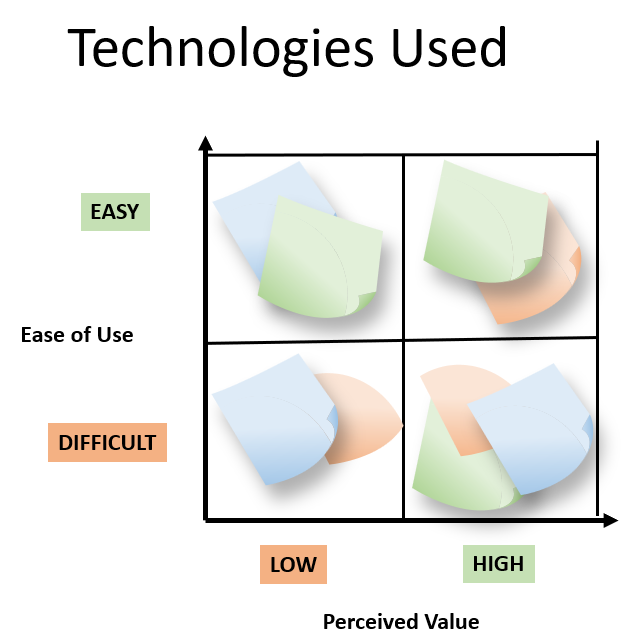

Course Manual 5: The Planet
Technology has dirtied the earth, air and water for over a century. We can consider the impacts and discuss some solutions in four areas, Energy Pollution, Climate, Water Quality and Waste Clean up.
The damage to the planet has been significant since the first industrial revolution and the extensive use of fossil fuels to generate power from steam to electricity. Nuclear Power was seen to be one of the solutions. Still, the costs of decommissioning and storing waste safely for hundreds of years and the disasters at Three Mile Island, Chernobyl and Fukushima made the world wary about investing in this technology.
Alternative fuels, such as wood chips, have been developed to replace coal, and technologies such as Flue Scrubbers and catalytic converters are applied to clean exhaust gases.
Petroleum products provide transportation energy, and massive progress has been made to clean up emissions from cars, trains and aircraft through better management systems using remote sensors and AI and the application of exhaust outputs with the like of Catalytic converters.
As well as Greenhouse Gases, industrial and transport emissions include nitrogen oxides, which are detrimental to water quality as they act as fertiliser—promoting algae growth in lakes and rivers, which creates eutrophic conditions that kill submerged aquatic vegetation. This same phenomenon is caused by agricultural runoff. Technology is now applied to this problem using Geographic information systems GIS which uses remote sensors to identify sources of runoff. Topography and soil data digital maps can be developed by combining land use information with hydrology. Real-time data can supplement this with farming activity gathered from aircraft and satellites.

GIS supports the developments in precision farming practices such as real-time crop health data, Sensors in harvesting equipment guiding a more discriminatory application of pesticides and fertilisers and which part of the crop to harvest first.
Considering waste clean-up includes the spoil from mining operations and contaminated land Resulting from industrial activity. In this latter category, we have used excavation and burial to resolve the issue. Bioremediation is an alternative solution by importing engineering organisms; these have been successfully used to treat wastewater, industrial effluent, and petrochemical spills. As with many genetically modified technologies, such as plants, for improved food production, there are concerns that we need to know the long-term consequences.
Mining is a high-energy consumption activity responsible for deforestation, landscape
degradation and water and air pollution; carbon monoxide and dioxide are released into the atmosphere, and the wastewater leaches back into the water table. There are multiple examples of this, such as Cobalt mines in the Congo, Lithium despoiling in the Chilean desert and lakes of toxic sewage in Inner Mongolia.
The various types of mining, such as surface, underground, in-situ and placer, are vast emitters of Greenhouse gases and represent 19.1% of all these emissions globally. This could grow as the demand for clean technologies creates more demand for minerals such as Lithium and copper.
The extraction and processing of minerals and materials from gold to lithium also use large quantities of water. Water pollution has been measured in western watersheds as 40% from acid mine drainage and heavy metals. The acid drainage is down to sulphuric acid being created from the exposure of the rock; and can remain decades after the mining has finished.
Toxic waste in the water systems affects aquatic life and any terrestrial life that feeds off marine life. Every government has strict regulations, but even well-managed will pollute the water and air.
So how is mining trying to reduce its impact on the planet? The answer is through renewables such as solar and wind turbines. Traditional large open-cast mines are a well away from power generation and distribution centres; for example, one mining company has targeted to reduce its Scope 1 emissions by 71% by 2030 using a combination of renewable power, battery storage and equipment electrification. This drive for renewable energy is also self-serving as it will reduce the energy bill of miners, which presently sits at 15%-40% of total operating costs.

Geography will play a part in which renewable is best suited; deserts and flat landscapes fit solar solutions and mountainous regions wind energy. Governments in the US and Canada are providing incentives to encourage more renewable use, which makes sense as the cost of renewable projects decreases. Recent figures for solar projects show that since 2013 costs for the construction of grid-scale plants have dropped by 55.3%, whilst gas-powered plants have risen by 15.7%.
Considering all the routes for water pollution from mining to agriculture and food processing, how are we applying technology to address these issues? Considering water treatment first for removing contamination and preventing contamination in the water system, there are several exciting developments, Such as using contaminated water and turning it into drinking water in less than 30 minutes. A small tube the size of finger uses activated carbon s this core technology. The device is so practical that it has become a must for camping enthusiasts and inhabitants in remote villages. Similar devices use a chemical reactant followed by a sand/gravel filter. Farm-based water filters using disinfectant can be fitted to the top of boreholes with a hand pump.
Applying natural solutions can be seen in the application of wetlands. In one case study, wetlands removed over 84% of all suspended solids for landscaping, less than $100k. Bioremediation has been applied to address agricultural runoff by using specific bacteria and fungi to break down pesticides and fertilisers into less harmful products. Combining this thinking with single-use plastic has created floating wetlands with aquatic plants riding on rafts of single-use plastic, absorbing contaminants in roots and foliage like magnesium and iron.

Nanotechnology has seen several successful applications in water treatment. This technology uses the manipulation of materials on the nanoscale (between 1 and 100 nanometres) to create new materials and devices with unique properties. A sheet of paper is about 100,000 nanometres thick; some examples are provided below;
• Iron nanoparticles have effectively removed arsenic, chromium and lead from water.
• Creating a Nanofiltration membrane using the like of carbon nanotubes or graphene oxide can be applied to the removal of heavy metals.
• NanoBubbles work well in pharmaceutical and pesticide removal, with success rates above 60%
• Nanostructure absorbents are materials created to maximise the surface area to attract and bond pollutants to the surface. One material this has been particularly successful with is Polycyclic Aromatic Hydrocarbons (PAH)
Electrocoagulation techniques apply an electrical charge to water, creating metal ions that attract pollutants and coagulate into large masses for subsequent removal. This technique has been used to remove bacteria and heavy metals and has succeeded in mining, Oil and gas production, refining and food processing.
More complex solutions can be found by treating wastewater within a building complex. They convert the extracted solid wastes into the soil and use the treated wastewater for toilet flushing and irrigation.
Air pollution results from our application and demand for technological advances. Mining creates dust particles in the air, as does the smelting of metal that releases sulphur dioxide. But by far the most damaging is the release of greenhouse gases from burning fossil fuels to generate power, conduct industrial and food processes and transport.
Greenhouse Gases GHGs are those gases that, when in the atmosphere, retain the planet’s heat during the night, raising the average temperature of the earth and causing climate change. They are specifically carbon dioxide, methane, nitrous oxide, water vapour, hydrofluorocarbons, perfluorocarbons and sulphur hexafluoride. These last three gas ear artificial; they exist in small concentrations in the atmosphere but are very potent; for example, sulphur hexafluoride is used in High-Voltage electricity equipment and has a Global Warming Potential of 23,000 times that of Carbon Dioxide.
The other gases occur naturally, but we have increased their atmospheric concentration. For example, Carbon Dioxide concentration has increased by 50% since the 1800s due to the burning of fossil fuels. Methane results from decomposition, but cattle farming, landfill, rice farming and oil and gas production have increased their concentrations. Nitrous oxide is produced through the large-scale use of commercial and organic fertilisers, fossil-fuel combustion, nitric-acid production and biomass burning.
E-waste is another form of waste due to the rapid growth of consumer electronics such as smartphones, tablets and gaming accessories. The statistics show that globally we dispose of $62.5 billion in consumer electronic technology annually. There is growing recycling, but the majority, more than 80%, still ends up in landfill, which in some cases is in the poorest regions in the world. Chemicals such as mercury can leach into the land, and the working conditions are hazardous. More recycling and recovery of rare minerals would reduce the level of mining. This could lead to a circular economy, but technology companies still would instead promote consumerism than restoration and regeneration. There is a strategy to build in obsolescence.
Air pollution is a significant health hazard, 9 out of 10 city dwellers worldwide breathe unhealthy air. We have applied technology in various ways to address using catalytic converters on vehicles that turn carbon monoxide to carbon dioxide, Nitrous oxide to nitrogen and carbon dioxide; even though carbon dioxide is a GHG, it is better than carbon monoxide. The other side effect of this technology is the use of rare minerals platinum and palladium.
We have applied flue scrubbers to the gases emanating from industrial processes; these technologies use wet or dry streams within exhaust flues to remove harmful particles and gasses such as sulphur dioxide, chlorine, Hydrogen sulphide and hydrogen chloride. The GHG hydrofluorocarbon was designed to remove the need for two other gases, chlorofluorocarbon and hydrochlorofluorocarbon, which were widely used in solvents, aerosols and refrigerants. The names are similar. The key was the removal of Chlorine.
Several innovations are being developed and tested in city environments, such as fuel replacements for diesel engines. Gas to liquid has shown reductions in particulate matter of up to 38% and the same for NOx. Dimethyl Ether has a similar effect on NOx. Neither of these needs any engine modifications. We can improve the burn within diesel engines with hydrogen additives, again reducing NOx outputs.
Looking beyond the engine of trucks, we find that refrigerated trucks that use auxiliary power units are entirely unregulated, and these units produce 29 times the particulate matter and six times the NOx. Alternative technologies, such as Liquid Air, can realise zero emissions.
Photocatalytic materials on surfaces such as roof tiles, walls and roads absorb particulates and NOx; the results have been mixed. Finally, we come to air purification; a Dutch Company has developed a tower that claims to clean 3.5 million cubic meters of air daily with the pollutants converted into jewellery.
The impact of poor air quality goes beyond clear lung and heart diseases to eyesight, infertility and long-term cognitive effects. Tackling air pollution in significant conurbations takes work. Where do we start, and what tools are at our disposal? London is recognised as one of the leading cities in the drive to improve air quality; its Ultra Low Emission Zone ULEZ charges the most polluting vehicles. But the key to any action is data, and research states that less than half of all governments gather or share air pollution data. To prove that lower-cost monitoring sensors and their data can be effective was the target of a project named Breathe London.
The core of the technology was one hundred low-cost sensor pods and two Google Street View cars to complement the existing ULEZ actions. The lessons learned are captured below, following the two-year study.
Target the timing of the action –using low-cost monitors that are more portal, data can be collected at locations where people live, work and visit and when the exposure is highest. For example, placing monitors outside schools, the data showed that there was a morning and evening peak. They enabled the planners to target outside activity in times with little exposure.
Find Pollution Hot Spots – Understanding the most polluting areas makes actions more effective. One of the areas of the study compared the air pollution in a residential street to that close to a bus garage. The difference in data showed NOx levels twice that at the garage than the nearby street and the exact times when the peaks occurred. This enabled the local government to enforce the non-idling of buses outside the garage and drive a faster upgrade of the whole fleet.
Measure the Impact of an Intervention –The impact of the ULEZ proved that it had reduced the Nitrogen dioxide level by 25%; during the lockdown, the levels fell a further 33% between 6 am and 10 pm.
Raise Awareness – presenting the data gathered by the monitoring sensors in ‘real time’ through an easily accessible platform enables the local population to understand the issues, the times of poor air quality and support measures to improve it.
Low-cost monitoring provides the much-needed data that can be shared and acted on to improve a city’s air quality.
The actual life cycle of a smartphone should be 4-6 years from a physical perspective. Still, during that time, numerous OS upgrades will result in slower performance and some applications failing to work. If this hyper-consumerism persists, an e-waste management system must be included in the product/service offering.
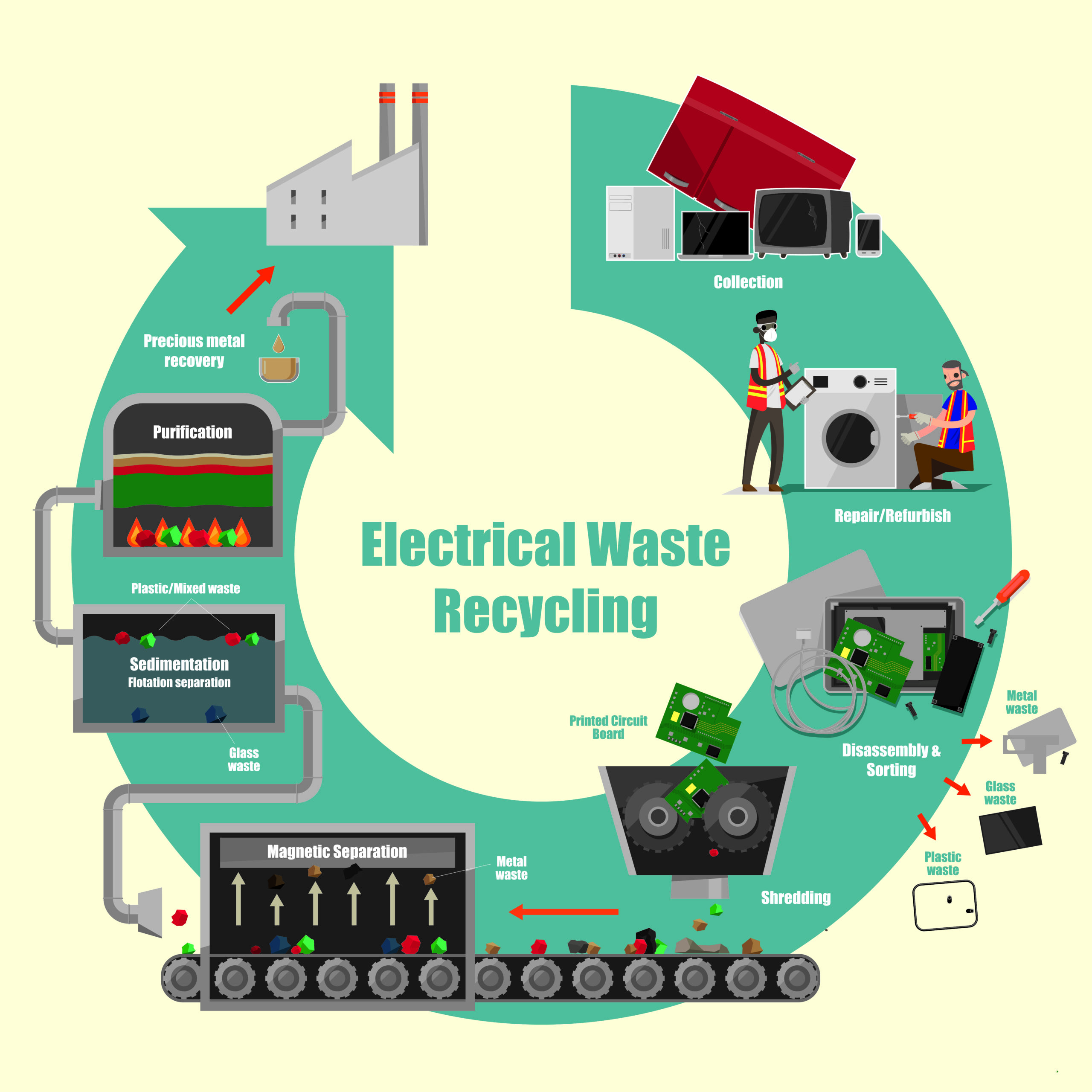
Some governments are introducing legislation to address the subject of built-in obsolescence, which they successfully applied to Apple recently. This action is seen in treating e-Waste with a ban on the disposal of e-Waste in general garbage and, more specifically, e-waste collection programmes.
On the direct impact of technology on the planet, the increasing use of ‘cloud’ services has seen the expansion of data centres, and presently this represents over 1% of the global energy demand. Changes are coming here also as companies seek to use renewable energy to power these sites.
Self-regulation by technology companies and government legislation are both essential. This will help further reduce the negative impact of technology on the environment. But we, as consumers, also have to play our part given the growing environmental concerns related to our technology usage, but we can help limit the negative impact of the technology we use.
• Using the technology, we do have for as long as possible.
• Buying second-hand/ reconditioned items rather than new ones.
• When we buy new, choose options with as little negative impact as possible and seek ethical, eco-friendly, and sustainable alternatives.
• Choose technology you can repair rather than things that will break and no longer function after some time.
• Reusing older devices in new ways around our homes or donating them so they can continue to be used and avoid them becoming domestic waste.
There are many creative ways in which you can use an old smartphone. These devices already contain the software to carry out many tasks. For example, you could use an old smartphone as a:
• universal remote for a smart home
• portable gaming device (for kids or yourself)
• GPS device
• music device for your vehicle
• ‘practice’ phone for young children.
• A dedicated machine for video calls in your home office
• ‘photo frame’ to show photos or stream webcams to enhance home décor.
• An alarm clock or desk calendar.
• security camera
By repurposing old technology in these ways, we can also reduce our need to buy new technology.

Case Study
Preamble
– Examples of leading Start Ups represented at COP26
– Together for our Planet 2022

Case Study
Approach:
Founded in 2020, AgriSound is a UK-based start-up on a mission to create the world’s largest insect biodiversity database by deploying a network of low-cost sensors listening to the sounds of insects. By mapping insect activity, AgriSound helps farmers and gardeners to understand the changes affecting bee health and welfare and can better manage land to support an optimal pollination environment.
Value:
Collectively, data obtained by AgriSound’s sensor network will be used to map the impacts of agrochemicals, target conservation efforts and support policymaking to help achieve sustainability goals whilst maximising food production.

Case Study
Approach:
BrainBox AI is a market leader in the Cleantech and Proptech sectors offering artificial intelligence (AI) to combat climate change by making commercial buildings more innovative and efficient. Its flagship product combines AI and cloud computing to create a fully autonomous commercial heating, ventilation, and air conditioning (HVAC) solution. The technology optimises HVAC systems in real time through seamless communication with building management systems (BMS).
Value:
Enabling Buildings to reduce energy consumption and emissions significantly. Harnessing the power of BrainBox AI’s core product, its next phase of innovation brings together entire building clusters and cities.

Case Study
Approach:
Commonplace is a community engagement platform that helps create better places together with the support of the community. By making it easy to collect, understand and act on community feedback, we help local authorities and developers create more inclusive decisions.
Whether it be sustainable transport, greener energy, waste reduction, or protecting green spaces – our climate engagement hubs help governments, organisations and communities work towards the same goal and make Net Zero an everyday reality.
Value:
Commonplace has launched over 1,200 community engagement projects with our customers, engaging 3.5 million community members across the UK, Europe, North America and Asia.

Case Study
Approach:
Hummingbird Technologies builds systems that accelerate the global move towards sustainable agriculture. The technology detects and independently validates critical farm-management practices and outcomes, enabling farmers and landowners to monetise sustainability, accelerating the decarbonisation of global agri-food practices and using earth observation, remote sensing and machine learning techniques to verify and monitor sustainability in agricultural systems.
Value:
Hummingbird enables farmers to harness the power of adequately managed soil to sequester carbon from the atmosphere and to feed a growing population whilst accelerating the race to net zero.

Case Study
Approach:
Measurable. Energy aims to eliminate all wasted energy and Greenhouse Gas (GHG) emissions from buildings without any burden to occupants.
The m.e Platform focuses on Small Power, which can account for up to 40% of a commercial building’s energy consumption and has no helpful management system. Up to 50% of Small Power is wasted energy and GHG emissions. The m.e Platform is designed to fit into this infrastructure and management gap, automatically identifying wasted energy and controlling it.
Value:
The targets are to reduce total energy costs and GHG emissions by up to 50%. Also, providing a 3-year payback

Case Study
Approach:
OLIO’s mission is to reduce food waste in the home. Olio does this by leveraging digital technology; underpinned by the community; at scale. OLIO is a free mobile app connecting neighbours and volunteers with food businesses so food & household items can be shared for free, and homemade food & handmade crafts can be purchased & sold (in the new MADE section)

Case Study
Approach:
Sweep is the modern way to manage your company’s carbon emissions and create impactful climate action at scale.
Our data-driven software platform makes it easy to understand, manage and reduce your carbon footprint. Powerful collaboration features and user-focussed design empower your staff and your value chain to create a cleaner business a reality. Our integrated marketplace enables companies to directly purchase the best negative carbon, securing what will soon become a scarce resource.
Value:
With all your data in one place, our analytics offers unparalleled insights into your progress, and automatic reporting to your stakeholders.

Exercise
• Post-it Notes, whiteboard and pens

Course Manual 6: Sustainability
In previous sections, we have discussed the impact that technology has had, both positive and negative, on the planet, our environment and ourselves. Some positive references have touched on how we apply technology to the earth’s issues and the need to reverse climate change, biodiversity decline and air and water pollution. This section identifies several areas, such as agriculture, energy, environmental management, more innovative homes and electric vehicles.
So what is sustainability? The planet can sustain life, enabling it to thrive and grow without depleting all resources, making parts of the globe uninhabitable and wiping out entire civilisations.
Agriculture was one of the first areas where humans applied technology, which has continued for thousands of years. In the digital age, this continues with remote sensors, drones and satellite imagery, making precision farming a reality. Accessing the agronomy data and using AI techniques to guide the application of fertilisers, pesticides, watering and when to harvest takes the guesswork out of managing farms.
Applying the same principles of access to data and guidance on what crop to plant technology supports small emerging farmers in the developing world. Communications infrastructure and availability of smartphones mean reaching remote villages is fine. Preventing the loss of crops through pests, such as locusts, is now possible by harnessing mathematics with drone technology to get to breeding grounds.
The demand for space and the need to use it better and reduce transport costs drives new technology. Vertical farming is in the vanguard of this movement alongside indoor farming, producing vegetables and herbs. Technologies such as aquaponics play a role supported by remote monitoring sensors. Aquaponics is an attractive and sustainable farming solution. It works by combining fish tanks with plants. Natural waste produced by fish contains nutrients that can be used as fertilisers. By passing the water through a hydroponics system, the plants get to feed and simultaneously remove the nitrogen waste from the water, which is then returned to the fish tank. This approach can enable small units to be integrated into kitchens to provide fresh herbs, and there is talk of using space around supermarkets to supply herbs from a vertical farm.
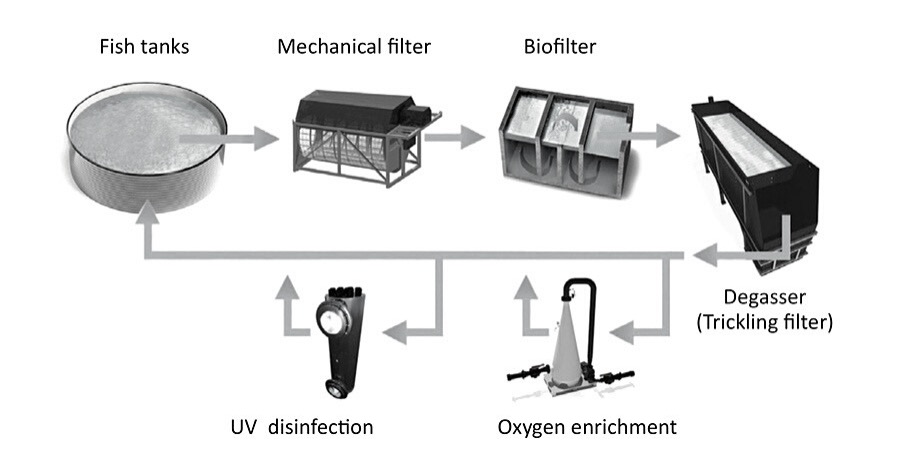
Aquaculture is the technology applied to fish and has successfully been applied to various fish, from salmon, tilapia, oysters, and shrimp. This technology often uses sea-based ponds to feed, monitor and harvest the fish. On the other hand, shrimp tend to be in warm water and are therefore being farmed on land. Several technologies, such as advanced bio-filters, oxygenators, remote sensors, and robotic feeding systems, come together to make these farms a reality. Recent developments have seen proposals to connect farms to anaerobic digestion plants to provide heat and power, creating a completely circular food system with no waste.
The production of meat is still an area for debate on its contribution to global warming by combining the technology of 3-D printing and artificial protein laboratory meat has been developed.
Technology significantly moves the planet’s reliance on fossil fuels to renewable or cleaner alternatives. Typically renewables use natural resources such as the sun, wind and wave using solar panels, wind turbines and wave turbines. In this latter case, research is underway to use a technology that uses wave power for power packs or military personnel. Home heating alternatives to gas boilers are being promoted; heat pumps use the technology of the refrigerator in reverse. With enough space, homes can tap into the geothermal energy in the ground.


Renewables need to have the luxury of being switched on and off to meet demand; presently, national distribution companies will pay generators to switch wind turbines. Storage and release of energy in a controlled fashion is another area of technology research using batteries and capacitors. Similarly, research is being conducted to store car batteries from electric vehicles in the home.
Air-powered electricity is being investigated where electricity is generated from thin air by abstracting moisture passing electrically conductive nano-protein wires.
The ability of all the microprocessor technology to gather data has also driven the development of this data. As we know, databases have moved from replacing manual filing systems with relational databases, transforming many business systems. However, providing more complex reporting required data to be freed from the constraints of specific relationships. The concept of Big data is that individual data items and their characteristics exist in a big lake. From this, connections can be designed for transactions and reporting.
In environmental management, this has supported data gathering from sensors across the globe and the Geographic Information System capability. This approach has enabled the creation of more innovative homes on a smaller scale. Through the Internet Of Things, homeowners can capture data from devices such as washing machines, Home Heating, Security cameras and Lighting systems; to issue commands and view activities on their devices.
The increased gathering of data and its subsequent analysis has required more and more computing power, much of it provided by ‘cloud-based’ data centres. A new mindset Carbon Computing means that data centres conduct their heaviest workload at times when renewable energy is at its highest.
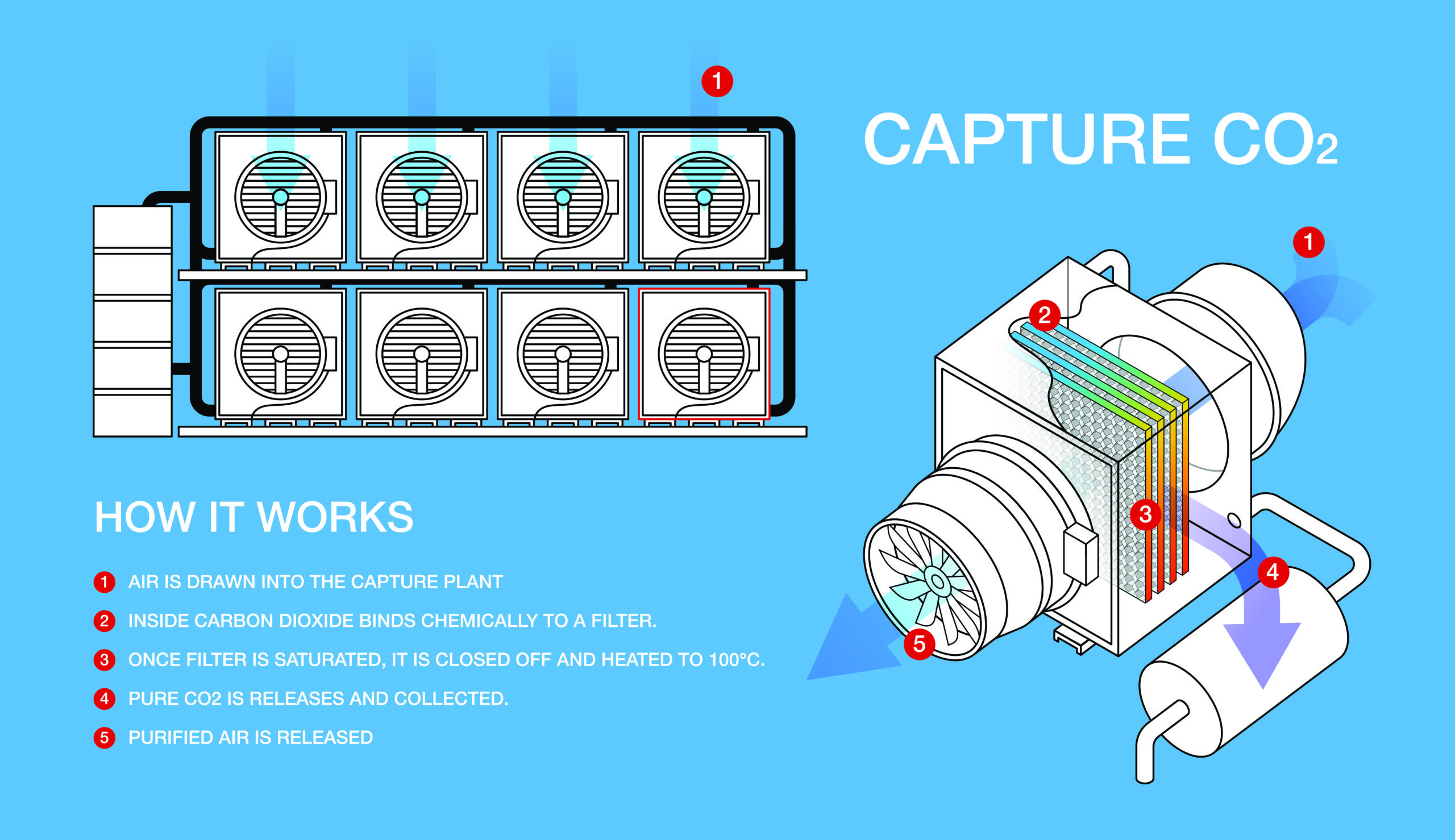
Tackling air and water pollution requires more technology; data collection from sensors and big data is at the centre of the information drive to support decision-making, such as looking for run-off pollution and identifying the source, whether caused by a farmer or a water company. Plastic in the oceans has become very topical following the Blue Planet series; simple gadgets such as Seabin show how easy it is to improve the gathering of plastic from the sea and subsequently process it.
Reviewing air pollution, we have started to measure and set targets for cleaner air, and we know that trees do a good job of absorbing CO2. Still, we need more trees, particularly in towns and cities, so architects are designing buildings with plants; in one scheme, algae is part of the fabric of the building. When it is exhausted, it can be used as fertiliser. With both air and water pollution sensors and big data form the backbone of the analysis and reporting

Technology is addressing the CO2 issue by also tackling some of the emitters of gas operating in the transport sector. Electric vehicles have been around since 2000 and are starting to become more mainstream, with recent sales figures indicating that in the UK, the market share had reached 19%. The projection is that they will become cheaper than petrol vehicles in 2024 and that electric charging points now outnumber fuel stations in the UK.
Trains and buses are utilising this technology, and battery-powered or hybrid aircraft are now test flying; the battery’s weight still prevents commercial aircraft use, but as ‘air taxis’ operating between major conurbations, they offer a natural alternative.
There are question marks over this switch to electric vehicles, including the real carbon impact considering that charging vehicles through the national grid still produces carbon equivalent to 100gm/km. Plus, the depletion of rare earth metals such as Neodymium-Boron is required for magnets in electric motors, and Lithium is needed for Lithium-Ion batteries.
Some less direct examples of technology leading to greater sustainability have processes for breaking back returned beer bottles to sand, which can be used in construction and therefore act as a replacement for sand taken from beaches. Finally, Graphene is a two-dimensional (one atom thick) sheet of carbon atoms arranged in a hexagonal crystal lattice, like a honeycomb. It can be laid, and since its discovery in 2004, many innovations have been using its properties for flexibility, transparency and conduciveness. One of those is cement. Mortar and concrete. The production of which in construction contributes to 38% of final energy use and 39% of process-related CO2 emissions; this means that 8% of the global CO2 emissions are attributable to these materials; if this were the country, it would be the third largest polluter behind the US and China.
The diagram below shows the overall process for making cementitious products.
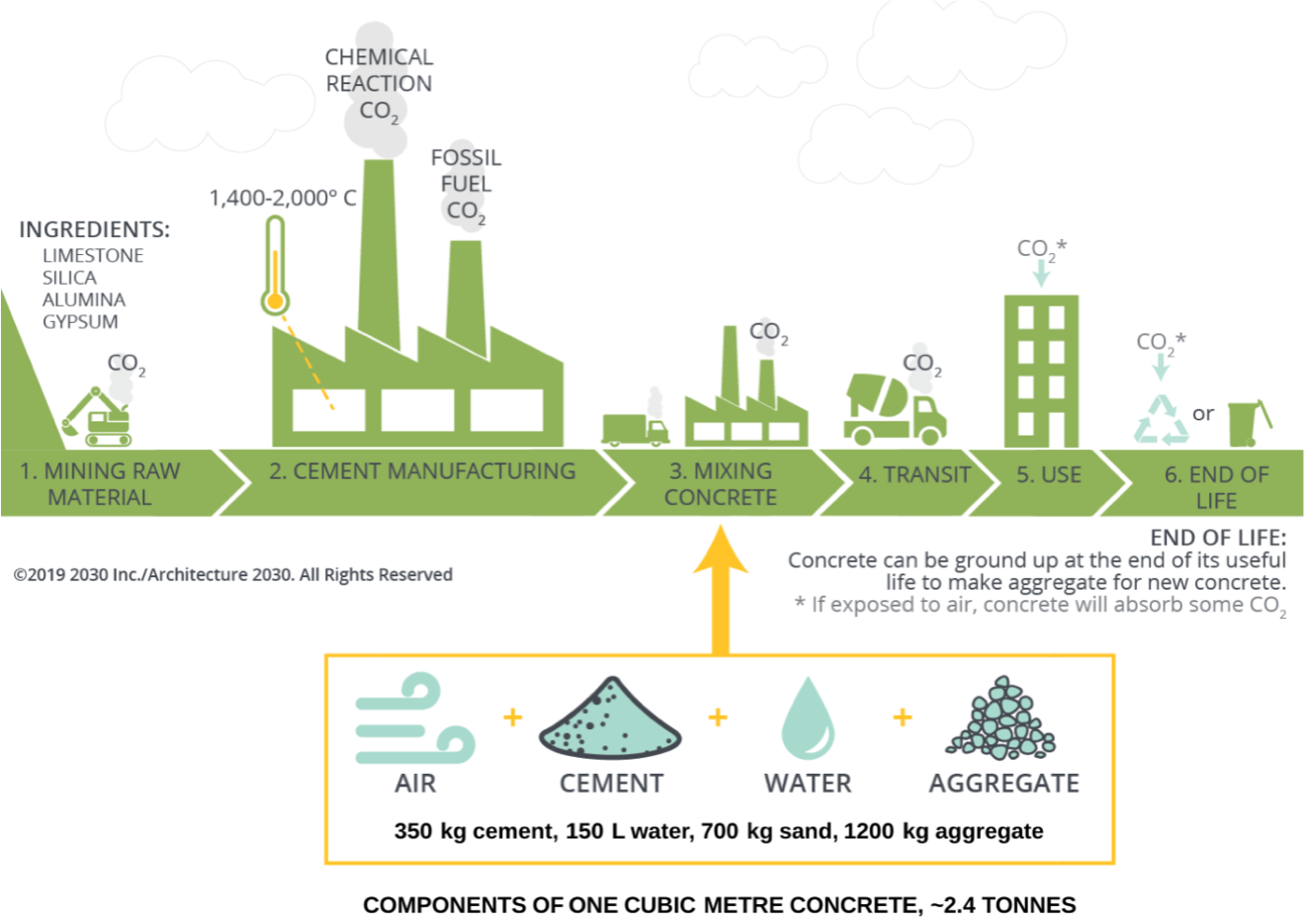
Graphene’s properties mean that it can impart improved mechanical properties but improved thermal and electrical conductivity. In mechanical properties, case studies have shown a 34% increase in compressive strength and a 27% increase in tensile strength. This means the required material volume can be reduced by 50%, a 446 kg/tonne reduction in production emissions. Applying these numbers to the traditional manufacture of Portland cement, the subsequent decrease in global warming is 21%.
Graphene will no doubt change the use of cementitious products in construction; there are now 3D printing processes enabling construction companies to produce concrete sections in situ rather than transporting them from a factory floor. Using Graphene’s other properties, such as electrical conductivity, the ability to create Smart Buildings to manage their assets, be self-powering and self-sensing for building health will become a reality.
Sustainability has been a rallying point for several ISO standards, such as ISO 9001 (Product Quality), ISO 14001 (environment), ISO 27001 (Information management) and ISO 26000 (social). Each of these management frameworks can be applied by businesses to manage the relevant processes; sustainability is driven by three pillars economic viability, environmental protection and social equity. Similar to the lean manufacturing mantra of the 5Ss, the sustainability structure refers to the 5Cs Clean, Community, Culture, car and Corporate Governance. Much of the focus is on how businesses address their carbon footprint in terms of the energy they consume operating the industry and how buildings are built and refurbished. In this latter category, an international standard BREEAM for facilities offers ways companies can satisfy their Environmental, Social and Governance requirements.
B Corporation provides a standard that once achieved means the company has achieved a good ESG status and is committed to continuing to achieving it.
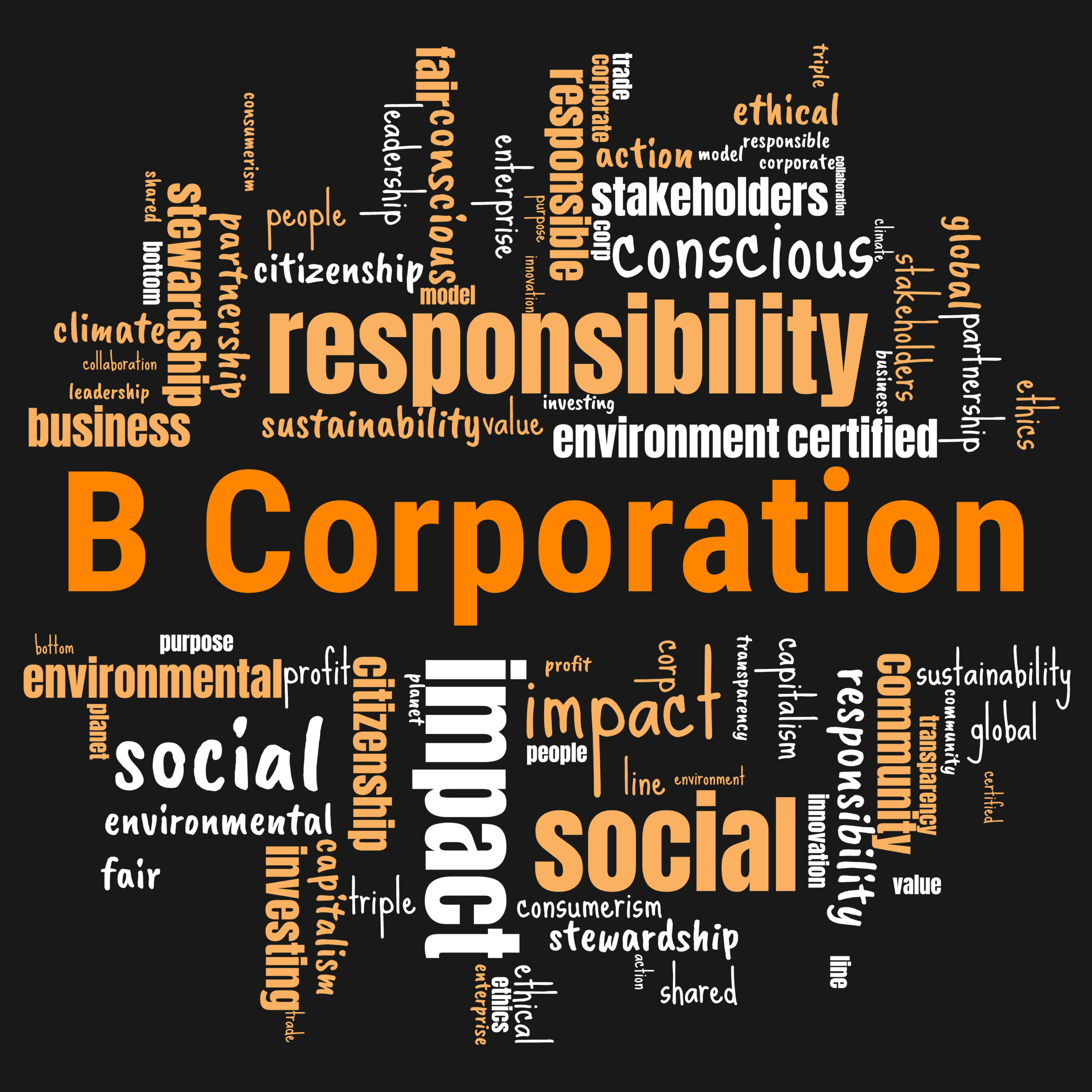
The key elements relate to the health of the building occupants, net zero emissions and the use of onsite renewables, circularity for the building lifecycle and resilience associated with the help of both water and energy, a durable design and eliminating waste.
Relating these targets to an operating strategy for sustainability and Net Zero, we need to review the following topics.
Construction – how do we use technology to reduce the carbon impact of new build and refurbishment. Examining the supply of materials to a site Croydon local government applied a new technology O2D, to manage deliveries. An independent report stated that 20% of deliveries are turned away in a year from any site. These vehicles then circle for 10 miles or 17 kilometres; managing the orders and loading vehicles was working well but constriction sites had poor visibility of origin to destination information. These statistics applied to one site mean that 5400 deliveries were turned away and the total accumulated mileage was 54,000 (or twice around the world).
By implementing O2D app the site can
• Real-time tracking of deliveries from origin to destination
• Bespoke Route in, Route Out Sat Nav per site in line with planning consent
• Holding area management and vehicle diversion
• Live arrive time
• CLP measurement
• Instant communication across the supply chain
• See any route order its ETA and load
The impact on the environment from just one site id the reduction of 64 tonnes of CO2; if you consider this applied to all Considerate Constructor sites; at any one time there are over 3000 then the total benefit over 190,000 tonnes of CO2. Less quantifiable benefits are reducing deaths and injuries caused by construction vehicles by rerouting away from heavily pedestrian areas. Routing to avoid peak pedestrian times and improving the air quality.
Other simple actions include using returnable packaging, leasing pallets or specialist handling units returned to the manufacturer. The same goes for waste generated during the building and fit out processes, using accurate measurement with laser technology and reducing excess material being delivered. Returning material to the manufacturer for re-processing and, finally, building units on the factory floor for more straightforward fitting and effortless removal during refurbishment and eventually demolition.
Operational energy – standard technology that can be implemented here includes electric vehicles, the application of sensors to manage ventilation, turn taps on and off, the same for lighting, and finally, on the lighting front, the use of LEDs. New builds should always consider the potential for renewables, including solar panels (particularly on roofs), wind turbines, and district heating, the latter on sites where Anaerobic Digestors or waste incinerators are placed. Capturing and reusing energy is now a valid option for computers or production processes.
Added to these practical measures the company can engage in carbon offsets for energy that cannot be modified or replaced.
Looking at three examples of this standard in practice, we first look at its impact on the design of a Lidl supermarket in Sweden. In this design, the ISO standard 50001 for Energy management was applied for metering and monitoring usage, and 100% of the energy consumed on-site is generated from renewable sources. A strict waste management policy means that none goes to landfill. The design has been captured as a set of rules for future step and repeat methods of new supermarkets across Sweden.
The second example is a suite of offices that had been refurbished in Paddington, London. In this case, the following features are exemplary applications of BREEAM;
• Increasing Cycling provision to encourage less car usage
• No waste to landfill
• All wood comes from environmentally certified woodlands (FSC standard)
• All materials are sourced responsibly, and the supply chain is supported by the likes of
– Tight measurement of floor spaces to reduce or eliminate carpet offcuts
– Pallets are leased
– Plasterboard waste was recycled via the manufacturer
– Low or no VOC or formaldehyde was allowed in any furniture
The final example is a shopping mall in Holland. The key takeaways from this design
• Windows and doors represent less than 10% of the overall wall area
• Heat recovery is performed on all technical systems, such as computer servers
• Sensors monitor and manage all ventilation
• All lighting is LED
• Solar power onsite provided 140,000KW/Year
• All sanitary ware preserves water
• Comprehensive monitoring and management of all energy usage
• In the area of materials
• Use of low-carbon concrete
• Solar cells were chosen with the smallest CO2 footprint
• All sources were conducted according to ISO 14001
Finally, the roof of the building is covered in natural materials reflecting a rare local habitat that required the collection of seeds and plants to replicate the same biodiversity and look good.

Case Study
Canon operates according to the philosophy of Kyosei – a Japanese word that means ‘living and working together for the common good’. This philosophy shapes everything the company does as a business. It underpins their vision for Sustainability in Europe, the Middle East and Africa (EMEA), which is to ‘grow the positive power of their imaging technology and services’.
Canon passionately believes in the benefits the company, its people, products and services can bring to its customers and broader society. Ensuring they continue to deliver these benefits is critical to Canon’s vision.

Case Study
Nokia’s liquid-cooled base station
Nokia, Elisa and Efore have commercially deployed a liquid-cooled base station system in an apartment building in Helsinki. This world-first achievement promises lower costs for operators and owners of base station sites and reduced CO2 emissions.
In the deployment, the heat emitted from the base station has been redirected to heat the building, lowering energy costs. In previously conducted customer trials with the Nokia solution, Nokia Bell Labs saw a reduction of up to 80. per cent in CO2 emissions and up to 30 per cent in energy operating expenses – significant savings for operators and other owners of base station sites. Liquid cooling permits the removal of air conditioning and fans, promising further operator savings, potentially longer base station component life and silent places.

Case Study
Ørsted builds a greener world with offshore wind power
Headquartered in Denmark, Ørsted develops, constructs and operates offshore wind farms that provide power to 11.3 million people, roughly a quarter of the world’s offshore wind market.
Wind farms are part of the global leader’s shift from fossil fuels to renewable energy. Ørsted divested its upstream oil and gas business in 2017 and has reduced its coal consumption by 82 per cent in the last decade. It plans to phase out coal entirely by 2023 and wants to increase its offshore wind capacity to 15 gigawatts by 2025 – enough to power more than 30 million people.
Ørsted relies on a digital strategy that includes advanced analytics and artificial intelligence (AI) with Microsoft technology to reach its goals. The software helps the company transform data from its 1,300 offshore wind turbines into insights for predictive maintenance that saves time and resources.

Case Study
In 2016, HP committed to improving conditions at the Truitier landfill in Haiti over three years in partnership with Thread International, the First Mile Coalition, Timberland, Team Tassy, and Association des Collecteurs des Objets en Plastique. An estimated 200 children between the ages of 8 and 12 currently collect recyclable materials from the landfill, daily exposing them and their families to unsafe working conditions. This joint initiative aims to improve the lives of these children by providing access to quality education, including more than 200 scholarships, complete physical exams, and health and safety training.
As part of this commitment, HP purchases recycled plastic from raw materials collected at the Truitier landfill for use in their closed-loop. By opening a new market opportunity, generating a steady revenue stream, and partnering to improve workers’ conditions, HP is helping to create a more circular and inclusive economy with sustainable jobs, opportunity and dignity for the Truitier community.
HP Partners with Homeboy Electronics and in the process, creating good jobs for people who face employment barriers, including felons and former gang members.
That mission has made Homeboy a critical link in the sustainable future that HP is building. HP recognised years ago that the traditional, linear “take, make, dispose of” manufacturing model isn’t sustainable on a planet where the population is booming, and resources are dwindling.
Homeboy is helping HP recover more material from recycling and developing innovations to improve the closed-loop process. The partnership also enables Homeboy Electronics Recycling to expand its operations — which means it can hire more employees.

Case Study
Tata Chemicals Europe:
Tata needed to reduce its CO2 emissions to redcue the tax burden and also examine if it can leverage its value stream; by applying a carbon capture technology pre-flue to its combined heat and power plant, it could produce high-quality CO2 for use in the production of Sodium Bicarbonate. This is a critical component in pharmaceutical industries and dialysis forms to treat some kidney failure conditions.
The unit was attached to the plant CHP which provided heat and power for the plant in Northwich and other local businesses. The unit extracts, purifies and liquefies the carbon for ongoing production using Amine solvents.

Exercise
• Post-it Notes, whiteboard and Pens.
1. Defer judgement. It would be best always to find out where a good idea will come from. The key is to make everyone feel like they can say the picture in their mind and allow others to build on it.
2. Encourage wild ideas. Wild ideas can often give rise to creative leaps. In thinking about wacky ideas, we tend to think about what we want without the constraints of technology or materials.
3. Build on the ideas of others. Being positive and building on the opinions of others take some skill. In conversation, we try to use “and” instead of “but.”
4. Stay focused on the topic. Try to keep the discussion on target. Otherwise, you can diverge beyond the scope of what you’re trying to design for.
5. One conversation at a time. Your team is far more likely to build on an idea and make a creative leap if everyone is paying full attention to whoever shares a new vision.
6. Be visual. In live brainstorms, we write down on Post-its and then put them on a wall. Drawing takes time to get an idea across. It doesn’t matter if you’re not Rembrandt!
7. Go for quantity. Aim for as many new ideas as possible. In a good session, up to 20 views are generated in 10 minutes. Crank the ideas out quickly and build on the best ones.
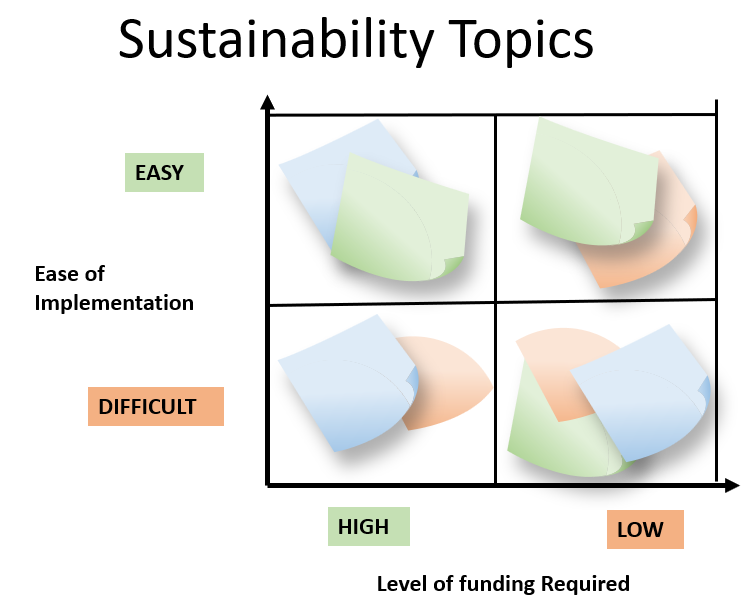

Course Manual 7: Business Transformation
What is transformation? It fundamentally changes how a business operates by addressing all aspects of the operating models, products/services, customer experience, and the technology used. All against a set of strategic objectives that need to be achieved.
These objectives will be set to improve the company’s performance and market position and usually demand action on culture, processes, organisational design and staff capability and mindset.
The key drivers of the need for transformation can relate to some factors such as Customer demands, competitive and market forces, changes in regulations, mergers and acquisitions, efficiency and cost reduction, and development and marketing of new products and services; finally, technology such as materials like Graphene or digital technology such as AI for example.
No matter the initial strategic driver, the route to successful implementation will still require several fundamental principles to be applied. These include;
• Communication of the future vision, which will include culture, business and operating model and Organisational design
• Defining and managing a strategy that ties everyone’s action into its delivery and ensures they understand their role
• Fully developed benefit and cost model that identifies how each benefit will be attained related to the processes within the company
• Transparent risk management with mitigating actions managed within the project plan
• Project Management that accurately records and reports progress so that any disruptions to the plan can be reflected in timelines and resources
• Business Process Management defines how the business operates from an end-to-end perspective, ideally providing a digital twin that can be used in process analysis from a Lean and Customer Experience viewpoint, training and induction, compliance with regulations/legislation, and internal business rules.
• Management of Information technology avoids the piecemeal approach regarding process automation but applies the most appropriate technology, ensuring business ownership of any solution, particularly data.
• Change Management is creating and deploying a toolset that covers all the critical capabilities required to implement the transformation, such as problem analysis, decision-making, workshop management and communications. Identifying change agents within the organisation to build the transformation consensus
• Improve the organisational capability through training and certification, define new roles, including responsibilities such as data ownership and applying business policy, and support staff who need help fitting into the new model and finding alternative employment. The focus should also be made on the innovation process, particularly in business models, which in many ways are more complex and challenging to manage than products and services.
Transformations come in various forms, from the Radical, a complete change of business in terms of business and operating model, to the incremental, based on the principles of Continuous Improvement. Between these two extremes, transformation can be aimed at a part of the business architecture such as IT or the core business processes, or a specific amount of business such as the supply change or production processes. It may be the case that we have a blend of these approaches in any programme with different projects managed to the final vision.
Several frameworks pull these principles together, but they will emphasise the same key points: transformation needs to be holistic, not a piecemeal application of change initiatives or random digital tools. It must be a strategic improvement in both internal capability and external offerings. This requires the transformation to address culture, process, people and infrastructure. So that the attitude to changes in process, business rules and roles are favourable, and innovation is not a top-down process but occurs across the business.
Achieving this mindset across the business is vital, as is defining and monitoring the transformation impact through benefits. This must be quantitative and qualitative, related to the company and staff.
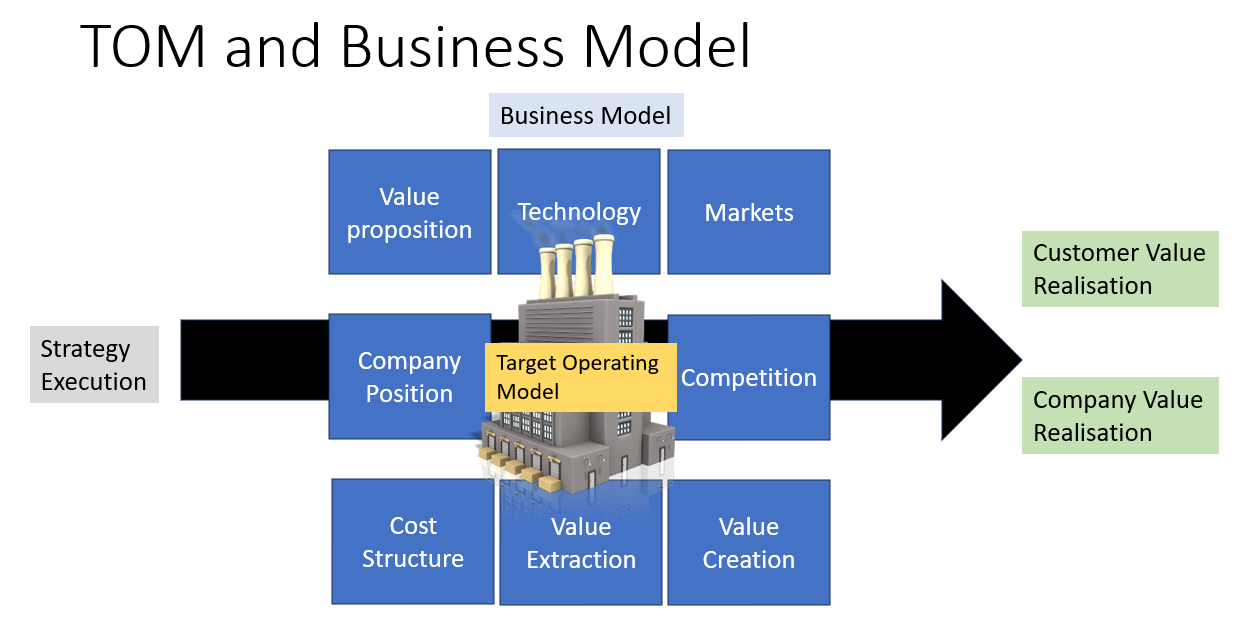
Applying these principles to a real-life case study, we look at a Mid-West Insurance company that, amongst its products, offered home damage insurance. Some of their customers’ houses and outbuildings were in a hurricane alley.
It was suffering a churn of customers of more than 20% per annum and for $200 per new acquisition; this resulted in a cost of $40,000 per 1000 customers. So this you class as indirect customer demand as they choose to go to another supplier.
To understand why the customer chose to walk rather than raise complaints, the company decided to map the critical interface point with the customer, processing a damage claim. Having mapped the steps using cross-functional teams and post-it notes, a key element of successful transformation is using cross-functional teams. The next step was to analyse each step from an external perspective through the lens of customer experience and an internal perspective through the lean lens.

The customer experience can be measured against three criteria Moment of Truth (usually the first contact with the company or department), Break Point (any handover between departments) and Business Rule (process policy applied to a particular step).
The Lean categories are related to the value of the activity in the eyes of the customer; that is, would they pay for that activity if it showed up on the bill? Both forms of analysis relate to time to enact the training and can then be costed at an overhead or wage rate.
The ASIS states that the customer passed through three processes to repair the damage and receive a payout. The average time spent managing these processes was over 24 hours, which would amount to about three weeks if the claimant were working, not allowing for delays in response from the Insurance company. The customer had to complete 15 steps within the three processes and poor customer experience was identified in more than 80% of them.
The insurance company had to complete less than eight steps shared by Insurance Agents and Loss Adjustors. As this title suggests, this person’s role is to reduce the cost of any payout to a minimum. Typically, they would question if the household were damaged due to a hurricane, would not pay for temporary repairs; would assess the damage and ask the family to get three quotes for repair and engage the one they felt would do the best job, then come and assess the final restoration and apply business rules not apparent to the claimant to justify reducing the payout.
The internal view of the ASIS process recognised only five processes.
It is evident that to achieve the strategic objective of reducing the level of customer churn; the following actions need to be accomplished;
• Reduce the level of activity requested by the customer
• Ensure the customer did not pay for any repairs which would not be sanction
• Safeguard the company from high costs for both temporary maintenance and restoration
• Ensure that the customer, who is already stressed, is not further inconvenienced by poor systems such as IVR, not asked what appear to be daft questions such as ‘Were you affected by the hurricane?’ and does have to make technical and commercial judgements for which they might not be qualified
The process streamlining reduced the customer’s responsibility to just two actions; complete an Insurance company damage report with simple diagrams and photos and sign off the temporary repair and final restorative work.
To achieve this remarkable transformation, the company;
• Built a vision to communicate to all staff
• Identified that the role of the Loss Adjustor needed to change, and they could leverage the skill for both the company and customers’ benefit.
• Supply the customer which simple tools/templates to speed up data gathering and decision-making.
• Built a network of trusted tradespeople that would be approved and contracted to undertake the core processes of temporary repair, restoration estimate and complete the restoration work
• Integrate the customer database into the national weather forecasting system to provide appropriate warnings and marking which properties might lead to claims.
• Finally, deliver a free consulting service to survey all buildings and out-buildings to protect against storm damage and reduce rates for undertaking the work; in return, the customer signs up for three years.
This transformation, therefore, embraced a number of the critical principles of communication, organisation redesign and role change, training and developing staff and customers, and upgraded IT capability using externally available data. This increased the value of their offering, creating value for the company and the customer.
Much of this thinking has also been applied to motor insurance claims, with technology such as dashcams removing much of the dispute over whose fault it was, protecting good driver no-claim bonuses, and reducing or maintaining lower insurance costs.
The second example of a company tackling transformation involves a family-run company that started life as a water pump specifier and distributor supporting plumbers. They expanded their horizons by developing pumping sets for larger installations, combining tanks, pipework, valves, pumps and control systems.

Having developed the business organically with the inherent evolution of processes, they embarked on a new strategy to grow the business by a factor of 2 and from;
• New Products and Services
• Entering new markets
• Improving productivity and efficiency
The initial review of operations and the existing business model identified several issues that would need to be resolved, starting with the limited capability of the system, which was based on an old accounting system rapidly becoming unsupported. Numerous spreadsheets supported this, and a couple of bespoke applications developed long ago and needed to be maintained.
Secondly, the evolution of process was evident in some core processes such as New Product Development, Procure to Pay, Market to Quote and Order to Cash. 2D CAD systems supported the NPD process, and several other departmental initiatives were started to address the known deficiencies in quote preparation and customer relationship marketing. The geography of the four locations and a lack of implementation of best practices were the cause of poor productivity in areas such as product quality, inventory management and operational procedures. As is the case in all companies that have been in operation without any recent transformation, there were a lot of sacred cows.
The transformation programme was opened by developing and communicating the company’s new vision covering a single site, product range, target markets, integrated systems and improving organisational capability with training and knowledge capture. This holistic view of the transformation initiative enabled management to integrate the departmental projects into the overall programme and avoid mismatches in technologies, data and processes.
Reviewing the transformation programme in detail reveals the following:
• Moving into one site has enabled.
– Warehousing to be consolidated, removing intermediate stores that need to be assembly line based.
– Reduced the number of goods entry points and, therefore, potential errors and loss of documentation.
– Shorter response times between warehouse and assembly lines
– Sharing of production skills and management with the integration of assembly cells
• Process improvements have been applied to Reviewing market Opportunities and managing the new product development process with the introduction of Stage-gate disciplines. They also integrate design engineering and 3D CAD capability into developing system quotations. Improving inventory management by applying best practices to setting safety stock relating them to usage-value (ABC analysis), lead times, and lots size constraints. Improved horizon Scanning for new market trends, particularly about construction; following the build, off-site developments were complete packages which are literally ‘plug and use’ in areas such as Utility rooms and large-scale pumping needs for apartment blocks and hospitals, for example.
• The Introduction of Stage-gate disciplines was supplemented with a Minimum Viable Product approach using 3D concept design, rendering, and scale model printing.
• Internal skills development was encouraged in Lean manufacturing (5S, Waste analysis, problem-solving and running a workshop) and Procurement.
• Integrated IT landscape was provided by a combination of ERP, best-of-breed CRM, website and IOT devices connected to installations providing maintenance and system status feedback. This opened up the possibility of maintenance contracts, a hidden revenue opportunity and customer portals enabling them to browse order history, credit limits, and stock to place orders directly and obtain delivery dates and be invoiced or pay by credit/debit card.
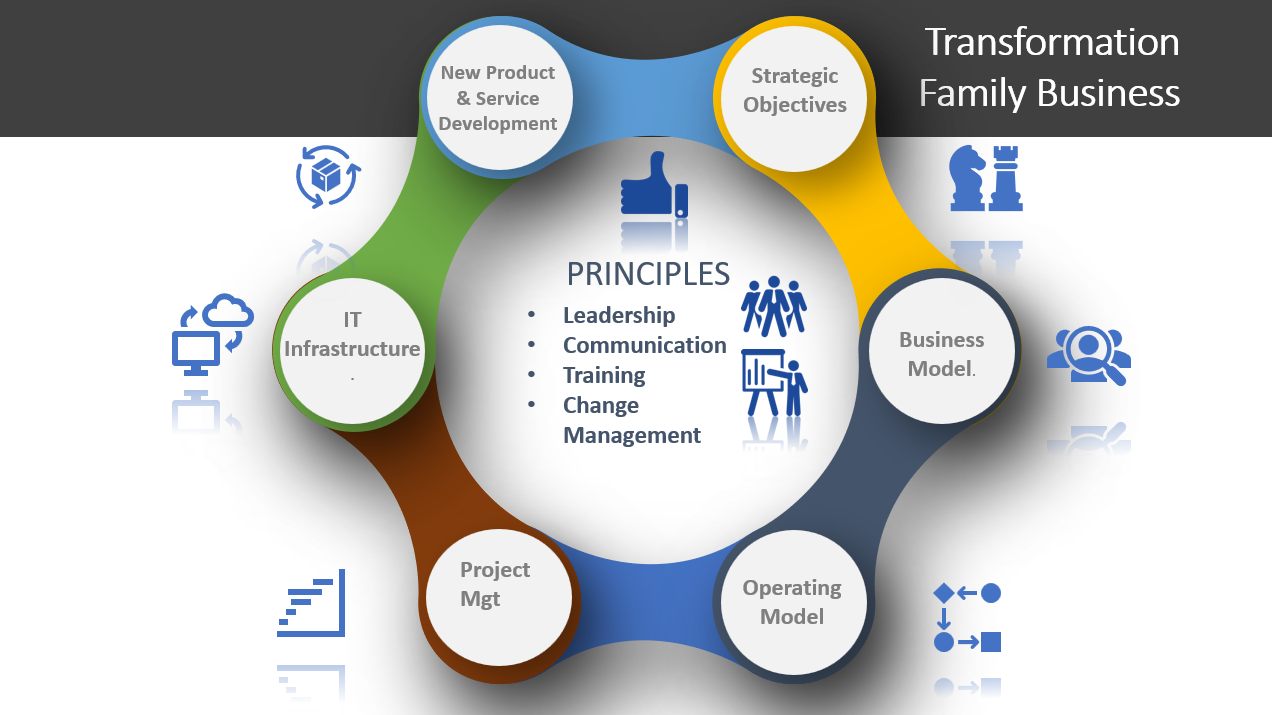
Strong Programme Management monitors budget and resources, applying mitigating actions when the plan is knocked off course by external factors such as commercial pressures or poor responses from other agencies, landlords and lawyers.
The third example comes from buying and selling cars, which has experienced an explosion of disruptors using different business models to those traditionally applied by car dealerships. The changes they brought in each process were not all apply to every new disruptor
• Selling Cars
– Quick online valuations
– Bidding Process amongst a panel of dealers for a better price
– Local with 15-minute reception and inspection centres
– Immediate cash payment into your bank and settlement of finance
– The promise of a better negotiation position buying a replacement
• Buying Cars
– Review stock online nationwide
– Car serviced and refurbished to ‘best’ status
– Home delivery
– 14-day money-back guarantee
There are flaws in the process, and complaints such as high penalties for scuffed wheels and paintwork marks, some of which still need to be published, have significantly impacted the final payment.
Mid-range car dealerships were losing stock to these companies resulting in low supply and less turnover to spread overheads. In addition, the operating model had assets like showrooms and workshops.
A strategy was required that responded whilst leveraging the critical assets of the showrooms. This is a similar problem that Best Buy in the US faced when Amazon started to move into white goods; their response is well documented and culminated in two key areas of focus; the human element in customer service, extending the Geek Squad idea to both pre and post-purchase advice on not just the appliance itself such as TV but how to hang mount and do the mounting when the product is shipped.
The effect Amazon had was to create what is termed ‘showrooming’, visiting retail outlets to view products and then buying them online. Best Buy call their response to ‘Showcase and ship’; the first part is the branded areas for large manufacturers such as Apple, Samsung and Microsoft. The second part refers to integrating central warehouses and stores into a network so that shipping is done from the most effective location relating to the delivery date.
Car dealerships’ response was a mixture of those features the disruptors had introduced; online showrooms are standard now, as are vehicle configurators (technology that first emerged in the late 90s). With the continued rationalisation of options, these tools are easy to use, providing a final specification and prices.
In the purchase process, they conduct online valuation based on the same criteria of milage, validation at one of the local showrooms, and immediate payment or settlement of finance. The selling process for second-hand cars again uses online stock, which displays the nationally available stock. Once the vehicle is chosen, it is moved to the buyer’s closest showroom for inspection and test drive. Most dealerships will offer the cars a complete check and service and a 14-day money-back guarantee.
This reduced scope focuses on the ordering and selling process and viewing from a customer experience perspective. Secondly, the programme will deal with the role of the salesman in this new business model.
Transformation is a significant undertaking and with the rapid pace of change, it must be implemented with a set of principles. Even with these principles applied, the programme will lead throughout all levels from the C Suite to the shop floor. Staff will need to be supported with tools and templates and trained in critical problem analysis, communication, workshop management and decision-making skills. The choice of these tools and their application must reflect the company culture, as with any external assistance selection.

Case Study
Brewing company AB InBev underwent a digital transformation by compiling its network of independent breweries into a unified powerhouse. One of their priorities was getting their data in the cloud, and by doing so, employees can now pull data gathered globally and use it to make data-backed decisions.
For example, more accurate demand forecasting means AB InBev teams can match supply with demand—essential for a large company with a complex supply chain. Access to data from all the breweries means they can experiment faster and roll out changes that improve business processes.
However, gathering more data and opening up that data to internal teams was just the first step of the process. AB InBev capitalised on their digital investments by launching an e-commerce marketplace called BEES for their SMB customers—the “mom-and-pop shops”—to order products from. With the BEES platform, AB InBev found that their small and medium-sized businesses browsed the store on the mobile app and added items to their cart throughout the day. However, they only made the final purchases later in the evening.
Based on this behavioural data, the BEES team started to send push notifications after 6:00 p.m., recommending relevant products, which led to increased sales and greater customer satisfaction. By the end of June 2021, BEES had gained over 1.8 million monthly active users and had captured over $7.5B in Gross Merchandise Volume.
Jason Lambert, the SVP of product at BEES, credits their success with the complex data that told them how their customers behaved and what they needed: “It turned out to be a thousand times better than any of our previous strategies or assumptions.” BEES used behavioural analytics to respond quickly, changing the buying experience to match the needs and habits of their retailers.

Case Study
As a traditional brick-and-mortar retailer, Walmart began the digital transformation by opening an online marketplace. However, digital transformation is an ongoing process—it doesn’t end at the first website. A digital transformation means companies refocus their operations around digital technology—which usually happens internally and in a customer-facing way.
To drive more customer value through digital touchpoints, Walmart set up mobile apps and a website to allow customers to purchase goods online. After analysing their app’s customer behavioural information, they added services such as same-day pickup, mobile ordering, and “buy now, pay later.”
To be successful with digital transformation, Walmart prioritized data access for everyone on their teams. Breaking down internal silos allowed employees to take ownership; They acted fast and made substantial changes to improve the customer experience.
Walmart’s head of mobile marketing, Sherry Thomas-Zon, notes how critical data and data access is to digital operations. “Our marketing and product teams are always looking at numbers,” Thomas-Zon said. “You can’t work quickly without a self-service data and analytics tool for marketing, especially in an organisation as large as Walmart. It keeps our teams agile, despite our size and the increasing amount of data we collect and analyse.”

Case Study
Ford has embraced several digital transformation initiatives—including using technology to transform and improve the manufacturing process at one of its biggest factories. Not having the correct parts available holds up workers and slows down the production process. Ford introduced a material flow wireless parts system so they could track the quantities of different features and make sure there were enough available.
In 2016, Ford also introduced a digital product for their customers—the FordPass app. It allows Ford owners to control their vehicles remotely. For example, drivers can check their battery or fuel levels and lock or unlock their cars from their phones.
To capitalise on these new digital touchpoints with the customer, Ford leveraged data to improve the experience of the FordPass app. First, the product team grouped customers based on the in-app behaviours they demonstrated. Then, based on each group’s activity, Ford personalised the app experience to provide more value. Jian Wei Hoh, head of business design at Ford, said, “Designing around cohorts is a game-changer.”
Ford’s success is grounded in the same process as Walmart and AB InBev. They used their digital transformation to gather detailed information about how consumers interact with their products. Then, they made data-led decisions to provide more value to their customers.

Case Study
In the early 2000s, the Danish toy manufacturer was facing serious financial difficulties due to declining sales and changing consumer preferences. The company was on the verge of bankruptcy, but instead of giving up, Lego embarked on a major business transformation initiative. The company restructured its operations, divested non-core businesses, streamlined its supply chain, and refocused its product lines.
One key element of the transformation was the introduction of the Lego Movie, which helped reinvigorate the brand and drive sales. Today, Lego is a thriving company with a strong global brand and a diverse range of product lines. The success of Lego’s business transformation is a testament to the power of strategic planning, innovation, and a willingness to embrace change

Case Study
General Electric (GE) is a massive conglomerate with diverse business units spanning multiple industries. In recent years, the company has undergone a significant business transformation to streamline its operations and refocus on its core strengths. The transformation involved divesting non-core businesses and reducing the size of the organisation, among other initiatives. As a result of these efforts, GE has become a leaner, more efficient company with improved profitability. The business transformation has allowed GE to focus on its core strengths and position the company for long-term success.

Case Study
Amazon Business is an example of how a consumer giant transitions to the B2B space to keep up with digital customer expectations. It provides a marketplace for businesses to purchase from Amazon and third parties. Individuals can also make purchases on behalf of their organisations and integrate order approval workflows and reporting.
Approach:
• Amazon created a holistic marketplace for B2B vendors by offering over 250 million products ranging from cleaning supplies to industrial equipment.
• It introduced free two-day shipping on orders worth $49 or more and exclusive discounts. It further offered purchase system integration, tax exemption on purchases from select qualified customers, shared payment methods, order approval workflows, and enhanced order reporting.
• Amazon allowed manufacturers to connect with buyers & answer questions about products in a live expert program.
Value:
• Amazon could tap the B2B wholesale market valued between $7.2 and $8.2 trillion in the U.S. alone.
• It began earning revenue by charging sales commissions ranging from 6-15% from third-party sellers, depending on the product category and the order size.
• It could offer more personalized products for an improved customer experience.

Case Study
Preamble:
Like the video rental company Blockbuster, Netflix also had a pay-per-rental model, which included DVD sales and rent-by-mail services. However, Netflix anticipated a change in customer demand with rising digitalization and provided online entertainment, thereby entirely wiping out Blockbuster and the movie rental industry.
Approach:
• In 2007, Netflix launched a video-on-demand streaming service to supplement their DVD rental service without additional cost to their subscriber base.
• It implemented a simple and scalable business model and consistently infused 10% of its budget in R&D.
• The company has an unparalleled recommendation engine to provide a personalized and relevant customer experience.
Value:
• Netflix is the most popular digital video content provider, leading other streaming giants such as Amazon, Hulu, and Youtube with over 85% market share.
• Netflix added a record 36 million subscribers directly after the start of the COVID-19 pandemic.

Case Study
Preamble:
Glassdoor is responsible for increasing transparency in the workplace and helping people find the right job by allowing them to see millions of peer-to-peer reviews on employers, including overall company culture, their CEOs, benefits, salaries, and more.
Approach:
• Glassdoor gathers and analyses employee reviews on employers to provide accurate job recommendations to candidates and vice-versa. It also allows recruitment agencies and organizations to download valuable data points for in-depth analysis & reporting.
• It introduced enhanced profiles as a paid program, allowing companies to customise their content on the Glassdoor profiles, including job listings, “Why is it the Best Place to Work” tabs, social media properties, and more. This gives companies a new, innovative way to attract and recruit top talent.
Value:
• Glassdoor created the largest pool of interview questions, salary insights, CEO ratings, and organizational culture via a peer-to-peer network, making it one of the most trustworthy, extensive jobs search and recruiting platforms – and one of the most well-recognized review sites.
• Glassdoor leverages its collected data for labour market research in the US. Its portfolio of Fortune’s “Best Companies to Work For” companies outperformed the S&P 500 by 84.2%, while the “Best Places to Work” portfolio outperformed the overall market by 115.6%

Case Study
Preamble:
Sophos went live with Salesforce to accelerate its sales process, enhance sales productivity, and increase the number of accounts won. However, the complex interface and regular updates of Salesforce resulted in a decreased ROI.
Approach:
• Sophos implemented Whatfix to provide interactive, on-demand training that helped users learn in the flow of work. The 24*7 availability of on-demand self-support, contextual guidance, and smart tips allowed Sophos to effectively manage its new CRM implementation.
• It unified internal communications using Whatfix content. First, they created walkthroughs for the basic functionality of Salesforce such as lead management, opportunities, etc. Next, they moved to slightly more complex features that their users were uncomfortable with and created guided walkthroughs and smart pop-ups. Sophos also used Whatfix to align the sales and product management teams by embedding videos and other media to unify product communication instead of relying on various communication tools.
Value:
• Sophos experienced a reduction in sales operations support tickets globally by 15% (~12,000 tickets). It saved 1070 man-hours and achieved an ROI of 342%

Case Study
The global financial group BBVA has undergone a significant business transformation in recent years. The change was initiated to become a more customer-centric, agile, and innovative organisation. To achieve this transformation, BBVA adopted a new organisational model, which included creating cross-functional teams, implementing agile methodologies, and adopting new technologies such as cloud computing, big data, and artificial intelligence. BBVA also introduced new digital products and services, such as a mobile banking app and a digital wallet, to improve the customer experience.

Exercise
• Post-it Notes, whiteboard
• Create three columns headed simple changes, partial transformation, whole company transformation.

Course Manual 8: Business Models
In the previous section, we discussed the difference between transformation and change and that we would choose to use a Business Model to define a transformation. The Business Model is the way a company creates and delivers value. This is not a standard measure in many companies’ KPI sets. Value is a term regularly used when involved in business start-ups and as part of the research of the customer and profiling what jobs they are attempting to complete and how your product and service provide value when undertaking that job.
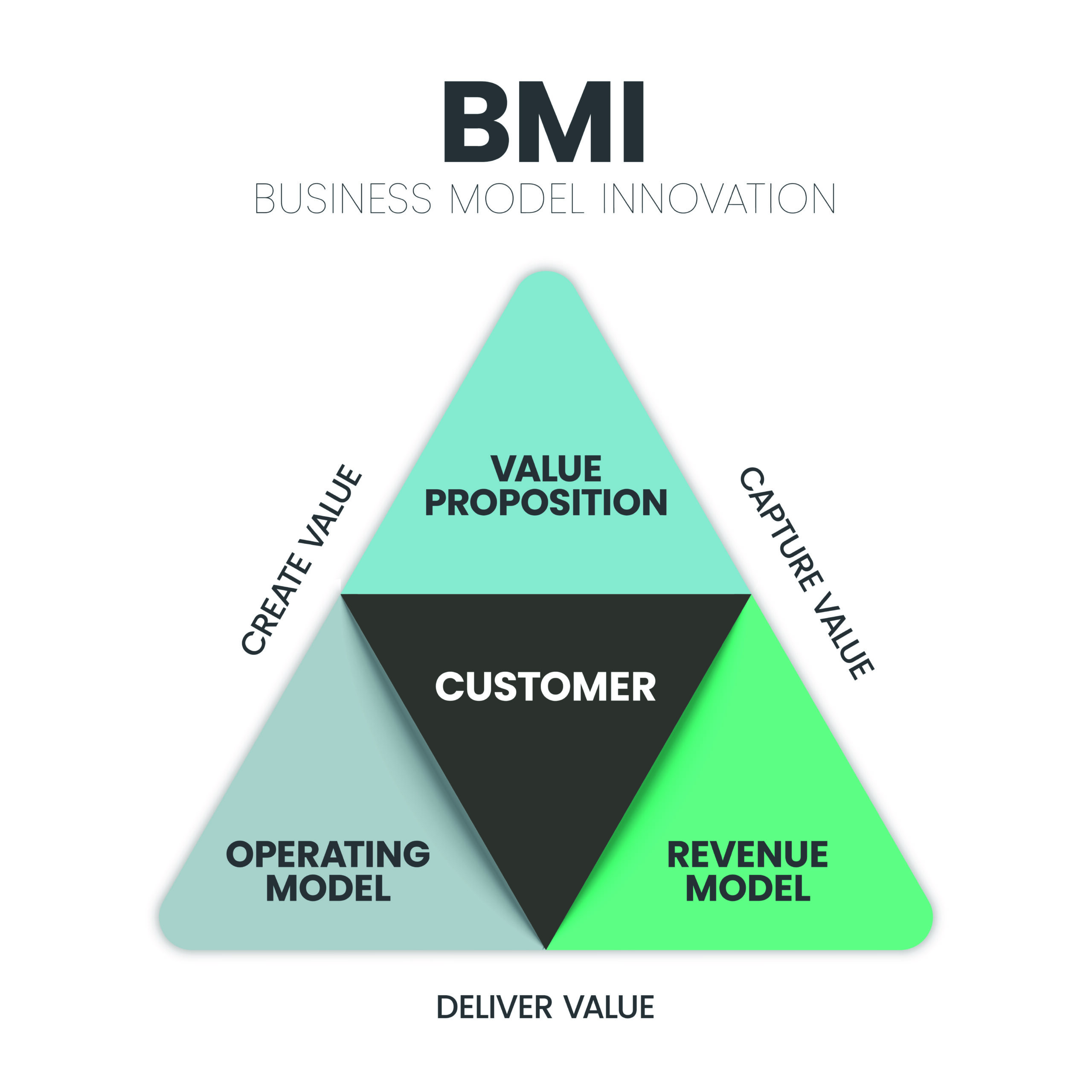
The business model can be considered the platform that connects resources, processes and a product or service supply. It must demonstrate the connectivity and inter-relationship between the business and its operations. Considering how business performance is typically usually say in the annual report, beyond the financial figures, the remainder of any information is related to the departments and what they have done in each of their ‘silos’. Individual descriptions of customer relations, employee competence and innovation activities do not tell the story of the business model. However, we discuss in these reports how these personal activities interrelate so we can assess how the business model works.
Businesses must conceptualise this platform, analyse it and then communicate it using suitable performance measures. The business model is the vehicle by which the strategy is enacted, defining the unique attributes applied to create value. The strategy is how we extract that value and make the business profitable.
An excellent example of a disruptive business model is Ryanair, operating in an industry that had struggled to make profits for over a decade with an easy-to-communicate business model dubbed low-cost or no-frills service. Reviewing the business model closely, one could argue that this value proposition is based on ‘no service’ and that their model does not worry about the passenger ordeal as they offer the cheapest way to travel. There are similar examples in the US, such as Southwest and Spirit Airlines.
To present the dynamic relationships inherent in a business model requires a new form of communication. One such example is the business model canvas proposed by Osterwalder and Pigneur.
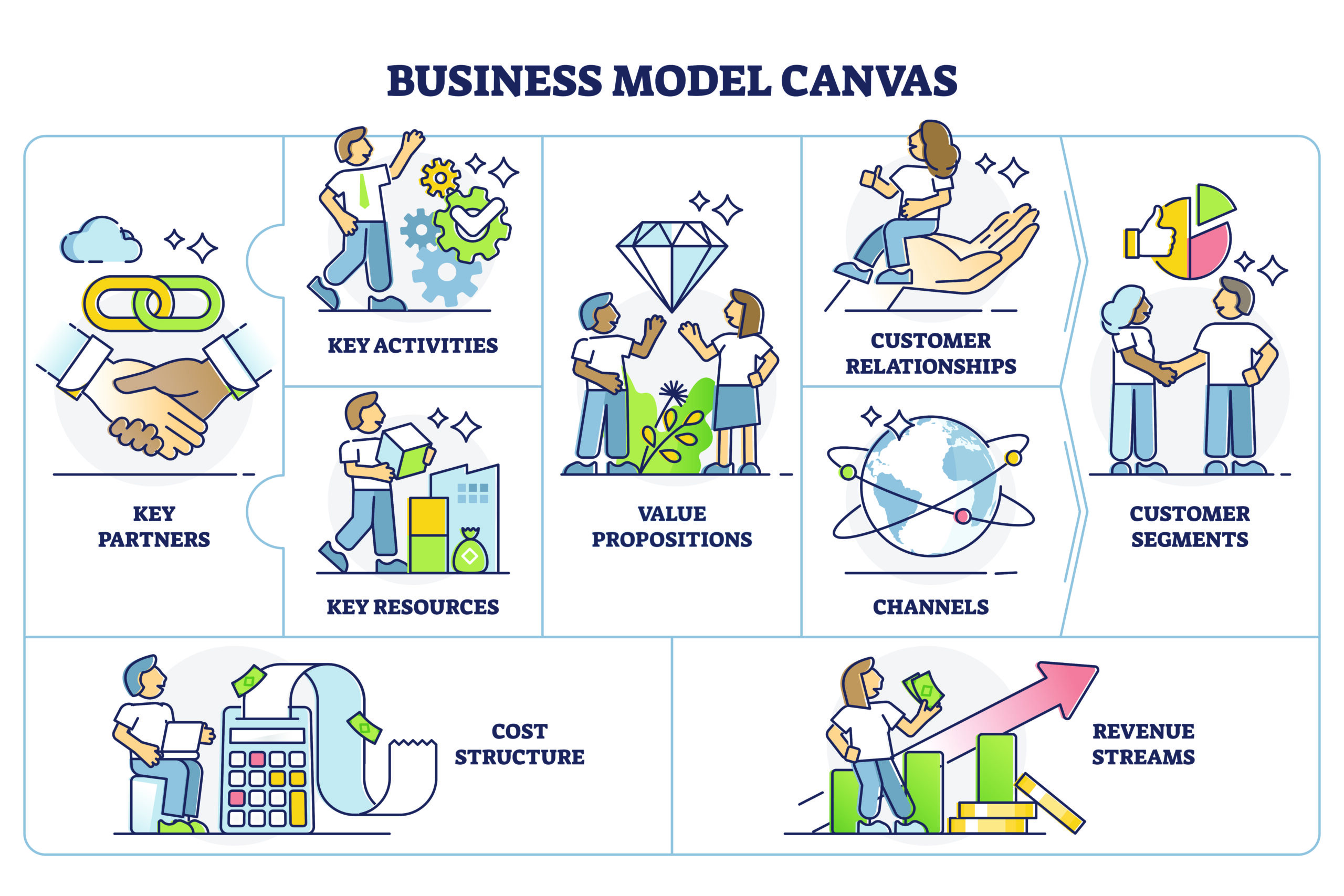
CEOs predict that by 2026 50% of revenues will come from new products, services and businesses that have yet to be created. Between 2018 to 2020, double the number f CEOs have set new companies as a top priority.
They must ensure that they make these transformations, not changes; the latter is a way of improving the past, and transformation is about creating the future.
Business Model Innovation is a third arm working alongside product and Service innovation and, as shown in the diagram below, is both more complex but offers more opportunity for profit. The reason for this is the need to understand all the interrelationships and then use this knowledge to allocate and organise resources efficiently.
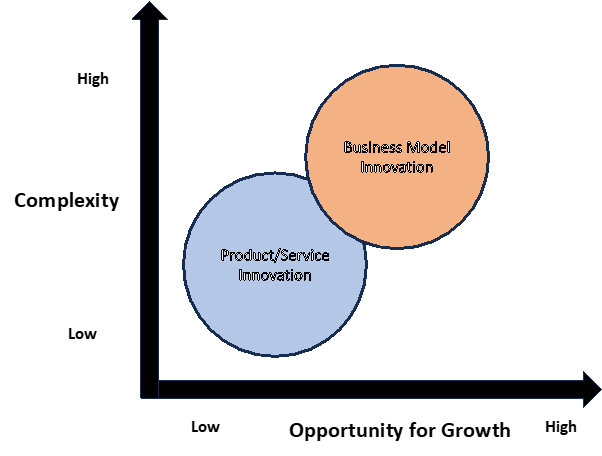 –
–
NEED BETTER QUALITY IMAGE
We will examine how we can build and implement a business model with various technologies. But as a case study on a classical disruptive Business Model, let’s review Airbnb. The value proposition addresses two customer segments people with assets to rent and customers needing a room(s) to stay in.
The Business Model platform enables the relationship between these two parties through a shop window on the asset, hiring prices and creating a commercial transaction between the asset owner and the customer. Airbnb acts as the intermediary for a fee. This has enabled Airbnb to provide more hotel rooms than the traditional brick-and-mortar players; 19.4% of room supply in NY and 192 countries now account for 5.4% of global supply.
The value proposition for asset owners is a hassle-free way to generate income with no requirement for infrastructure such as a portal and payment system; from the customer’s perspective, there is plenty of choice with a wide range of prices and facilities and the feeling of more personal service.
Recent research has identified six keys to success for business models, being;
• Personalised product or service – ability to adjust the product or service to meet an individual’s preferences. For example, they use big data & machine learning to analyse people’s buying habits and suggest their next purchase.
• Closed-Loop process – addressing the drive for sustainability by recycling packaging and old appliances in the white goods sector.
• Asset Sharing – reflected ultimately with the Airbnb and Uber examples; Uber uses its platform the connect the driver and asset owner to a travelling public, managing payments and safety for both driver and passengers,
• Usage-Based Pricing – the cost of the service is governed by supply and demand, classically ride-sharing apps and latterly as energy prices encouraging energy use at low demand times—for example, the use of washing machines in the evening.
• Collaborative eco-system –enabling feedback on the experience and the ability to tip the driver.
• Agile and adaptive organisation – introducing simplified decision-making and more collaboration with the customers and suppliers, enabling products and services to adapt to changing market conditions.
Some of the vital technology developments that have facilitated these features in new business models include
• Low-cost sensors capture lots of data
• Big data combined with AI and machine learning
• Connectivity through IOT and cloud computing
• Manufacturing and material developments such as nanotechnology, additive manufacturing and materials such as graphene
The market needs that are driving these requirements are
• Diversity of customer preferences
• Increased demand
• Rise of input costs
• Greater regulatory pressures
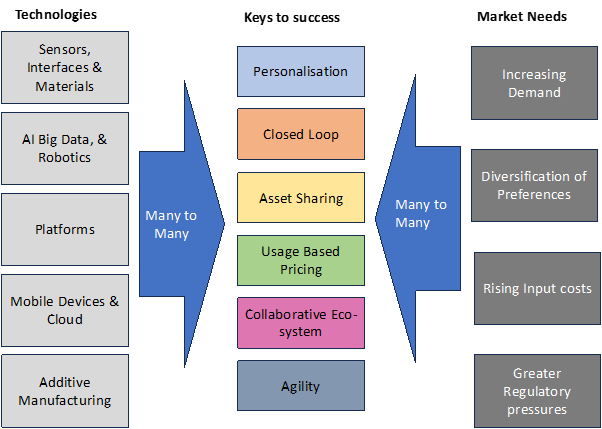
The question is, ‘Are there an ideal number of the six key elements successful businesses exhibit?’ That number seems to be four or more; Airbnb, Amazon, Ikea, Lego Rolls Royce (Power by the Hour); Uber exhibit—Ryanair, whom we discussed earlier in exhibit 3.
Before we develop some fictitious examples, let’s confirm the elements we need to consider;
• Customer value proposition
• Customer and Market segments
• The value chain from creation through extraction to realisation
• Cost Structure and profit potential
• Company position within the value chain
• Competitive Strategy
Now we will examine how technology can enable the delivery of business models; we will consider three possible businesses. The first is a water pumping and piping system supplier for commercial and private installations; the second is providing agriculture services for both produce wholesaling and farming advice. The last business reviews the consolidation of home servicing for boilers, plumbing and electrics.
The first business services three distinct customer segments: plumbers (individuals) and plumbing companies; the second, architects and property developers.
Plumbers’ value proposition is the supply of complete water pumping systems from a product range or a bespoke design. The value creation part of this business model is harnessing the skill and knowledge of fluid systems engineering to design, production methods and component sourcing. Value extraction is achieved by capturing the knowledge base, making this available to the customer to enter requirements, and driving a formula-based 3-D concept design, bill of materials, and production estimating. The technology applied to make this business model a reality are;
• Parameter-driven product selection or bespoke design
• 3D computer-aided design and concept rendering
• Integrated engineering and manufacturing databases
• Electronic proposed design presentation using video
• Integrated material management system
• Human intervention to ensure realistic design and pricing
Value realisation from a customer’s perspective is providing a priced quote with delivery dates in 24 hours. Value realisation internally is that the same number of engineers can process more quotations, and their work content is of a higher value with less administration. Systems track quotation progress and prompt action to be taken and recorded; customers can see their order and quo
3tation history and credit status.
The second segment involves architects and property developers; in the first case, with significant pumping requirements for a hospital or set of apartments, the business model is similar to the bespoke model for non-commercial property. The second value proposition is designing and providing packaged systems for apartments and housing developments. In this instance, the driver from the architects and developers is for site efficiency during fit-out, reducing the need for multiple trades to be engaged simultaneously and lengthy testing procedures. Designing and building complete units such as Utility rooms can reduce these to a virtually plug-and-play onsite operation. Utility rooms can contain white goods, heating or air distribution, and electrical distribution systems.
In this instance, value creation is achieved by combining component sourcing, piping and fabricated enclosure design to meet individual specifications, even between apartment types. Value extraction is performed through close integration with the shop floor to validate design assumptions and build methods, lean manufacturing design in components and assembly techniques, and Agile supply chains to enable engineering design changes.
Similar technologies can be applied as the pumping systems but with closer collaboration with the developer and site engineers at the initial prototype build stages.
• 3D computer-aided design and concept rendering
• Integrated engineering and manufacturing databases
• Electronic proposed design presentation using video
• Integrated material management system
• Engineer intervention to ensure realistic design and pricing
Value realisation for the customer is a unique solution that can be space-saving and implemented quickly. Two examples would be an apartment pumping system that maintains equal water pressure throughout the ten floors, built in a steel box so that it can be lowered into a below-ground space beneath the car park, thereby saving space in the building for other services. The second example would be a temporary pumping solution for a hospital extension that stretched the water pressure capability. The whole solution is built in a container with external connections for easy coupling to the building.
In summary, this business model is:
• Value proposition providing standard and bespoke pumping solutions quickly with a known price and delivery date.
• Customer and Market segments are plumbing companies, architects, property developers and facilities maintenance engineers.
• The value chain from creation through extraction to realisation, the creative process brings together various engineering disciplines, estimators, procurement and manufacturing; extraction is achieved through the integration of those disciplines digitally and the use of visual media; realisation from the customer perspective is personal designs, speed of solution design and build, improved building space utilisation and reduced costs of installation.
• Cost Structure and potential profit technology raises the value of the engineer’s input and reduces manual tasks, enabling the existing cost base to generate 150% more turnover and quadruple profits.
• Company position within the value chain enables the realisation of design requirements bringing the engineering expertise backed by a robust supply chain to secure components for the solutions. Additional value can be extracted from the maintenance of the installed systems.
• Competitive Strategy is the premium brand that combines intelligent design with high-quality components and assembly and a complete lifecycle support package from installation to system maintenance using IOT for remote monitoring.
Our second example concerns the support for emerging farmers in the African continent. The value proposition is that by combining a route to market with protected prices, crops do not get left in the fields to rot. Add farming advice that helps produce a better yield and more suitable crop for that area. It will be more saleable and improve the farmer’s profit.
The core of the first part of the proposition is central storage and transport from the field to the warehouse. The technological support comes from blockchain that provides an individual farmer with a digital account containing the purchase transaction details. This can then be applied to determine the sales price from the warehouse to the buyer.
Vale creation is achieved by improving the crop yield that gets to market at a secure price. Value extraction is performed by transporting and packaging to move the product at the most appropriate time.
The second part of the proposition extensively uses technology through guidance on what the market expects regarding crop presentation. These crops fit the soil type and weather conditions and are supported by pesticide and fertiliser advice. This is achieved with a cloud-based knowledge base that is accessed by smartphone. Services are provided from a subscription and cover;
• Agronomy
• Weather reports
• Soil analysis
• Pest reports

Case Study
The initiative involved several vital components, including:
• Reorganising the company’s global business operations to streamline decision-making and improve efficiency.
• Investing heavily in electric and autonomous vehicle technology, with plans to introduce a range of new EV models in the coming We are partnering with tech companies to develop new mobility solutions, such as ride-sharing services and delivery fleets.
• Focusing on improving customers continuously, emphasising digital channels and personalised services.
While the full impact of Ford’s business transformation initiative has yet to be realised, the company has already made significant progress in several key areas. For example, Ford has launched several new electric and hybrid models, including the Mustang Mach-E and the F-150 Lightning, which have been well-received by customers and critics alike. The company has also partnered with tech companies like Argo AI and Rivian to accelerate the development of autonomous vehicle technology.
Ford also invested in various new mobility solutions, such as its GoRide health transportation service and the delivery-focused Ford Pro division. Ford’s business transformation initiative has positioned the company to better compete in a rapidly evolving automotive industry and meet customers’ changing needs.

Case Study
PepsiCo announced a new business transformation initiative to become a more consumer-centric, faster, and more agile business. The main goals of the business transformation initiative were to increase productivity, accelerate growth, and create a more sustainable business model. To achieve this, PepsiCo aimed to streamline its operations, enhance its digital capabilities, and invest in new product development and marketing.
To drive the business transformation, PepsiCo implemented a range of initiatives, including:
• Investing in digitalisation to streamline operations and increase efficiency.
• It is enhancing its e-commerce capabilities and online presence to better engage with consumers and improve customer experience.
• It is expanding its product portfolio to include more healthy and sustainable products in response to changing consumer preferences.
• It is improving its supply chain and logistics operations to increase speed and flexibility.
As a result of the business transformation, PepsiCo was able to increase productivity and reduce costs while expanding its market share and improving its sustainability credentials.

Case Study
GP Practices – NHS – Practice 1 Corporate model.
Preamble:
This practice has four partners and covers a 13,000-patient population with additional services provided by community midwives, community nurses, psychiatric nurses and a physician associate. They operate through two sites and two pharmacies, with staff working at both locations.
Approach:
They have adopted an ‘integrated NHS’ approach, for example, bringing in the Physician Associate role and extending the Pharmacist’s role to Blood Pressure checks and Flu jabs. There is read-only access to patient records for the community, and through staff training and support, all staff feel safe and valued and have increased their capability.
Turning the practice structure upside down by reducing the ratio of GPs to support staff increased capacity and capability and raised the practice flexibility. With the market perception improving regarding the practice capability and attitude toward patients, it was easier to recruit staff.
Benefits:
• Better management of the workload with the support of technology
• Investment in the workforce paid dividends in terms of efficiency and staff satisfaction
• Risk to the practice was mitigated by continuous growth (6% per annum), diversification of services and innovation

Case Study
GP Practices – NHS – Primary Care Home.
Preamble:
This practice has twenty-four partners and covers a 43,000-patient population with additional services provided by dermatologists and musculoskeletal services. They operate through six sites and have a staff payroll of 145.
Approach:
They have adopted a partnership approach linking with local acute, community, and mental health services, extending arrangements to pharmacies, volunteer and patient groups.
The business model was created from a merger of 3 homes which improved the economies of scale and speeded up decision-making. Initially, a consultant was engaged to help develop the strategy, which was further developed and implemented with the appointment of a Chief Operating Officer. A small four-person team was chosen from the core team to manage the change in terms of decision-making and supporting staff unsure of the change.
Benefits:
• Ability to offer additional services to patients
• Creating groups of skilled non-clinical staff enabled greater resilience and investment in skills and process improvement.
• GP partners had more time to focus on being GPs
• Additional headspace allowed us to build relationships with other providers and commissioners, bid for new projects and new monies and change our working model.

Case Study
GP Practices – NHS – Practice 3 Vertically Integrated Trust.
Preamble:
Addressing a patient population of 70,00, this combination of primary, secondary and community services aims to address patients from initial contact through ongoing management to end-of-life care.
Approach:
Operating in a sub-contract model, each GP practice has a Lead GP who negotiates services with the partners. Group decisions affecting all practices are taken by Medical Director (GP) and supported by a management team.
The model was chosen to enable better data sharing, reducing primary care bureaucracy and addressing primary-secondary care interface issues. The key to success is that patient growth is projected to grow by 30,000, process redesign, informatics focus, use of technology and managing the associated change—finally, the ability to integrate a trust-based relationship into the NHS contractual framework.
Benefits:
• Workforce – expanding the primary care team, introducing portfolio roles, improving GP work-life balance, supporting GPs with data on demand and capacity, and reviewing process flow.
• Innovation and Data – created a real-time information system gathering data from hospitals and Primary care sites to improve decision-making.
• Addressing the primary-secondary interface – undertaking a consultative process to review the process and improve it
• Indicators – Improved patient access, reduced A&E admissions by 2.3% and Non-emergency admissions by 11% whilst raising patient satisfaction

Case Study
GP Practices – NHS – Practice 4 Super partnership.
Preamble:
This practice has one hundred and fifteen partners and covers a 400,000-patient population with additional services provided by primary care teams, home visits and paramedics. They operate through forty sites in eight regions and two pharmacies, with 1100 staff supported by central functions for Business Development, HR, Finance, Payroll and Communications. Governance is achieved through a regional and a national board.
Approach:
Economies of scale and scope drive it with like-minded practices. The aim is to promote the best of GP practice and get Primary care to step up and shape the future system. We are supporting staff by offering opportunities to grow and diversify.
Challenges include personal unlimited liability exposure, parity across the workforce concerning workload and payment, change readiness, talent management and capital expenditure.
Benefits:
• Developing new service contracts to limit the personal liability
• Improving the business resilience – with administrative cost savings, increasing growth and revenue
• Creating a platform for changing at pace

Exercise
• Post-it Notes, whiteboard
• Customer value proposition
• The value chain from creation through extraction to realisation
• Company position within the value chain
1. Defer judgement. It would be best always to find out where a good idea will come from. The key is to make everyone feel like they can say the picture in their mind and allow others to build on it.
2. Encourage wild ideas. Wild ideas can often give rise to creative leaps. In thinking about wacky ideas, we tend to think about what we want without the constraints of technology or materials.
3. Build on the ideas of others. Being positive and building on the opinions of others take some skill. In conversation, we try to use “and” instead of “but.”
4. Stay focused on the topic. Try to keep the discussion on target. Otherwise, you can diverge beyond the scope of what you’re trying to design for.
5. One conversation at a time. Your team is far more likely to build on an idea and make a creative leap if everyone is paying full attention to whoever shares a new vision.
6. Be visual. In live brainstorms, we write down on Post-its and then put them on a wall. Drawing takes time to get an idea across. It doesn’t matter if you’re not Rembrandt!
7. Go for quantity. Aim for as many new ideas as possible. In a good session, up to 20 views are generated in 10 minutes. Crank the ideas out quickly and build on the best ones.

Course Manual 9: Change Management
Implementing Change has become the norm in business, and post-pandemic, the pace of change has increased significantly due to technological influence. Managing change is critical surveys show that only 32% of employees embrace change and consider the opportunity exciting; the remaining 68% fear that it will impact their careers, which means they cannot perform their job effectively and perhaps lead to them losing their job.
Several factors can exacerbate this position, such as poor leadership, a lack of clarity on the goals and vision of the future, poor resourcing and planning, slow decision-making, misalignment between staff and management on the vision, and inadequate documentation and support on new roles, procedures and business rules.
Change Management is a collection of tools and techniques that can be blended to suit the change programme and enable change leaders to be more successful. We discuss each of the topics and how they integrate into complete programmes. The impact technology follows this has had in each topic to improve the speed and quality of delivery.
Change Management can come in three forms;
• Developmental focuses on improving existing processes without any radical impact on the operating and business models. This usually involves process analysis and improvement and, limited automation, more streamlining to remove waste.
• Transitional the focus is process analysis and improvement, leading directly to automation and change in the operating model.
• Transformational, where the task is to apply a new business model through a new operating model
The key topics are;
• Communication – the ability from the C Suite down to provide a vision for staff to be able to engage in and contribute to
• Personal Development – from the CEO to the manager and staff, the opportunity and support to develop and apply their skills in the workplace. Using the change programme to promote staff and encourage them out of their comfort zone.
• Training – providing knowledge of how new processes and systems will operate and supporting this with local super users.
• Process Analysis – the majority of change programmes will require the analysis of existing processes.
• Process Improvement – the majority of change programmes will require the streamlining of existing processes.
• Process Automation – most change programmes will undertake some form of process automation, from Robotic and Business Process Automation to hyper Automation.
• Productionisation – Converting best practices into production processes to remove waste, reduce the cost of the product/Service, and raise the quality.
• Benefits Assessment and Monitoring – Setting out benefits of any change in both monetary and also qualitative; addressing what’s in it for me
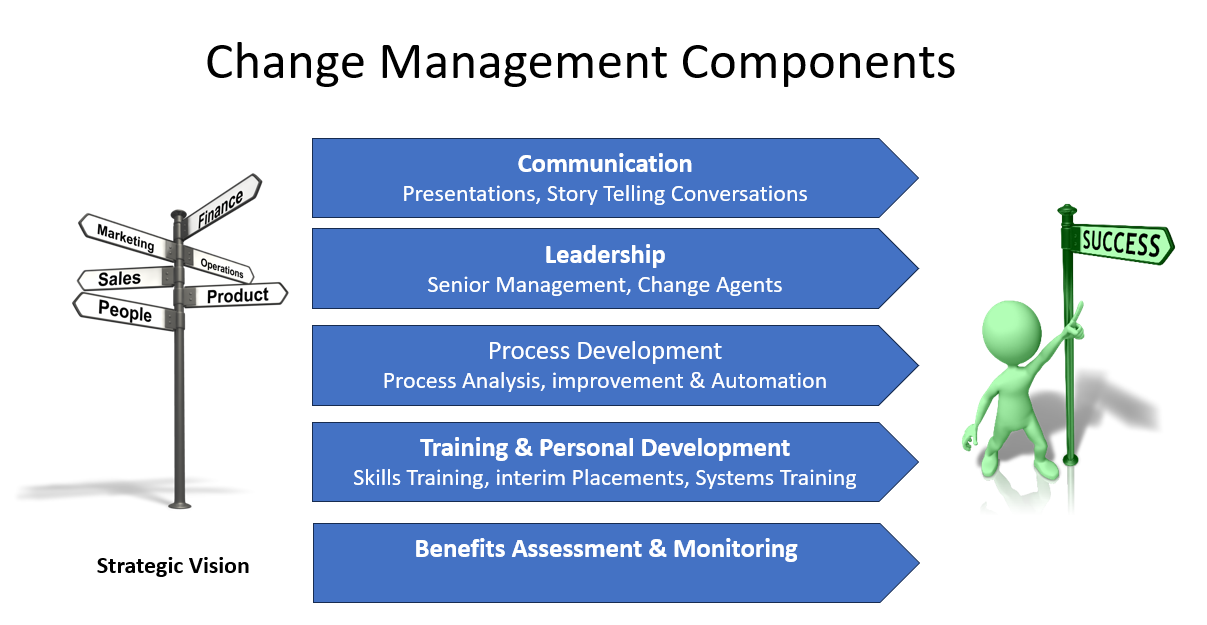
Communication is multi-faceted, covering company presentations, stakeholder presentations, workshop outcome presentations, and visioning. For these to be successful there are fundamental principles to follow.
• Creating a vision that staff will buy into secures the company’s future and their own.
• Raise awareness as soon as a change programme is agreed upon
• Ensure that early communication internally is two-way
• Train all ‘spokespersons within the business, managers, Union Representatives and recognised influencers, in the core message enabling them to provide some local colour to the delivery.
• Build into presentations how each person can help to deliver the vision.
• Most programmes benefit from a name which acts as a point of focus.
• Don’t present a ‘fait accompli’ mainly if options are available in the change implementation.
Technology has had a significant impact in this area. With the cost of equipment and the development of easy-to-use editing tools, many more people can develop audio and video material. The channels have also increased massively as the internet technology is used to power internal intranets and external websites. Multimedia is now an accepted way forward, combining intranet announcements, newsletters, presentation material distribution, results of analyses and performance, and surveys. This can be distributed through the computer network or via video links to televisions within staff relaxation and eating areas.
Using tools such as PowerPoint and other derivatives such as Prezi enables presenters to produce very engaging material; combining this with the option to add audio can bring the subject matter to life. Other technologies, such as Presenter Media and Shutterstock, expand the possibilities beyond simple two-dimensional slides to introduce both animation and humour. This delivery of creator capability has been further developed with the internet and platform technology, enabling creatives worldwide to act as on-demand content creators.
Change Programmes offer a unique opportunity to develop internal capability from the C Suite to the shop floor. Research shows that engaging staff in change, expanding their knowledge to understand the change better, adapting it to their future vision, and questioning the rationale builds solid momentum. This could include providing the opportunity to develop functional skills, say in procurement, if you are a buyer or lean techniques if you an operative on the shop floor.
At the senior management level, there is an opportunity to develop presentation skills, and undertake some personal changes; this can support leadership development and help create and deliver the forward vision with clarity. This could include elevator pitches for internal and external stakeholder meetings and written documents such as a project prospectus.
Finally, with a focus on talent management and retaining the best people change projects to temporarily promote younger staff, providing a larger decision-making mandate or switching more seasoned staff from their current departmental roles into something outside their comfort zone.
The technology impact in this area of change is related to training availability using online courses and the application of talent management software. HR systems are becoming more self-service for addresses, bank details, appraisals, and booking training and lodging certificates. This transfer of responsibility is breaking down the traditional annual appraisal process to something more real-time and accurate. The effect is that managers are not weary of a long and intrusive process, and the results and feedback are improved.
Training is the next subject that requires attention in change programmes, differing from personal development. This relates to documenting and delivering process instructions and business rules. Allied mainly to transformation programmes where there is a change in operating model and processes will have been subjected to streamlining to remove waste and automation to remove manual tasks and consistently apply business rules orchestrating processes.
Earlier, we had discussed technologies such as online training, which enables businesses to develop corporate skills without the overhead of extensive workshop scheduling and the provision of expensive trainers. Online modules allow the staff to learn at their own pace, at a time that suits them; they can be assessed remotely and provided with certificates which can be added to their electronic CV and the company’s training records. Typical courses cover problem-solving, workshop organisation and delivery and Training session design and assessment. Combined with online meetings coaching, applying the skills from an expert is easy to include.
Video-based transactional operating instructions enable super users to be more cost-effective and, if linked to a process model, can be accessed easily. This technology has proven very effective in increasing adoption rates for system changes and helping to identify issues such as inconsistent business rules within the system with those generally applied by the staff operating the process.
This brings us to digital twinning, a digital representation of the real world which enables a company to try before it flies with any new process—extensively used in automotive and aerospace design to resolve engineering issues and develop new concepts. In the context of processes using a digital model, we can quickly assess the impact of lean actions or improvements in the customer experience. These changes can be thoroughly evaluated before implementation; if part of new system functionality transactions can be captured in screenshots or video and added to the process model. The model then becomes the repository for all process information, a training tool and the support documentation for any standards qualification.
Physical World Representation
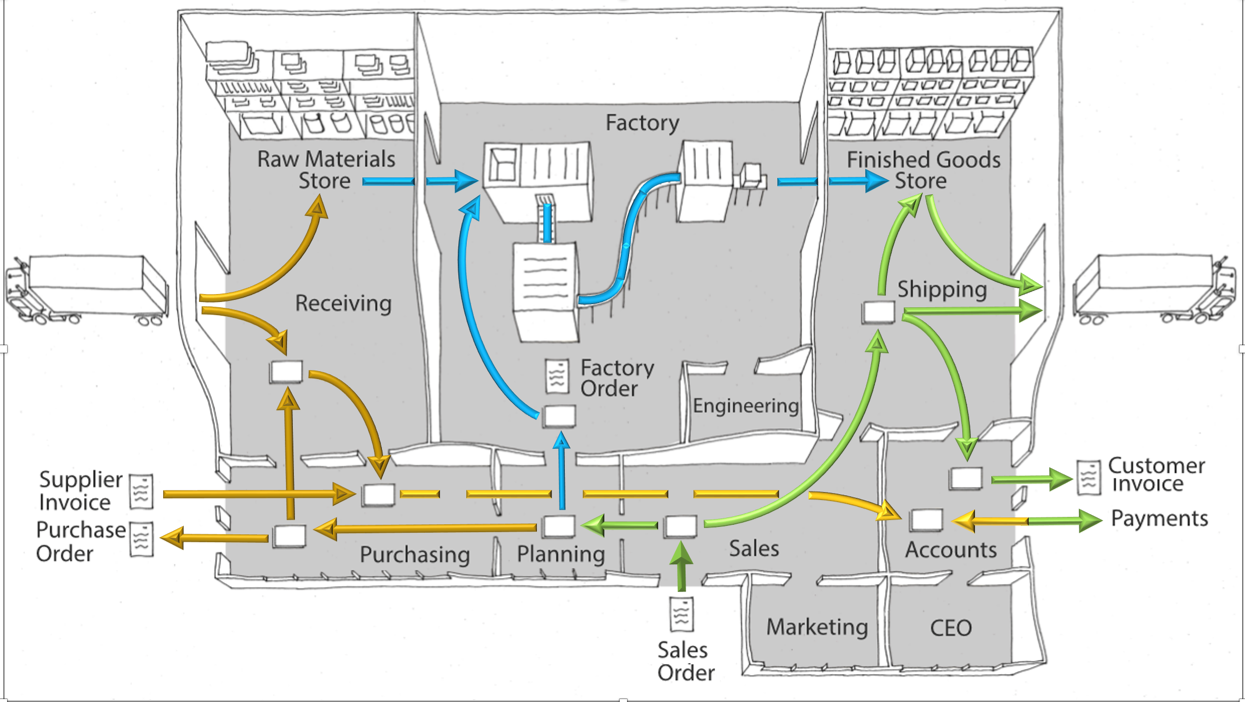
Digital Process Representation
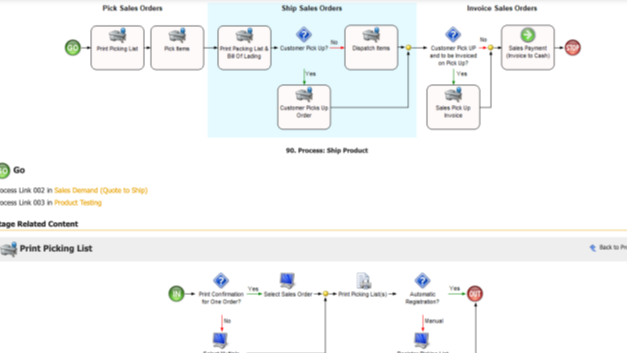
– TEXT AND IMAGES WITHIN DIAGRAM ARE TOO SMALL AND BLURRED
Process change is at the core of most change programmes; in change management terms, this covers process analysis, process improvement and process automation. We review process structure and performance from an end-to-end perspective. as part of the Operating Model. This model uses a hierarchical parent-child approach which breaks down processes into five levels. The top 3 levels relate to ‘what’ the company does, and the bottom two ‘how’ the company performs those processes. The top three levels will therefore be related to the industry sector the company operates in and its relationship with customers and suppliers.
The bottom two levels are more transactional and influenced by business rules, departmental structures, process evolution, and systems support. They are still end-to-end and therefore require a cross-functional analysis approach, achieved through workshops, large brown paper sheets and post-it notes. There are several drawbacks to this approach,
• Finding internal spaces big enough for a workshop
• Finding a space that can be set up for both the workshop but also post-workshop documentation
• Post-It notes can lose their stickiness and drop off from the original backing.
• Data capture and discussion need to be done in a single shot
• Post-workshop documentation is usually a two-dimensional presentation using standard symbols; the addition of notes for business rules is difficult to manage
Technology has significantly impacted this work with collaborative tools such as online whiteboards and digital twinning tools. The former enable dispersed teams to operate as they are in one room, contribute outside core meetings and support voting on proposals. Digital twinning provides a dynamic representation that models the process and links other information, such as operating instructions and business rules to the relevant process. Adding attributes to process elements such as time to complete, lean value, and customer experience values supports in-depth analysis to remove waste and streamline.
Enabling the analysis process with trained internal staff is facilitated by technology through online courses and coaching.
Having identified opportunities to change, the second step is to define and implement an improvement. Through digital twinning, we can see the impact of changes in process performance, identifying automation opportunities, changing a job role and modifying any business rules or policy. Again trained staff can implement these changes and present the results to management.
The final piece of the process jigsaw is automation. This is entirely centred on technology; we will discuss four variations Robotic Process Automation RPA, Intelligent Process Automation IPA, Business Process Automation BPA and Hyperautomation. RPA addresses the need for automation to remove human interaction and reduce errors. For example
• Repetitive tasks such as entering web orders from Customers
• Processes that can be completed with structured digital data, such as issuing statements or bills on a particular date
• Apply business rules such as stock management to ensure that purchasing actions are recommended when a certain stock level is reached or sales orders are held if the customer’s credit limit is breached
• Reducing transcription errors generated when data is entered twice
• Implementing time-sensitive actions such as seasonal discounts or insurance renewals
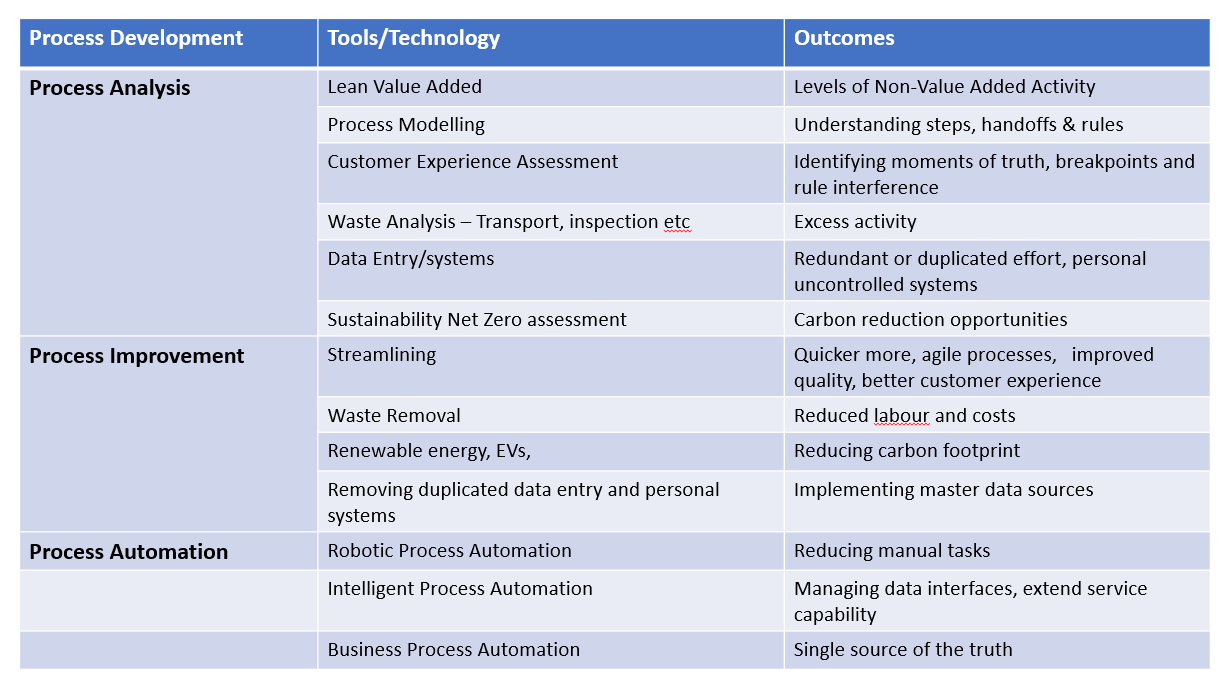
Some typical applications are in Customer Service with e-signature verification, uploading scanned documents and verifying information for approvals or rejections; in finance, it is used for payable transactions that satisfy terms and conditions, statements, and the opening and closing of sub-ledgers; in HR onboarding and offboarding from completions, recruitment forms, compliance reminders and time management and finally in the supply chain for inventory measurements, requisition raising and order processing, payment validation and order tracking against delivery dates.
Intelligent Process Automation is ideal for data extraction and document processes where clean data is unavailable, processes that are not rule-based and avoid some of the issues arising when implementing RPAs. For example, we can use it to upload machine-readable data from scanning, say, moving files and attachments on workflow paths and decision-making, opening emails and attachments, routing them, and making calculations. IPAs are ideal for classifying documents and then forwarding them onward; extracting data from hand-written or machine-printed forms with low resolution; validating data with external systems; modifying it to make it compatible with other systems; and routing data from external network systems to customers.
Business Process Automation BPA addresses the requirement to automate an end-to-end process, typically ERP. HRM and CRM are bundles of processes tackled this way. Change is fundamental to this level of transformation and will be the decisive activity between success and failure. Systems with this level of complexity will be designed and built on what is considered best practice, which will only sometimes be the situation in most companies. This will include data structures and management disciplines, process rules, and job role scope. If the process analysis and improvement have been conducted well, the level of change will be identified and can be matched to the system’s functional capability. Digital twinning and video-based operating tutorials are essential in this activity as will become conversational learning. Sometimes, the digital twinning process can lead to no-code developments for delivering a process.
BPA is the critical element in implementing servitisation and delivering more automation in customer service, be this a call centre or field service operations. In the former, we now regularly expect to see FAQs and Chatbots supporting initial queries before a call centre agent is required; multiple streams are available to present requests from email, SMS, phone, Photos, and videos. Whilst field service workers are scheduled on call once they complete the previous call, alternative operatives can be sent if the call runs late, and post-work completion surveys are always conducted. Van stock is monitored daily, and replacements are identified and forwarded to the operative’s home. All transactions, including work plans, safety instructions and material requirements, are provided through tablets or smartphones.
Hyperautomation is the process automation strategy that aims to rapidly identify and automate business processes using multiple tools, platforms, AI, machine learning RPA, Business Process Modelling, low and no-code solutions and BPA. This level of change will demand excellent change management and a clear strategic vision of how these tools will combine to define the future operating model.
In production areas, a similar process for analysis and implementation of change might be required to remove waste and improve quality. Technology impacts here will be through online training, videos for standard operating processes and process mapping to highlight areas of poor process and lack of compliance.
Completing the suite of change management components is benefit assessment and monitoring. Costing projects is an easy task compared to benefits as this does not need change to be enacted to spend money. Achieving a believable benefit statement that the business can buy into requires some financial rigour, understanding that change is an exact science, and we must also be able to assess and monitor qualitative benefits. In later sections, we discuss ways to tackle that using a technique that recognises benefits categories and the difficulty of implementation and provides a range of benefits targets which can then be applied to process measures, including staff satisfaction.
Technology enables these measurements to be taken quickly as part of reporting systems with performance measurement presentations allowing drilling into the actual data. Staff surveys can be embedded in intranets and taken at any time across the company or with a specific selection. Transactional data is stored as history in modern systems, so tracking errors and measuring productivity is simple.
With this level of management oversight, the communication needs to be very clear that the information is used to assess the impact of the technology and identify areas of further improvement, such as additional training or system configuration.
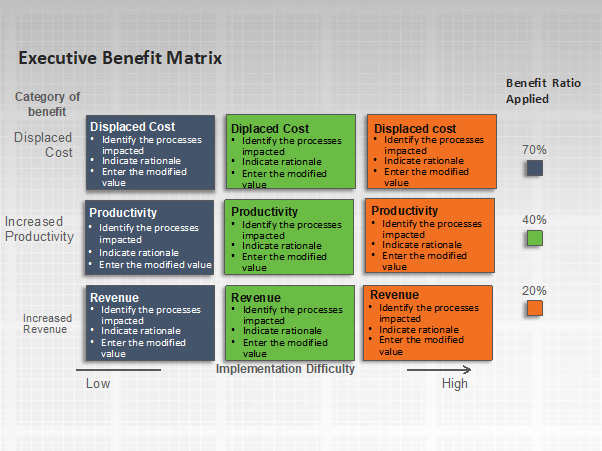
Change leaders can be more successful by using the correct blend of techniques and applying the following guiding principles with the appropriate technological support.
• Define clear goals and future vision.
• Make communication a core part of the implementation, ensuring it is always honest and transparent, encourages conversation and promotes a listening culture(40% of managers failed to understand the change.
• Train staff in new skills and provide opportunities to grow; always reassuring and empowering them to make decisions.
• Identify change leaders at all levels
• Provide detailed and easy-to-use documentation to encourage adoption.
There are several well-documented change models which will provide a framework for change. Choose from Kotler, ADKAR, McKinsey 7S, Kubler-Ross and Levin.

Case Study
Acrobat, Flash Player, and Photoshop are among the well-known products of Abode.
Due to new emerging technologies and challenges posed by small competitors, Adobe stopped selling its licensed goods in shrink-wrapped containers in 2011 and switched to offering digital services through the cloud. They allowed their customers to download the necessary software for free or subscribe to it every month rather than receive a CD in a box.
The human resource (HR) function also took on a new role, meaning employees had to adjust to new working practices. A standard administrative HR function was housed at Adobe’s offices. However, it was less suitable for the cloud-based strategy and performed well when Adobe was selling software items.
HR changed its role, became more human-centric and reduced its office-based functions.
The HR personnel did “walk-ins,” to see what assistance they might offer, rather than waiting for calls. With a focus on innovation, change, and personal growth, Adobe employed a sizable percentage of millennials.
Instead of having an annual review, staff members can now use the new “check-in” method to assess and define their growth goals whenever necessary, with quick and continuous feedback.
Managers might receive constructive criticism from HR through the workshops they conduct. The least number of employees have left since this changed approach of HR.

Case Study
Intuit provides financial software solutions with three products: Quicken, TurboTax, and QuickBooks, which have respective market shares of 73 per cent, 81 per cent, and 84 per cent.
Many observers believed Intuit could have made more money despite this market domination.
Additionally, the business was known for making decisions slowly, which let rivals take advantage of numerous market opportunities.
In identifying change, the CEO spoke with each of the top 200 executives, visited most of Intuit’s offices, and addressed most of its 5,000 employees.
He concluded that although employees were enthusiastic about the company’s products, internal processes weren’t given any thought (based on Higgins, 2005).
He followed the Mckinsey model to transform the organisation. In summary:
• By making acquisitions, he increased the products range for Intuit.
• Established a flatter organisational structure and decentralised decision-making, giving business units more authority and accountability throughout product creation and distribution.
• The rewards system was more aligned with strategic goals to accomplish strategic goals.
• Emphasised the necessity of a performance-oriented focus, offered a vision for change, and made every effort to sell that vision.
• Acknowledged staff’s commitment to Intuit’s products and further strengthened the process by emphasising his team’s quality and efficiency.
• Resources were allotted for learning and development, and certain selected managers were recruited from GE in particular skill categories, all to enhance staff capabilities concerning productivity and efficiency.
The strategy was “vision-driven” and was regularly communicated by the CEO to his team with their goals.
These changes led to a 40–50% rise in operating profits in 2002 and 2003.

Case Study
The financial services industry suffered heavily during the mortgage crisis in 2008. In addition to significant losses, the sector also had to deal with strict and aggressive regulations of their investing activities.
To expand its business, more employees were hired by Barclays Capital under the leadership of its former chief executive, Bob Diamond, who wanted to make it the most significant investment bank in the world.
But Barclays Capital staff was found manipulating the London Inter-Bank Offered Rate (LIBOR), and Barclays was fined £290 million, and as a result, the bank’s chairman, CEO, and COO had to resign.
An internal review found that the mindset of “win at all costs” needed to be changed, so a new strategy was necessary due to the reputational damage done by the LIBOR affair and new regulatory restrictions.
In 2012, Antony Jenkins became the new CEO. He made the following changes in 2014, which led to an increase of 8% in share price.
Aspirations
The word “Capital” was removed from the firm name, which became just Barclays. To concentrate on the U.S. and UK markets, on Africa, and on a small number of Asian clients, the “world leader” goal was dropped.
Business model
Barclays would no longer trade physical commodities and obscure “derivative” products. It was decided that the business would invest its own rather than using its customers’ money.
Only thirty per cent of the bank’s profits came from investment banking. Instead of concentrating on lending at high risk, the focus was on a smaller range of customers.
Culture
Instead of an aggressive, short-term growth strategy that rewarded commercial drive and success and fostered a culture of fear of not meeting targets, “customer first,” clarity, and openness took precedence. Investment bankers’ remuneration was also reduced.
Downsizing
In 2014, branches were shut, and 19,000 jobs were lost over three years, including 7,000 investment banking employees, personnel at high-street firms, and many in New York and London headquarters. £1.7 billion in costs were reduced in 2014.
Technology
There was an increase in customers’ online or mobile banking and increased automation of transactions to lower expenses. To assist customers in using new computer systems, 30 fully automated branches were established by 2014, replacing the 6,500 cashiers lost to this change with “digital eagles” who used iPads.
These changes were made to build a more vital, integrated, leaner, and streamlined organisation, leading to a higher return on equity and better returns for shareholders. This was also done to rebuild the bank’s credibility and win back the trust of its clients.

Case Study
The first digital camera and the first-megapixel camera were both created by Kodak in 1975 and 1986, respectively.
Why, then, did Kodak declare bankruptcy in 2012?
When this new technology came out in 1975, it was expensive and needed better-quality images. Kodak anticipated that it would be at least ten years until digital technology started to threaten their long-standing business of camera, film, chemical, and photo-printing paper industries.
Although that prediction came true, Kodak chose to increase the film’s quality through ongoing advances rather than embracing change and working on digital technology.
Kodak continued with the old business model and captured the market with 90% of the film and 85% of the cameras sold in America in 1976. With $16 billion in annual sales at its peak, Kodak’s profits in 1999 were around $2.5 billion. This success boosted the brand’s confidence, but there was complete complacency in embracing new technology.
Kodak started experiencing losses in 2011 as revenues dropped to $6.2 billion.
Fuji, a competitor of Kodak, identified the same threat and decided to transition to digital while making the most money possible from film and creating new commercial ventures, such as cosmetics based on chemicals used in film processing.
Even though both businesses had the same information, they made different judgments, and Kodak was reluctant to respond. And when it started to switch towards digital technology, mobile phones with in-built digital cameras arrived to disrupt digital cameras.
Although Kodak developed the technology, they needed to be made aware of how revolutionary digitalisation would prove to be, rendering their long-standing industry obsolete.

Case Study
Warren Buffett’s Berkshire Hathaway and the Brazilian private equity business 3G Capital paid $29 billion in 2013 to acquire Heinz, the renowned food manufacturer with $11.6 billion in yearly sales.
The modifications were made right away by the new owners. Eleven of the top twelve executives were replaced, 600 employees were let go, corporate planes were sold, personal offices were eliminated, and executives were required to stay at Holiday Inn hotel rather than the Ritz-Carlton when travelling and substantially longer work hours were anticipated.
Each employee was given a monthly copy restriction of 200 by micromanagement, and printer usage was recorded. Only 100 business cards were permitted each year for executives.
Numerous Heinz workers spoke of “an insular management style” where only a small inner circle knows what is happening.
On the other side, 3G had a young team of executives, mainly from Brazil, who moved from company to company as instructed across nations and industries. They were loyal to 3G, not Heinz, and were motivated to perform well to earn bonuses or stock options.
“The 3G way,” a theory that 3G has applied to bring about change in prior acquisitions like Burger King, was the driving reason behind these modifications. Everything was measured, efficiency was paramount, and “nonstrategic costs” were drastically reduced.
From this vantage point, “lean and mean” prevails, and human capital was not regarded as a crucial element of business success. It was believed that employees were motivated by the financial gains associated with holding company stock rather than being driven by a feeling of purpose or mission
Because it had been well-received by the 3G partners, those whom a deal might impact frequently saw a “how to” guide published by consultant Bob Fifer as a “must read.”
However, many food industry experts felt that while some of 3G’s prior acquisitions would have been ideal candidates for a cost-cutting program, Heinz was not the most appropriate choice to “hack and slash.” The company had already undergone several years of improved efficiency, and it was already a well-established player in the market.

Exercise
Post-it Notes, whiteboard
• Communication – how do we express the vision from a process, role and business rules perspective.
• What process KPIs might be applied.
• What training should be provided and how should it be delivered.
• What process documentation might be needed.

Course Manual 10: Technology Trends 2023
Leading into workshop 2, we review what the experts say will be the technologies that will emerge as key in 2023. We will examine how these might be applied to your strategy and what criteria you might use to support your decision-making.
Gartner has looked at technology trends from a strategic view selecting four Optimising which focus on business resilience, operational improvement and trust in information and data; Scaling through integration vertically through the supply chain or increasing capacity to deliver products; Pioneering improving customer engagement through better response times and thereby engagement opportunities and finally sustainable solutions.
The technology in optimising strategies would involve digital security and the ability to speed up responses. AI is at the centre of this drive, designed into robust and resilient systems that mitigate operational and security risks.
Scaling technologies include industry Cloud Platforms, which utilise tailored combinations of SaaS, PaaS and IaaS to support disruptive solutions and business models. Platform engineering is the technology that bundles a set of tools, capabilities and processes to improve end-users productivity. Improving the value generated by wireless networks with real-time information on location and usage to enable network energy to be harvested directly
Pioneering focuses on business model change, particularly employee and customer engagement. An example is the blending of technologies, such as apps, platforms and an ecosystem, to enable the development of third-party apps; or the provision of a complete service, an example being combining e-learning LMS with collaborative forums and online mentoring. AI will also be fundamental in implementing this strategy, with continuous learning and adjustment of the model in real time. The third element Gartner suggest is the increased use of Immersive technologies, AR and VR.
Sustainability should be a core part of all business strategies by using technology in data collection and analysis to improve decision-making on sustainable goals regarding energy usage, waste recycling and pollution.
Artificial Intelligence
Artificial Intelligence has already made an impact in 2023, with the doomsayers predicting the end of humankind and several leading technology players and scientists stating that the level of controls on development is not robust enough and we need to apply the ‘brake’.
Indeed, the advent of ChatGPT and numerous easy-to-use software tools have produced examples of poor governance; as in the case of a recent legal case in the US where AI had undertaken the para-legal work and as part of the defence lawyers’s submission had created precedent cases which were fictitious which the lawyers then presented as real.
The internet has spawned an explosion in fake news, and by adding AI capability across not just words but also images, the level of reality has increased a couple of notches.
AI TRISM supports the governance of AI models across subjects such as fairness, trustworthiness, robustness, and data protection. It blends several models for deployment, AI security, privacy and ethics.

AI’s power is now being exploited with no-code applications created through a drag-and-drop interface, enabling companies to develop more intelligent products and services. In retail, AI is being applied in various situations to augment the staff role, for example, in recommending cloths and garments to suit skin colour and boy shape. Supporting tasks in inventory management, complementing the role played by bar codes and hand-held readers in managing stock within and across locations. AI will make more complex inventory transactions such as buy-online-pickup-at-curbside (BOPAC), buy-online-pickup-in-store (BOPIS) and buy-online-return-in-store (BORIS)
Generative AI uses neural networks to create new content or interpret complex signals; from the machinery, for example, to support predictive maintenance. Or they are improving cyber-security analytics, or bringing forward new ideas for drugs or medical diagnosis.
According to a recent survey, AI is the highest net new investment, with 65% of companies having invested in some AI; further investment this year is topped by 9% AI investment, followed by 5% for data lakes and 5% for data mesh. The critical applications for AI are business analytics or intelligence, automating repetitive low-level tasks, identifying risks and improving digital security. AI can convert unstructured data, data outside databases and spreadsheets, communications, images and presentations, and make it usable for analytics. It can be the base data for training Robotic Process Automation projects and, for example, developing marketing materials to support a campaign.
There are situations where AI can be used to create synthetic data; in the case of sensitive patient data, we can use synthetic data to train an AI algorithm to understand MRI scans. This same approach is applied to self-driving cars.
All this capability requires robust governance and a recognition that all real-world data has an element of bias, so, for ethical reasons, we must be careful before releasing outputs for AI. A simple example is that AI developed some stereotypes for males and females, which identified the female gender as nurses and the male gender as builders.
AI has an excellent commercial rationale by augmenting work, reducing by automating low-level tasks, speeding up new product/service development and, thereby, faster revenue streams.
Key areas for growth for AI are speech recognition, fraud detection using a person’s mouse movements of device/network attachment and low-code software development.
The recommendations for this year are
• Look for opportunities to augment your workflows.
• Review all your unstructured data and define a set that would be suitable for a development project.
• Define any areas, such as quality control, where synthetic data might be applicable.
• Experiment with generative AI tools and develop a centre of excellence for AI within your business.
Immersive Internet experience
This technology is based on the concept of a digital world operating in parallel with the real world. Several technologies will come together to make the internet less two-dimensional. Augmented Reality AR and Virtual Reality VR are two technologies that will support developments in education, training as well as business meetings. Zoom and Microsoft have already combined collaboration tools like internet-based whiteboards and online meetings.
A survey stated that 65% of companies plan to use VR in a collaborative environment, and 25% plan to undertake a Proof of Concept. The trend is more towards AR, and the industries in the vanguard include media, information, telecoms and technology. Hybrid working has become the norm and the effect of Zoom fatigue, constant video conferencing, and the difficulty of organising effective hybrid meetings needed a solution. Hybrid meetings have a mix of live and remote attendees, and not all are treated equally; remote attendees appear to have less influence. The use of avatars by all attendees in a virtual space, even within an office environment, puts everyone on the same footing.
Eventually, these technologies will be melded into a single collaboration platform. Avatar developments will include more realistic facsimiles of ourselves with the ability to replicate movements and gestures. They can represent us even when we are not present in the digital world.
In the business process space, AR and VR technologies have already been applied in areas such as machine maintenance, mechanical handling and now fire-fighting scenarios. In the maintenance field this enables local staff to interact with an expert to maintain complex machinery, with walk-throughs of the process, recorded maintenance sessions, and digital models. This makes the expert more productive by reducing travel time significantly.
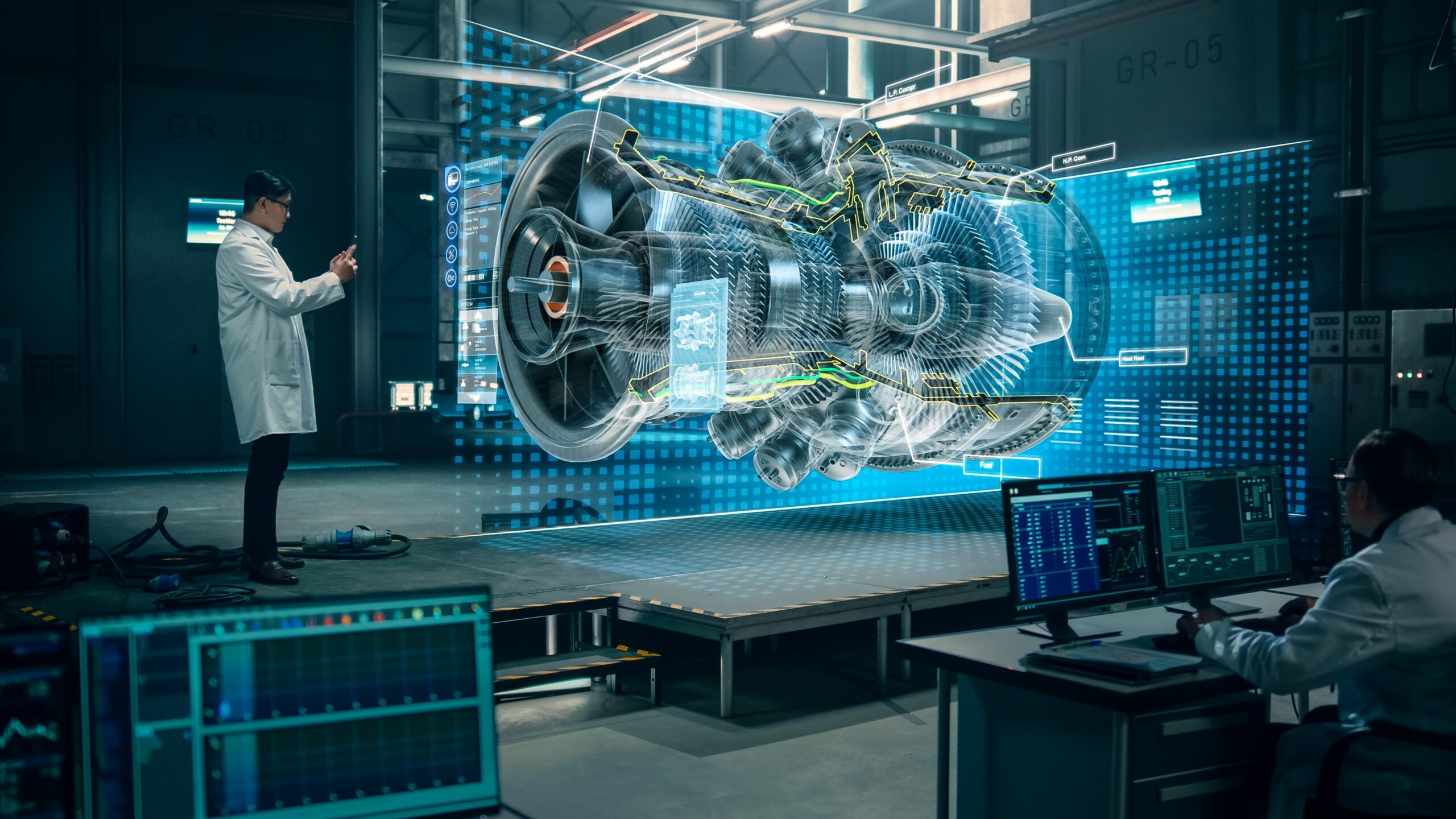
Though the uptake in the workplace has been slow, this technology has seen a boom in the entertainment industry, and some gaming platforms have extended their capability to enable users to build their own environments, such as Fortnite. They have been employed for years in flight and race car simulators. Some companies have extended this technology into onboarding staff, replicating office environments and situational analysis for health and safety, bribery, equality, and diversity.
Further developments include improving 3D images making them more photo-realistic; this is being tested by F1, hospitals, apparel designers and medical device manufacturers.
Overall, this technology will reduce the travel time of expert trainers, accelerate the design process and provide mental health benefits from the feeling of presence in meetings.
The surveys underlying recommendations are
• Watch and Wait.
• Understand the scope and benefits of digital twinning.
• Improve your video-conferencing experience.
Big Data, Data Models and Sustained Digital Processes
Implementing Big Data in the form of data lakes, data meshes, and the subsequent analytical and presentation technologies has enabled the creation of new business models in data. Examples from Netflix with watching recommendations, Amazon personalised search results, and Facebook behavioural advertising has projected these businesses to the top of data collection and analytic services that promote the brand and increase revenues.
This technology will improve as business and technology vendors work together to understand complex business models better. The initial design will have focused on volume, velocity, variety and veracity, whereas, now, the extra focus will be on the value that can be extracted from the data, related to cost savings and product/service enhancements.

Data Storage is cheap and easy to access from sources such as Google Drive, DropBox and SharePoint. Using AI to automate the data preparation and quality management aspects and improving the presentation of the data for easier interpretation. Real-time data can be more valued than historical by aggregating data across all your platforms.
New lines of business can emerge using data provision as a service. Also, embedding analytics into business processes can enable staff to use it more effectively in their daily tasks. Implementing data pipelines and applying AI to provide the agility to change as the business and data change makes the business more capable. Using natural language for conducting searches using speech recognition and better graphical representation. The growth of data-related developments in 2023 is predicted to be 19%.
The recommendations in this area are;
• Examining if your data can be developed into a service.
• Select a data partner who will be a good industry fit.
• Define a data development process that is scalable and guided by the business.
Digital transformation is a journey; only 20% of business processes were digitised in 2022, and the stated aim was to increase the value of high-level tasks undertaken by staff by automating repetitive tasks. 69% of businesses surveyed wanted to increase productivity without increasing headcount; 35% wanted to reduce headcount, proving that optimisation is the focus for automation.
The pandemic drove changes in business processes that have generated value through reworking the delivery of services, this value now needs to be embedded so that it is sustained permanently. A simple example is the drive using Business Process Automation towards a single source of the truth, this can enable process mining for data, related to how the process is being performed and thus creating a better performance measure. This will resonate with your strategic objective of getting more out of existing resources as talent is difficult to hire and the present economic situation. To improve back-office efficiency, there is a need to agree on the correct end-to-end process measures and establish the targets for KPIs; this should be based on the ability to process mine transactional logs in systems and subsequently manage the change required to the processes.
Zero-Trust Security
This describes moving from boundary-based security systems and open permissions to verifying users, assets and resources. The concept is based on three principles proposed by John Kindverg in 2019;
• No longer any distinction between a trusted and untrusted interface on a security device.
• No longer is there a trusted/untrusted network.
• No Longer is there a trusted/untrusted user.
We have seen an unprecedented level of cyber-attacks in recent years on public services and critical infrastructure and the use of ransomware. The conflict in Ukraine has shown the use of cyber in modern warfare.
In most businesses, it is difficult to understand the vulnerabilities across the whole supply chain, which might pose risks to your security.
This has given rise to Confidential Computing which is the encryption of data whilst in use as well as when in transit and at rest.
Recommendations are;
• Use Open-source frameworks and Tools.
• Use government resources.
• Make security a selling feature in service delivery.
• Assess the organisation’s capability to reach Zero-Trust.
• Develop a road map to reach Zero-Trust.
• Monitor existing attacks and breaches regularly.
• Have cyber a crucial part of your risk management process.
• Report to and engage with the board.
Web 3.0
Web 3.0 is the next generation of the web building on the two previous versions and has christened the Semantic Web. It does not exist yet but is based on the premise that everything will become decentralised and that people will gain control of their personal data.
Two key technologies dominate this space are Blockchain and Non-Fungible Tokens (NFTs). Blockchain will grow as part of the increasing decentralisation of computing from the cloud. Storing all data in the cloud is becoming less suitable due to energy consumption, the fact that large internet companies can access and monetise your data and the vulnerability of many people’s data to hacking.
Decentralising data storage into encrypted tokens will make it safer and drive more innovative ways to access and analyse it.
Technology has started to transform agricultural crop trading, for example. Providing a personal account requiring an electronic handshake to transfer information signed by both parties means that initial crop prices agreed at the farm gate cannot be tampered with and therefore undercut at any of the intermediate points along the supply chain.
NFT will be used to transform the experiences, such as attending events such as concerts and theatre enabling tickets to enable entrance to backstage or memorabilia. Future extensions of NFTS could be to represent contracts we enter with third parties. These tokenised digital assets provide both a secure trading method and digital asset protection from misuse or copying.
Digital twinning and 3D printing
Add the design process moved from the drawing board to the screen, and Computer-aided design began to mature, firstly providing machine code for driving machine tools, then analysis tools such as FMEA. It developed in 3-D idea of a digital model of the real world was envisaged. Much of this was made possible with screens that could display graphics and processors that managed graphical data.
Graphical capability grew exponentially as computer power and software developed to manage the 3D space. In design, most of the cost 60% + is spent before the prototype is completed, so reducing the number of iterations and errors before manufacturing parts and undertaking assembly impacted project timescales and costs. Speeding up innovation and enabling rationalising the number of component parts. In automotive design, this revolutionised chassis design and costs. The chassis is one of the most expensive major components alongside engines and transmission. Instead of designing a chassis for each model, automotive manufacturers could share chassis (now called platforms) across models and, in some cases within a group across brands. The body shape provides the brand image.
This approach of digital models was adopted in civil aerospace, making it easier to create different carrying capacities by parametrising the fuselage and then applying different seat permutations. Using ‘rendering’ of surfaces, the concept can represent the final finish and enable a fly-through of the cabin.
Digital technologies combined with mathematics have also transformed the design of industrial factories, particularly assembly lines and warehouses; this technology is called simulation. Theis models can show the operation of a line or warehouse and test the
• Size of storage areas
• Total cycle time
• Routing algorithms for robotic handlers
• Picking strategies
• Numbers of employees required to meet different demand patterns
The latest development of the digital model is the addition of 3D printing, where the model drives the deposition of material to create scale models of concepts, or in the case of additive manufacturing of component parts.
This has been transformative for new product design for disruptive ideas or radical departures from the original design, such as a plastic moulded chassis instead of a tubular metal one for a golf cart.
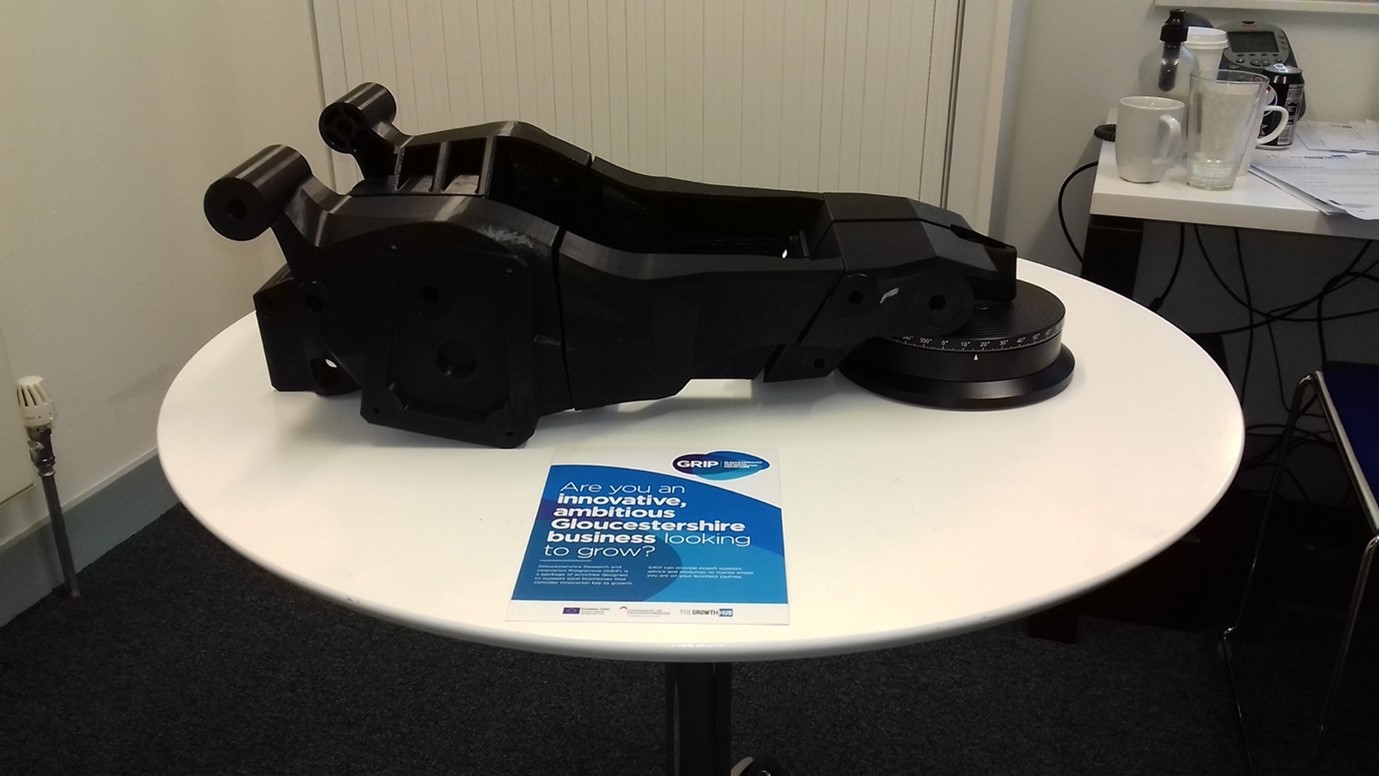
This methodology is making headway in the production of items on-site rather than transporting them from a factory. Construction items have been made this way in materials such as concrete.
Metal can also be deposited; therefore, for some aerospace parts manufactured in expensive material like Titanium, avoiding the cost of waste created by machining from a block of metal is favourable; plus, the final component is stronger with design features that cannot easily be machined.

Formula 1 design teams are the pinnacle using this technology, gathering weather, track temperature, and aerodynamic performance data from sensors during racing and practice to conduct design changes and implement them using additive manufacturing without tooling.
We have discussed the application of digital twinning in process modelling, enabling businesses to map and test new models before they implement and then use the subsequent model to hold all the process knowledge regarding timings, business rules, data structures, standards and compliance points. This single point of reference protects the knowledge asset from staff leaving and provides the platform for training and induction.
Robotics
Robotics will continue to develop both in terms of the more human interface on static robots or actual in terms of moving robots with human features and voices that can interact to voice commands.

Within workplaces, robots take more manual tasks from humans; many major logistics companies operating warehouses use robots to pick products linked with manually operated packing stations.
Good robotics applications have arisen since the pandemic in the healthcare industry. The COVID virus can be cleared from wards by using UV light. This cannot be applied manually, but a wheeled robot can do this efficiently and effectively, ensuring 100% coverage.
Autonomous Systems
Significant strides are predicted for autonomous systems, particularly in delivery and logistics. We have discussed the application of AI in enabling different delivery and return options and managing stock levels feeding these back to customer portals.
The Ocado autonomous system is platform-based, providing grocery retailers a fast way to implement it across their stock lines.
Self-Driving vehicles are now being tested, and this system is being promoted to replace drivers in trains, trams, ships and trucks.
Green Technology
This might appear as new technology, but humans have been trying to harness natural energy. For example, geothermal energy was used in Paleolithic times; wind energy was harnessed for moving goods in boats and operating machinery, and solar power was used to light fires. Even as recently as the turn of the 19th century, 90% of New York taxis were battery-driven.
Green technology covers both Clean technology which aims to improve the performance and efficiency of production whilst reducing the negative impact on the environment, and Climate technology, which aims to tackle human-induced climate change – namely greenhouse gases. Typical clean technology covers clean energy, wastewater and waste management.
The key technologies to look out for in 2023 will be.
Low Carbon Construction
Low-carbon buildings address the 38% of greenhouse emissions caused by traditional buildings. They produce little waste or pollution using eco-friendly materials such as bamboo or hemp. They require minimal heating and, if constructed with renewable energy sources such as solar panels, can reduce their carbon footprint to nearly zero.
Carbon Capture and Storage
Carbon offsets enable us to recognise our contribution to climate change but do not impact it enough. Capturing carbon from the atmosphere and processing it into synthetic fuel is an option. Very expensive presently, but a recent study suggests that this can be reduced by a factor of six, making this technology more commercially attractive.
Renewable Energy
Renewable energy supply will not meet the demand cycles, and therefore, the ability to store energy cheaply created from renewable sources is a crucial technology focus.
Hydrogen
Electric Vehicles are bine promoted to reduce CO2 emissions from fossil fuel-powered cars, buses and ships. These vehicles use batteries to store electricity and release it to drive electric motors, exhaust emissions are zero, but electricity itself is not a carbon-free process.
Promoted as the next propellant for vehicles is hydrogen, stored in fuel cells—the act of powering the vehicle results in water being the only emission. Progress on Green hydrogen, which produces close to zero greenhouse emissions, is in development by Shell and RWE, with a green pipeline from wind farms in the North Sea.
Upcycling(waste management)
Upcycling is turning waste into new usable materials or products; for example, reusing plastic waste into plastic pellets and making garden pots- or using an Anaerobic digestion plant heat and power output to drive the needs of greenhouses and land-based fish farms.
Quantum Computing
This is the next phase for computing using sub-atomic particles to enable faster storing and processing of information. Small-scale examples show that this technology can make computers capable of operating a trillion times faster than traditional processors.
Sustainability
This year public reporting of sustainability will be required for financial regulators in the UK, US and Canada, for example. In the UK and US, this is done through the IFRS standard. And in the EU through the Sustainability Reporting Standard. When surveyed on their reporting against ESG, 56% intended to report on Environment €, 45% on Governance (G) and 37% on societal (S). Less than 30% stated that they could accurately report on their carbon footprint even though the directive from the UN is to stop adding to the CO2 in the atmosphere by 2050, and there is investor pressure to show compliance.
Reporting data needs to be collected, and the whole impact of a business’s supply chain needs to be understood. This requires that the board are aware and engaged, so we can identify the gap in the data available and have a plan to mitigate it.
We have discussed the technologies your business can employ to address sustainability; a summary is provided below.
• Track your carbon footprint by recording the emissions your business is responsible for.
• Undertake a lifecycle analysis of the whole business.
• Implement activities that reduce the footprint, such as LED light bulbs, PIR light switches and EV delivery vehicles. Aim these at Scope 1 and 2 as defined by the Net Zero standard.
• Implement carbon offset measures for more intractable problems.
• Define how Zero Waste can be achieved within the business.
• Commit to ESG reporting to keep the management focused.
• Fund sustainable projects raised within the business.

Case Study
Preamble:
The University of Ottawa’s Common Law Section holds a moot competition for its students annually, requiring teams to prepare written submissions on a legal point and then argue their case before a panel of judges. It’s meant to simulate the feeling of being in a courtroom and is typically hosted in an actual courtroom. Pandemic restrictions made that impossible, and the competition was to be held using Zoom videoconference. Seeking to improve upon the virtual experience, they worked on a metaverse moot initiative.
Approach:
the students engaged Ireland-based ENGAGE XR to help create a virtual courtroom. Using the company’s virtual reality platform, an American courtroom was modified to suit the moot competition style of three judges and no jury. After initial Moot rounds were completed over Zoom, the finalists held their moot contest on the VR platform in March 2022. Participants were shipped Meta Quest 2 headsets to use for the experience. They uploaded photos of themselves to create avatars with their likeness. “It felt real; it felt like we were in a courtroom; no one thought we would ever do trials over Zoom until the pandemic happened. To me, that was a bandage approach to create some continuity. It wasn’t the be-all and end-all.”
An in-world videographer created a recording of the virtual event that was suitable to stream on YouTube.
Benefit:
There are plans to take a hybrid approach and still include a VR component. The aim is to introduce a new element that hasn’t previously been done in a trial every year. For example, they are looking at introducing a recreation of a crime scene to serve as evidence in a trial. “Can we virtually transport the judge and jury to the crime scene? ; They could walk around and see that scene virtually, with real evidence.”
Also of interest is to expand on open court principles, to allow the public access to trials taking place; some members of the public were invited to sit in the virtual gallery at this year’s moot competition.

Case Study
Preamble:
AI lab Midjourney launched its first product, an image-generating bot only accessible through Discord, to private beta in the first quarter of 2022. Like other AI-powered image generators like OpenAI’s DALL-E 2, it took any text prompt and produced an array of images. Midjourney’s illustrative aesthetic made it eye-catching, and it was soon featured on the June cover of The Economist.
While it was in private beta, the Midjourney team contacted established visual artists to invite them to try the tool. Among them is Rob Sheridan, an American graphic designer best known for his work with the Nine Inch Nails, producing album cover art and other ac- accessories for projects like Year Zero. In his first weekend of using Midjourney, Sheridan found himself in an existential crisis pondering what it meant for his role as an artist. “How can I have authorship in this process when a computer does the rendering?” he asked himself.
Sheridan responded by probing the limits of the AI image generator tool, testing the boundaries of where it would take his preferred genre of horror. After sharing some attention-getting results of his efforts on Twitter, Midjourney responded by banning terms like “body horror” from the platform. Sheridan disagrees with the censorship. “Art is not just about beauty; that’s not a unilateral thing,” he says.
“Beautiful is horror imagery to me. But it’s their platform, so they can decide.”
Approach:
Despite the disagreement, Sheridan moved on from his initial reaction to Midjourney and used it for a new project, Volstof Institute for Interdimensional Research. A graphic story told on Instagram and Twitter is a found materials narrative firmly in the horror genre, with visuals of dilapidated laboratories, tentacles, and skulls. As Sheridan began to appreciate the tool as he created more of the work. “I loved the flawed, messed-up aesthetic of it,” he says.
The project helped him come to terms with the implications of AI-generated imagery. He viewed the Volstof project as a collaboration between himself and the AI. He let the boundaries and parameters of Midjourney help guide his process and take the idea in new directions. The project has a modest following on social media but has been covered by the media, and some observers suggested the narrative would be fitting for a video game.
Sheridan also used Midjourney to produce elements for designs he sells on T-shirts and paraphernalia on his e-commerce store. While Sheridan doesn’t allow AI to design everything on a new t-shirt, he did use it to create some characters that he incorporated into the design. “It’s exciting, and I feel I can take some authorship of it,” he says. He points out that having the tool opened the door to him creating the designs on a whim, when otherwise he might not have invested time into following through on the idea.
Outcome:
Sheridan’s advice to other artists is to adapt to the new set of tools. Art directors should be excited because they can now prototype designs more quickly. “I can prototype some- thing like Volstof without having to hire a team of artists or investing the time it would take me to do it manually.”
He says that illustrators can use the new tools as an extension of their brains and eventually even train algorithms to mimic the style of their own work. He advises not to look at all the problems with the new technology and dismiss it or demonise it. Film photographers that reacted that way to digital photography and Photoshop were quickly pushed out of the market for the new standard that customers expected. While there will no doubt be problems to solve with Midjourney and other similar tools, it’s better to discuss how to solve those problems and work with technology providers. After all, in Sheridan’s view, the medium is not the message. “Having a good vision is more important than owning an expensive piece of equipment,” he says. Likewise, having a good vision will serve artists well as the unimaginative churn out volumes of banal imagery.

Case Study
Preamble:
Charlotte, NC-based chemicals producer Albemarle Corp. counts more than 5,900 employees and generates $3.3 billion in revenue. In stage two of a transformation strategy, the focus was on modernising from its on-premises SAP systems into a unified SAP S/4HANA cloud environment while avoiding unnecessary process customisations.
Across 5,000 global users, Albemarle could, use 95% of standard processes in the new platform with zero code modifications. It migrated from a legacy and multi-silo backend to a single platform in the cloud in a period of just 18 months. The technology project and change management were complete, and sustaining the transformation became the next goal.
In stage 3, the focus shifted to value realisation from operating on the new platform. That’s when Albemarle started considering using business process mining (BPM). This technique uses event data to show what people and machines are doing and when that veers from the desired process.
“We wanted to be able to check on our standard processes and stay on the standard path. Ultimately, our sustainability depends on if the users are following the processes.’’
Approach:
To pursue BPM, the CIO first created the accountability structure in his organisation. As the lead on enterprise business systems, he already had five directors reporting to him on SAP deployments across the organisation. After considering using a Centre of Excellence approach to focus on BPM, he decided instead to use the talents of the business systems analysts’ group. The digital technology manager started reporting directly to him. That position would be responsible for building up the BPM expertise in the group and eventually training other analysts on the competency.
Albemarle considered a couple of vendors in the space. The technology reads the change logs generated by SAP. From there, it can report on how employees took action to complete a specific process and in what order the steps were taken. The software can then check that execution against the agreed-upon process drawn on the whiteboard.
“What is our happy path? Is it the standard process that we thought it was? It’s about helping users follow the right process,”
Albemarle’s order-to-cash group was chosen to get started with the new tool, as it was not meeting some key performance indicators like on-time delivery and order confirmation dates.
Outcomes:
Digital process mining gained traction with the order-to-cash group by drilling down into the data and exploring why some suppliers needed to get order confirmations. Albemarle connected the problem back to the inventory that it had available to promise. In oversold situations, it is necessary to confirm orders against planned production. So to improve the process, a new planning project was implemented to integrate the different departments involved and allow order confirmations to be done more reliably.
The proof of concept with the tool was effective and was soon deployed to other areas of the business. For example, it examined its hiring process, which took three months to complete. Background checks took too long to complete, and Albemarle decided to change its vendor in that area.
BPM is helping make the new standards implemented during the company’s digital transformation effort more sustainable. “People that just want to get their job done tend to want to move away from the standard,” Managing against that urge is “a combination of change management and training.”

Case Study
Preamble:
Walmart’s corporate head office started its Re- generative Initiative in 2017. The goal is to be carbon negative by 2040, meaning it is reducing more emissions than it is creating. Walmart is working with the Science Based Targets Initiative to measure and reduce its emissions in three categories:
Scope 1:
Emissions directly created from Walmart’s buildings. Walmart is planning to start using low-impact refrigerants and to scale use of renewable energy.
Scope 2:
Emissions created from its fleet. Walmart purchased a fleet of Tesla trucks and is committed to a100% renewable energy fleet by2028.
Scope 3:
Supply chain emissions both upstream and downstream. Walmart’s Project Gigaton incentivises suppliers to report on reducing emissions and offers calculator tools to support them.
Approach:
With its corporate goals for ESG set, Walmart Canada is creating its plan to align with the strategic pillars and begin reporting on efforts made to curb carbon emissions. In IT, the challenge is to develop a baseline set of metrics for the impact of devices on overall carbon footprint.
Reporting on real-time data for each deployed device will be a challenge because of the variables. User behaviour and power supply source are just a couple of the metrics that must be considered.
After the emissions of operating devices are considered, the emissions of manufacturing the devices are still left to be considered. Walmart will have to work with its vendors to determine the impacts.
Outcomes:
Walmart Canada’s regenerative tech team is working to create a baseline set of metrics for handheld devices and PCs as a primary focus. Walmart will work with suppliers Dell and Zebra to understand the footprint of their devices. “I’m going to find out what I’m consuming when operating those devices.”
Wallace’s team will break down the data by region and domain once it’s compiled. Then her team will look at what measures can be put in place to reduce device emissions. For example, device power-saving policies could be put in place.

Exercise
• Post-it Notes, whiteboard
Project Studies
The key objective of the course is to develop a process for managing change driven by the implementation of technology. To do this, the course addresses the skills required for each process step and describes case studies of implementing that step with good and bad examples. We have broken the course into four phases, each covering several workshops that provide the skills and knowledge to complete that phase.
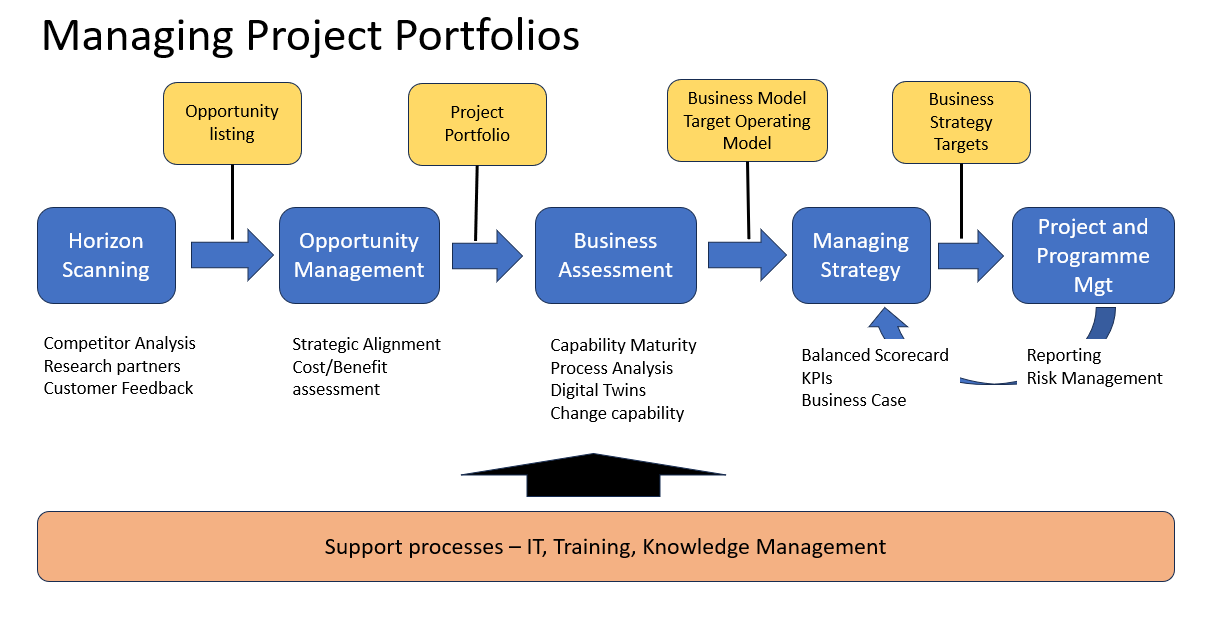
The project study will enable you to practically apply what you have learned in each workshop and build outputs within each phase that embed the process in your organisation.
The phases are;
• Phase 1 – workshops 1 to 4. During this phase, the target is to enable you to review the technological landscape related to your business, what business issue you believe needs to be tackled to satisfy customers, operations and sustainability.
• Phase 2 – workshops 5, 6 and 7. During this phase, we develop your skills in processes, including business process models, process analysis, process improvement and subsequent automation. Managing processes with appropriate measures and suitable targets. We are building the change agenda ready to support the technology and change plan creation.
• Phase 3 – workshops 8 to 10. During this phase, we are applying your new skills to define a technology project ready to be implemented. Covering key process steps such as technology selection, the business case and determining the KPIs
• Phase 4 – Workshops 11 and 12. During this phase, you will build and implement a project plan and demonstrate your leadership skills.
Table of phases 1-4 and outcomes
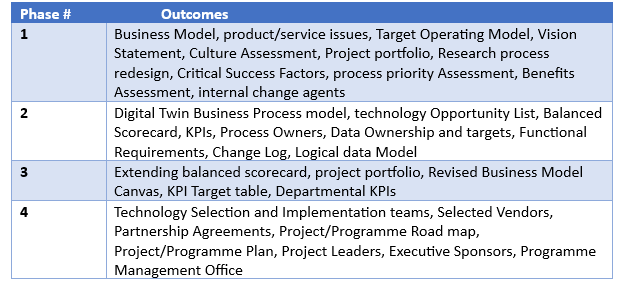
Reviewing what you need to do for project study in phase 1, we will tackle this workshop by workshop. Workshop 1 covers the background of technological development, how best to develop it and ensure its adoption by understanding your target customer, external or internal. The first steps are to identify the technologies that will form the backbone of a technology strategy, align these individual technological elements map them to the business model and customer value proposition, which will help define the target, operational processes, customer demands, competitive pressure or sustainability. Finally, the work should build your and your company’s attitude to technology adoption.
You must perform the following activities based on workshop 1 to do this work.
• Working alone, review the business model canvas (BMC) and complete it from your perspective. Then work with colleagues to compile a consensus version and add this to the Phase 1 workbook. When completing the BMC, ensure that your focus is on critical activities the company needs to perform, the relationship with partners, particularly those in the supply chain and the implications of sustainability and achieving net zero. Conduct extra research to support your thinking, referring to the Preliminary Analysis.
• Once you and your colleagues have established an agreed BMC, work together again to document the business issues you understand the company is facing from both the competition and customers. For the research on competition, pick the top three known to you and ensure that this list contains at least one new to the market and maybe a disruptor. Customer issues could be found in the complaints system or known to front-end sales staff and call centre agents. Document the combined findings in the phase workbook.
• The next step in the project study for this phase is to align the business issues with potential technology solutions. From the workshop, you will know that the technology areas most likely applicable will be digital to impact the business model. So look for opportunities for automation with AI, Big data (lakes and meshes), collaborative tools, Robotic Process Automation and servitisation.
• Finally, from workshop 1, revisit your responses to the personal and company attitude to technology adoption, set an agenda for change for both, and discuss and exchange with one of your colleagues.
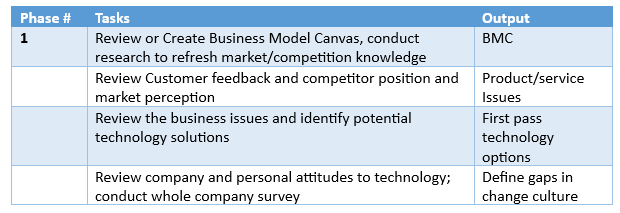
These outputs need to presented as part of the evaluation and assessment process prior to the next workshop.
Project Study (Part 1) – Customer Service
The Head of this Department is to provide a detailed report relating to the Technology Development process that has been implemented within their department, together with all key stakeholders, as a result of conducting this workshop, incorporating process: planning; development; implementation; management; and review. Your process should feature the following 12 parts:
01. Technology Development
02. Development Cycles
03. Technology Adoption
04. Society
05. The Planet
06. Sustainability
07. Business Transformation
08. Business Models
09. Change Management
10. Technology Trends 2023
Please include the results of the initial evaluation and assessment.
Project Study (Part 2) – E-Business
The Head of this Department is to provide a detailed report relating to the Technology Development process that has been implemented within their department, together with all key stakeholders, as a result of conducting this workshop, incorporating process: planning; development; implementation; management; and review. Your process should feature the following 12 parts:
01. Technology Development
02. Development Cycles
03. Technology Adoption
04. Society
05. The Planet
06. Sustainability
07. Business Transformation
08. Business Models
09. Change Management
10. Technology Trends 2023
Please include the results of the initial evaluation and assessment.
Project Study (Part 3) – Finance
The Head of this Department is to provide a detailed report relating to the Technology Development process that has been implemented within their department, together with all key stakeholders, as a result of conducting this workshop, incorporating process: planning; development; implementation; management; and review. Your process should feature the following 12 parts:
01. Technology Development
02. Development Cycles
03. Technology Adoption
04. Society
05. The Planet
06. Sustainability
07. Business Transformation
08. Business Models
09. Change Management
10. Technology Trends 2023
Please include the results of the initial evaluation and assessment.
Project Study (Part 4) – Globalization
The Head of this Department is to provide a detailed report relating to the Technology Development process that has been implemented within their department, together with all key stakeholders, as a result of conducting this workshop, incorporating process: planning; development; implementation; management; and review. Your process should feature the following 12 parts:
01. Technology Development
02. Development Cycles
03. Technology Adoption
04. Society
05. The Planet
06. Sustainability
07. Business Transformation
08. Business Models
09. Change Management
10. Technology Trends 2023
Please include the results of the initial evaluation and assessment.
Project Study (Part 5) – Human Resources
The Head of this Department is to provide a detailed report relating to the Technology Development process that has been implemented within their department, together with all key stakeholders, as a result of conducting this workshop, incorporating process: planning; development; implementation; management; and review. Your process should feature the following 12 parts:
01. Technology Development
02. Development Cycles
03. Technology Adoption
04. Society
05. The Planet
06. Sustainability
07. Business Transformation
08. Business Models
09. Change Management
10. Technology Trends 2023
Please include the results of the initial evaluation and assessment.
Project Study (Part 6) – Information Technology
The Head of this Department is to provide a detailed report relating to the Technology Development process that has been implemented within their department, together with all key stakeholders, as a result of conducting this workshop, incorporating process: planning; development; implementation; management; and review. Your process should feature the following 12 parts:
01. Technology Development
02. Development Cycles
03. Technology Adoption
04. Society
05. The Planet
06. Sustainability
07. Business Transformation
08. Business Models
09. Change Management
10. Technology Trends 2023
Please include the results of the initial evaluation and assessment.
Project Study (Part 7) – Legal
The Head of this Department is to provide a detailed report relating to the Technology Development process that has been implemented within their department, together with all key stakeholders, as a result of conducting this workshop, incorporating process: planning; development; implementation; management; and review. Your process should feature the following 12 parts:
01. Technology Development
02. Development Cycles
03. Technology Adoption
04. Society
05. The Planet
06. Sustainability
07. Business Transformation
08. Business Models
09. Change Management
10. Technology Trends 2023
Please include the results of the initial evaluation and assessment.
Project Study (Part 8) – Management
The Head of this Department is to provide a detailed report relating to the Technology Development process that has been implemented within their department, together with all key stakeholders, as a result of conducting this workshop, incorporating process: planning; development; implementation; management; and review. Your process should feature the following 12 parts:
01. Technology Development
02. Development Cycles
03. Technology Adoption
04. Society
05. The Planet
06. Sustainability
07. Business Transformation
08. Business Models
09. Change Management
10. Technology Trends 2023
Please include the results of the initial evaluation and assessment.

Project Study (Part 9) – Marketing
The Head of this Department is to provide a detailed report relating to the Technology Development process that has been implemented within their department, together with all key stakeholders, as a result of conducting this workshop, incorporating process: planning; development; implementation; management; and review. Your process should feature the following 12 parts:
01. Technology Development
02. Development Cycles
03. Technology Adoption
04. Society
05. The Planet
06. Sustainability
07. Business Transformation
08. Business Models
09. Change Management
10. Technology Trends 2023
Please include the results of the initial evaluation and assessment.

Project Study (Part 10) – Production
The Head of this Department is to provide a detailed report relating to the Technology Development process that has been implemented within their department, together with all key stakeholders, as a result of conducting this workshop, incorporating process: planning; development; implementation; management; and review. Your process should feature the following 12 parts:
01. Technology Development
02. Development Cycles
03. Technology Adoption
04. Society
05. The Planet
06. Sustainability
07. Business Transformation
08. Business Models
09. Change Management
10. Technology Trends 2023
Please include the results of the initial evaluation and assessment.

Project Study (Part 11) – Logistics
The Head of this Department is to provide a detailed report relating to the Technology Development process that has been implemented within their department, together with all key stakeholders, as a result of conducting this workshop, incorporating process: planning; development; implementation; management; and review. Your process should feature the following 12 parts:
01. Technology Development
02. Development Cycles
03. Technology Adoption
04. Society
05. The Planet
06. Sustainability
07. Business Transformation
08. Business Models
09. Change Management
10. Technology Trends 2023
Please include the results of the initial evaluation and assessment.

Project Study (Part 12) – Education
The Head of this Department is to provide a detailed report relating to the Technology Development process that has been implemented within their department, together with all key stakeholders, as a result of conducting this workshop, incorporating process: planning; development; implementation; management; and review. Your process should feature the following 12 parts:
01. Technology Development
02. Development Cycles
03. Technology Adoption
04. Society
05. The Planet
06. Sustainability
07. Business Transformation
08. Business Models
09. Change Management
10. Technology Trends 2023
Please include the results of the initial evaluation and assessment.
Program Benefits
Management
- Strategic evaluation
- Analytical capability
- Decision toolkits
- Scenario thinking
- Change agency
- Problem-solving culture
- Empowered leadership
- Benefits realisation
- Quantifiable risks
- Sustainability focus
Information Technology
- Digital delivery
- Strategic alignment
- Task automation
- Project management
- Vendor integration
- Business ownership
- Functionality focus
- Controlled implementation
- Technology suitability
- Vendor matching
Operations
- Operational alignment
- Process improvement
- Streamlining operations
- Change capability
- Business models
- Digital attitude
- Leveraged advantage
- End-to-end processing
- KPI implementation
- Reducing costs
Client Telephone Conference (CTC)
If you have any questions or if you would like to arrange a Client Telephone Conference (CTC) to discuss this particular Unique Consulting Service Proposition (UCSP) in more detail, please CLICK HERE.









